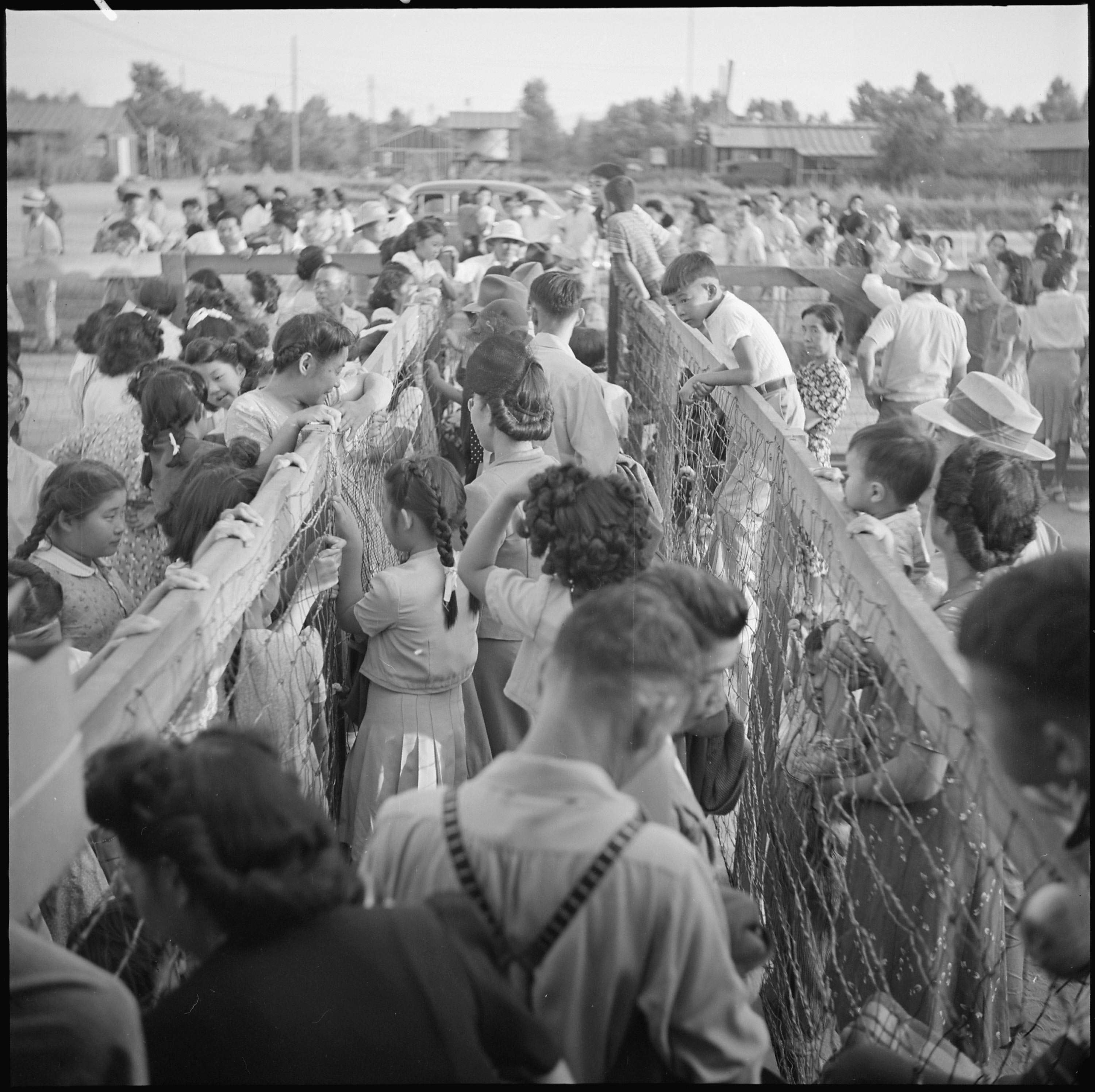Japanese American Incarceration During World War II
Making Connections
All documents and text associated with this activity are printed below, followed by a worksheet for student responses.Introduction
On February 19, 1942, two months after the United States officially entered World War II, President Franklin Roosevelt issued Executive Order 9066. It authorized the Secretary of War and military commanders to create military areas on the West Coast and exclude "any or all persons" from those areas. The entire West Coast was deemed a military area and was divided into military zones.Although FDR's order didn't specify any ethnic group, this resulted in the forced evacuation and incarceration of Japanese Americans from the West Coast to "relocation centers" (also referred to as "internment camps") further inland for nearly four years.
Look closely at the documents and photographs below. The first is Executive Order 9066. Respond to the prompts within the activity, and think about the following big questions as you go:
- Why did enforcement target Japanese Americans?
- How were they denied their civil liberties?
For each document, click on View Document Details to see it more closely and learn more.
Name:
Class:
Class:
Worksheet
Japanese American Incarceration During World War II
Making Connections
Examine the documents and text included in this activity. Fill in any blanks in the sequence with your thoughts and write your conclusion response in the space provided.Executive Order 9066 dated February 19, 1942, in which President Franklin D. Roosevelt Authorizes the Secretary of War to Prescribe Military Areas
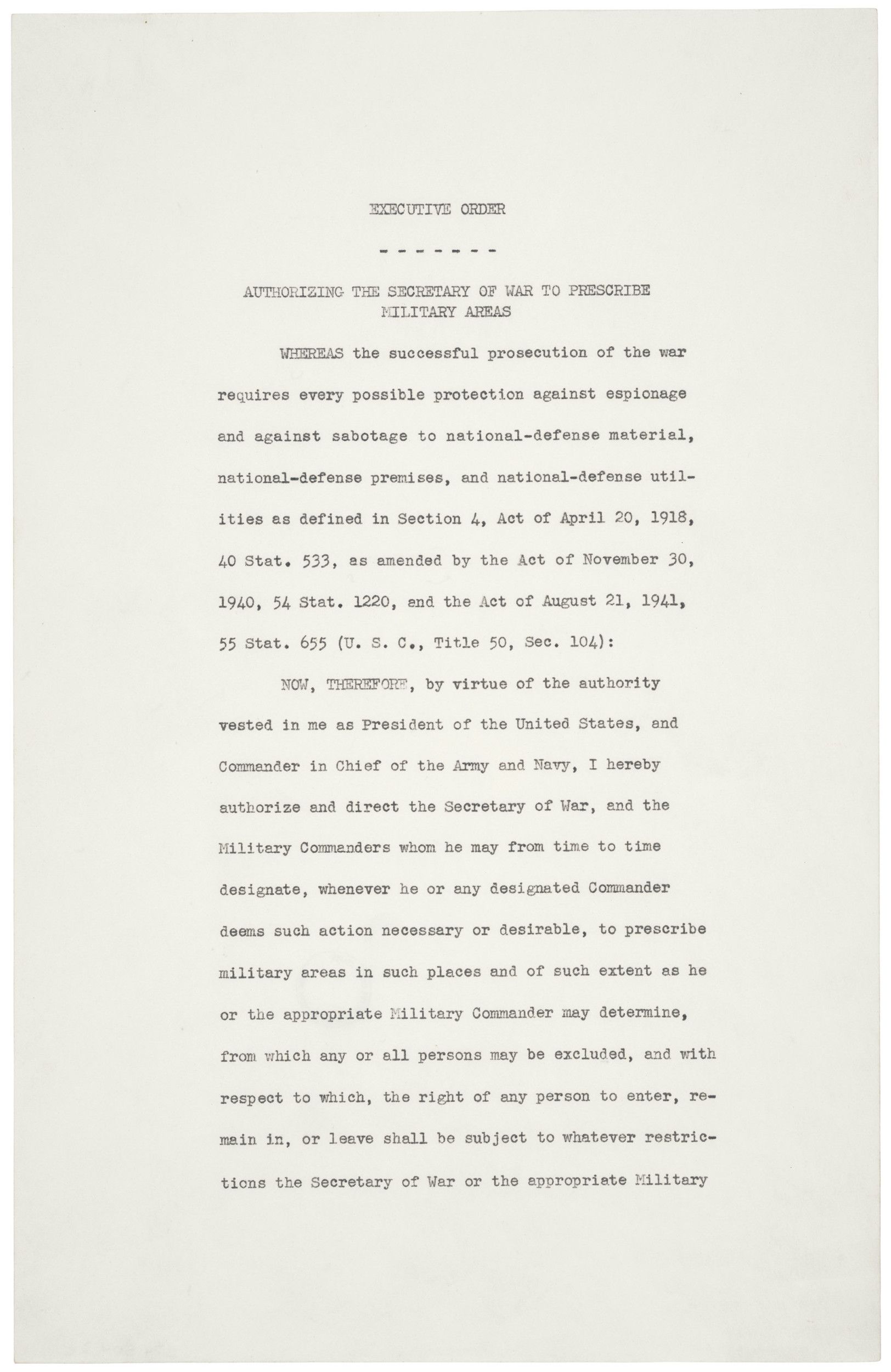
Before the outbreak of World War II, the FBI started surveilling German, Italian, and Japanese "aliens" (the word the government used for people in the United States who were born in another country and weren't U.S. citizens) who they suspected of being potential "enemy agents" spying on the United States. After Japan attacked the U.S. naval base at Pearl Harbor, Hawaii, on December 7, 1941, government suspicion arose around all persons of Japanese descent, whether born in Japan (called issei) or American citizens born in the United States (nisei).
Look closely at the next few documents, then in the blank box that follows, answer: What clues did you find as to why the government specifically targeted Japanese Americans? Did anyone disagree with these reasons?
Look closely at the next few documents, then in the blank box that follows, answer: What clues did you find as to why the government specifically targeted Japanese Americans? Did anyone disagree with these reasons?
Transcript of Telephone Conversation between Secretary of the Treasury Henry Morgenthau, Jr. and President Franklin D. Roosevelt
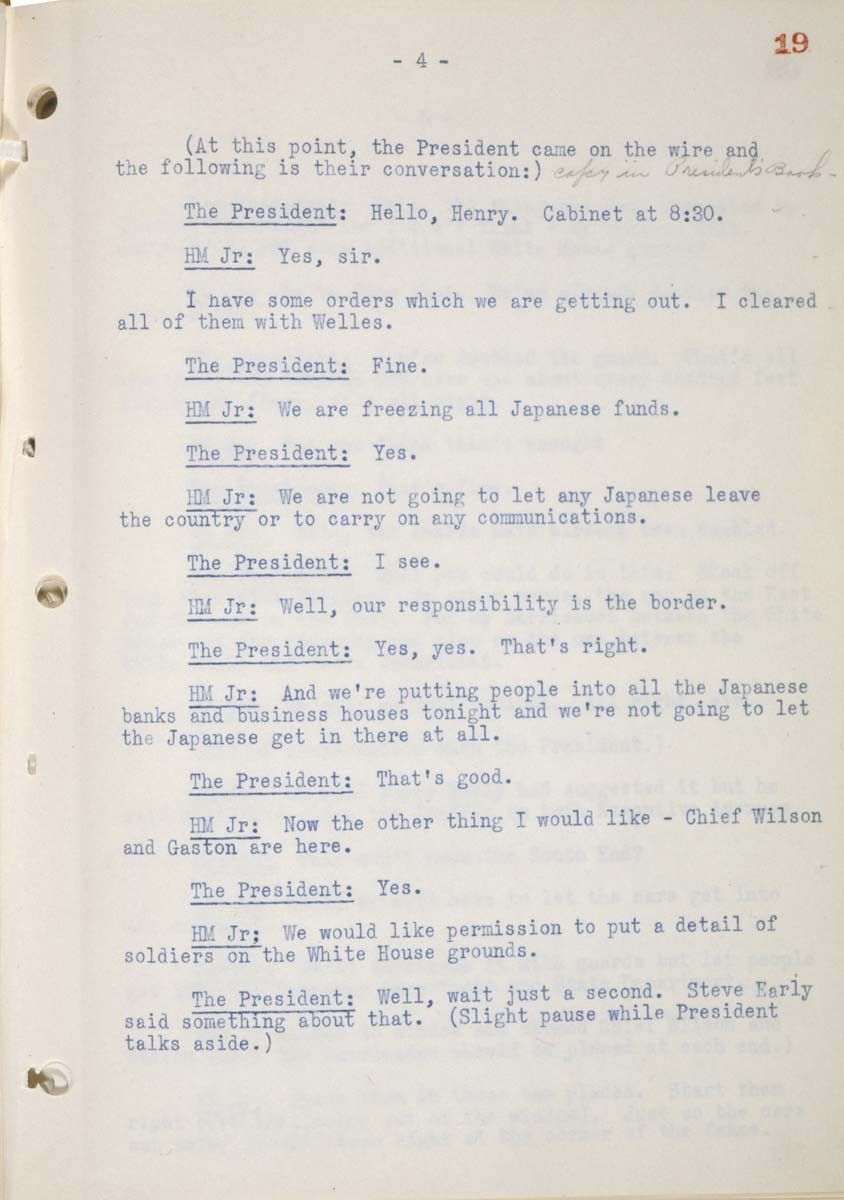
Letter to Mr. Paul T. Bannai, Executive Director of the Commission on Wartime Relocation and Internment of Civilians, from John McCloy
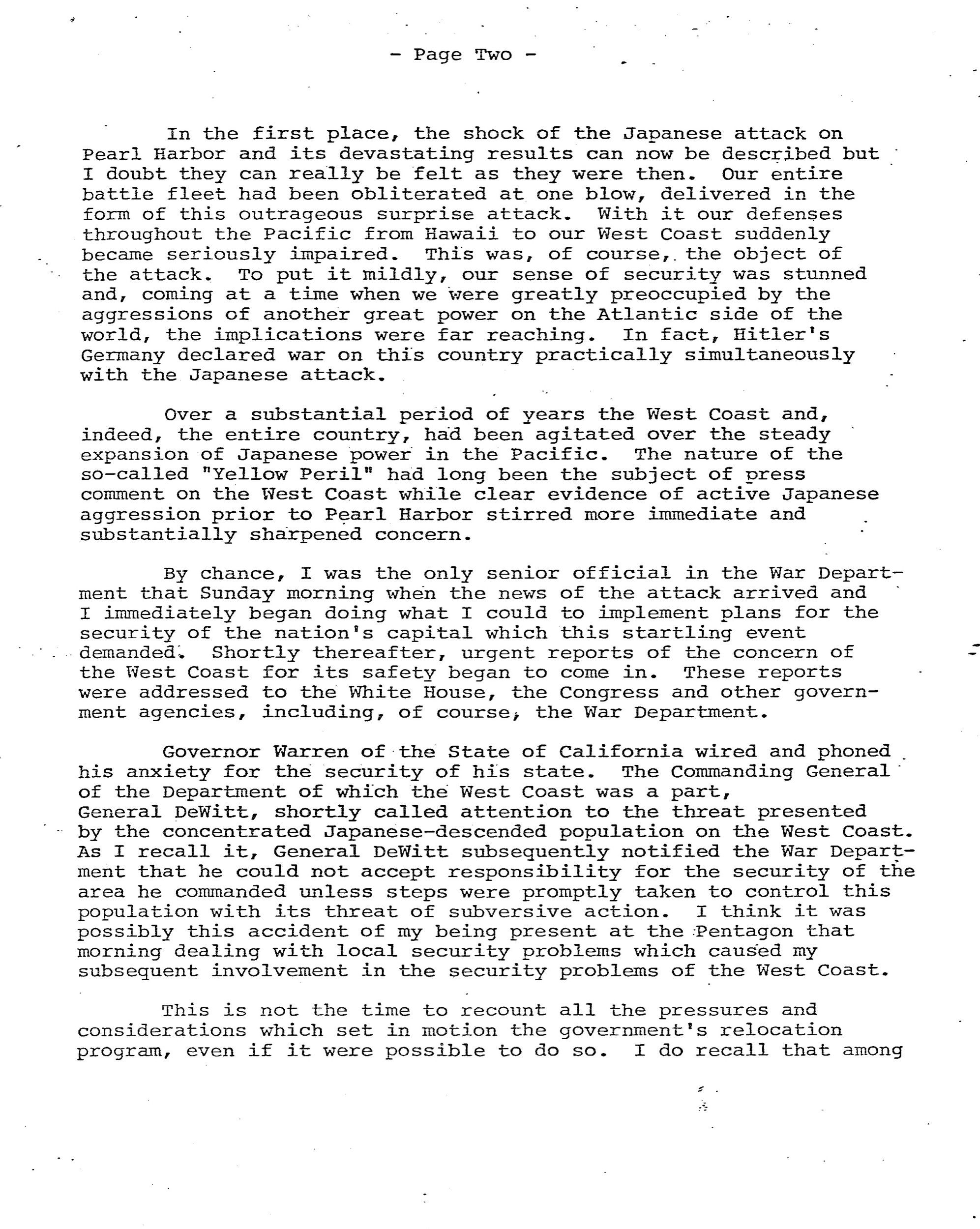
Exhibit L: Copy of "Conference with General De Witt"
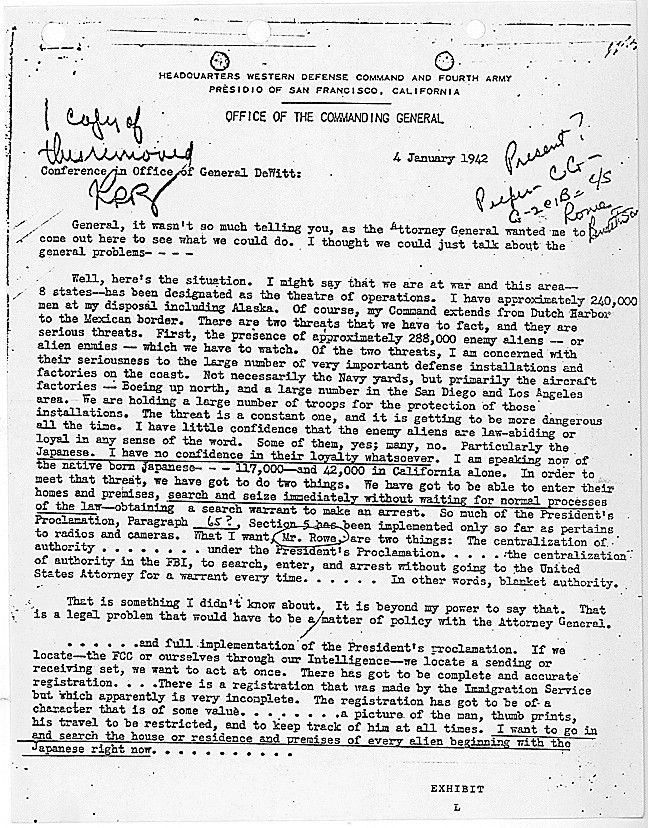
Final Report: Japanese Evacuation from the West Coast
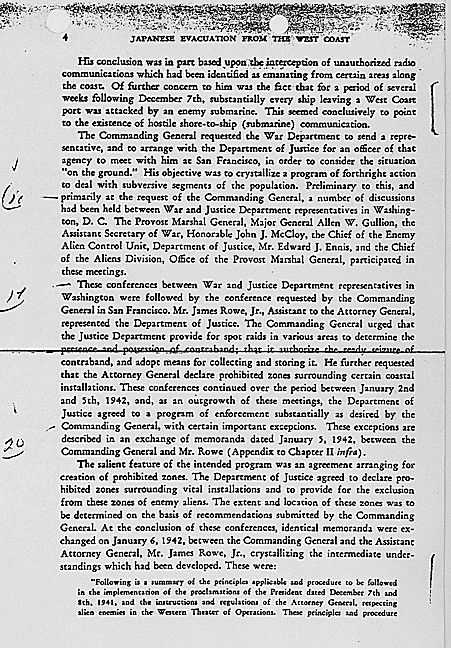
Enter your response
As a national security matter, the Army, under the leadership of Lieutenant General John L. DeWitt of the Western Defense Command, first announced curfews that applied only Japanese Americans. Next, they encouraged voluntary evacuation. After only a small percent complied, DeWitt began the forced evacuation and detention of West Coast residents of Japanese-American ancestry on a 48-hour notice.
Civil liberties are basic or natural rights and freedoms that people have, or protections from government interference or against unjust government actions. Look at the next set of documents: orders telling Japanese Americans what to do, a law punishing them if they did not comply, and images of people following the orders for their forced removal.
In the blank box that follows, answer: What civil liberties were they denied?
Civil liberties are basic or natural rights and freedoms that people have, or protections from government interference or against unjust government actions. Look at the next set of documents: orders telling Japanese Americans what to do, a law punishing them if they did not comply, and images of people following the orders for their forced removal.
In the blank box that follows, answer: What civil liberties were they denied?
[R9.20] Civilian Exclusion Order Instructions

An Act of March 21, 1942, Public Law 77-503, 56 STAT 173, to Provide a Penalty for Violation of Restrictions or Orders with Respect to Persons Entering, Remaining in, Leaving, or Committing Any Act in Military Areas or Zones
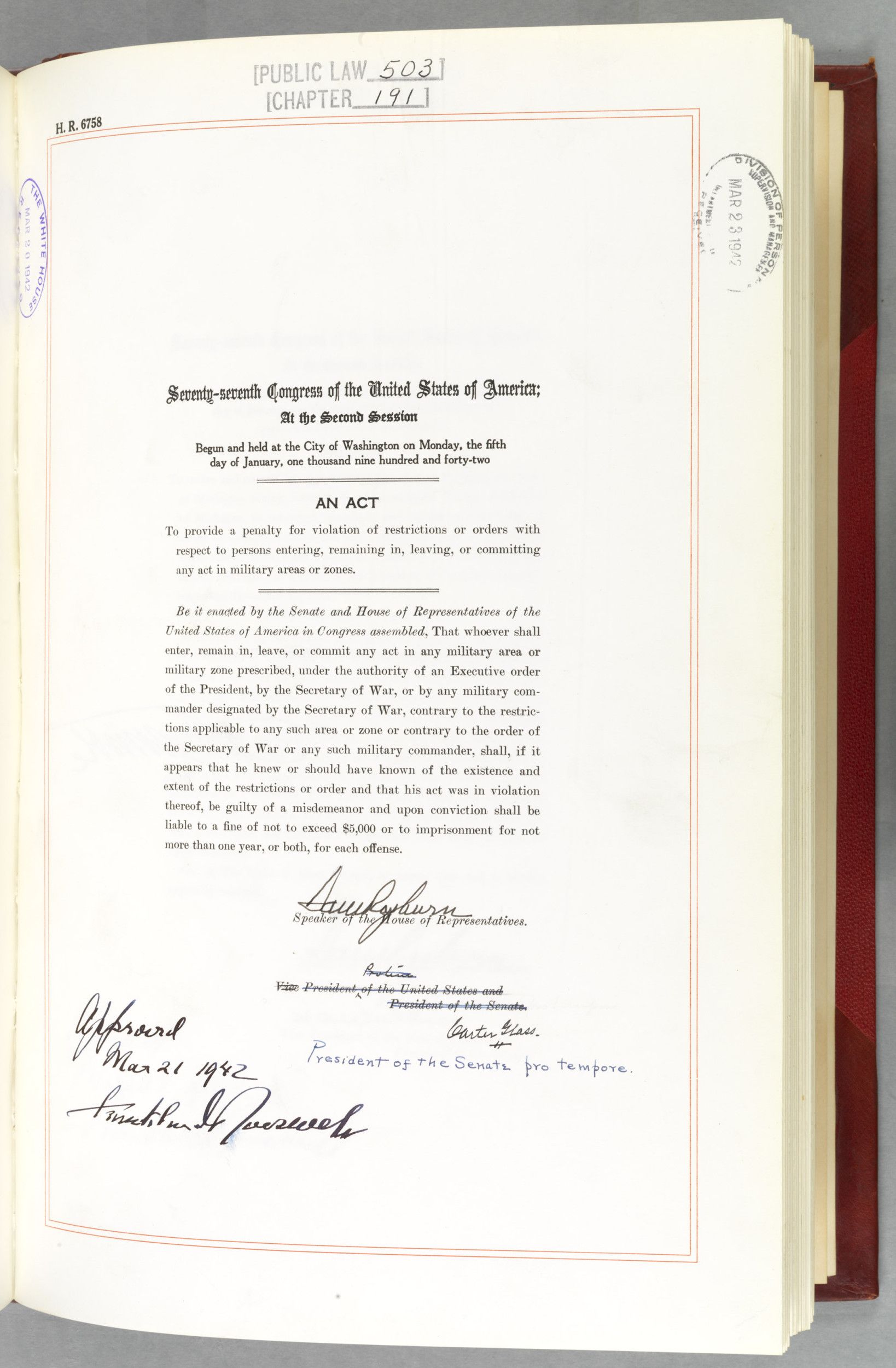
San Francisco, California. Civilian Exclusion Order Number 5, Ordering Evacuation of Residents of Japanese Ancestry

San Francisco, California. Japanese family heads and persons living alone form a line outside Civil Control Station
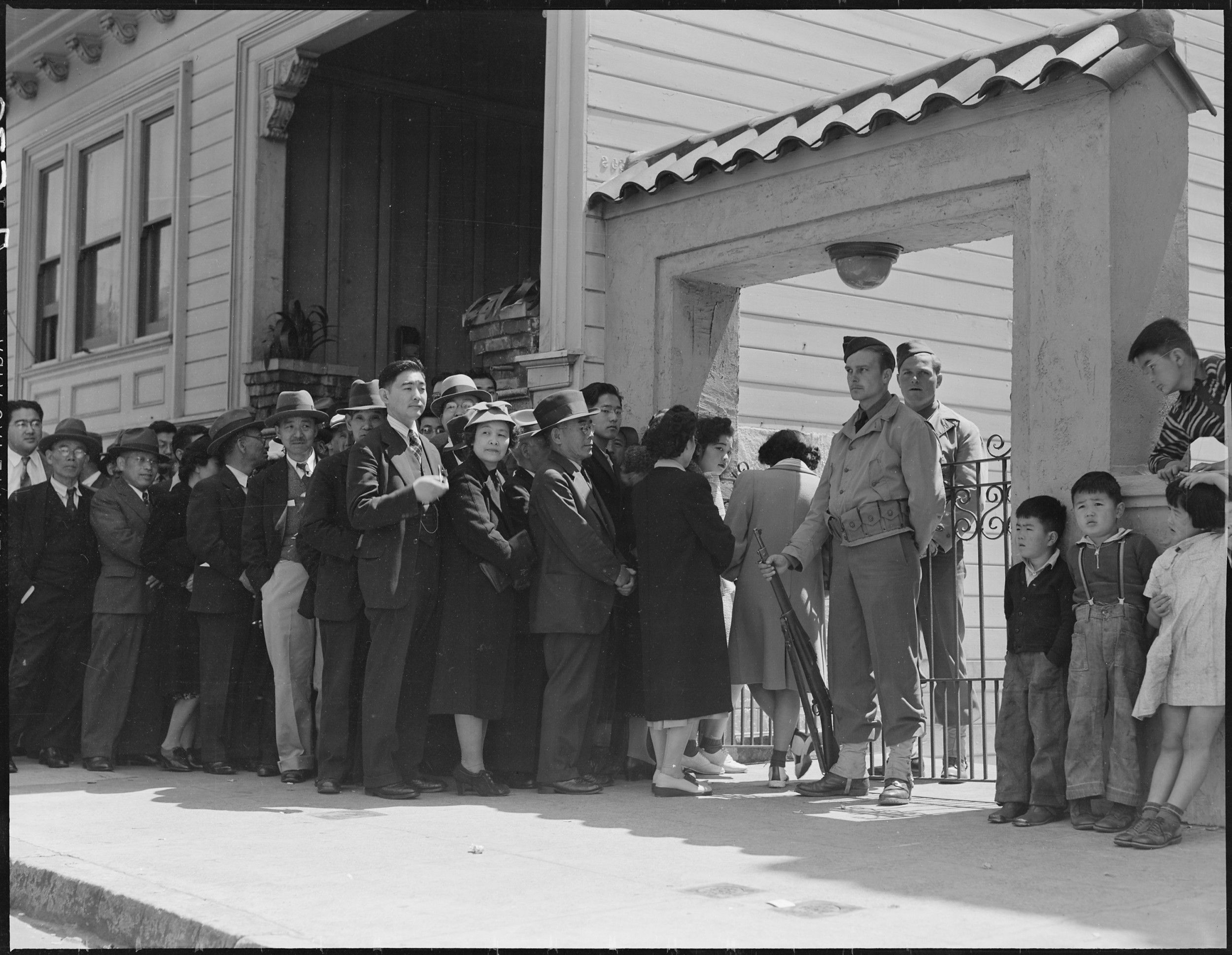
San Francisco, California. Residents of Japanese ancestry file forms containing personal data, two days before evacuation.
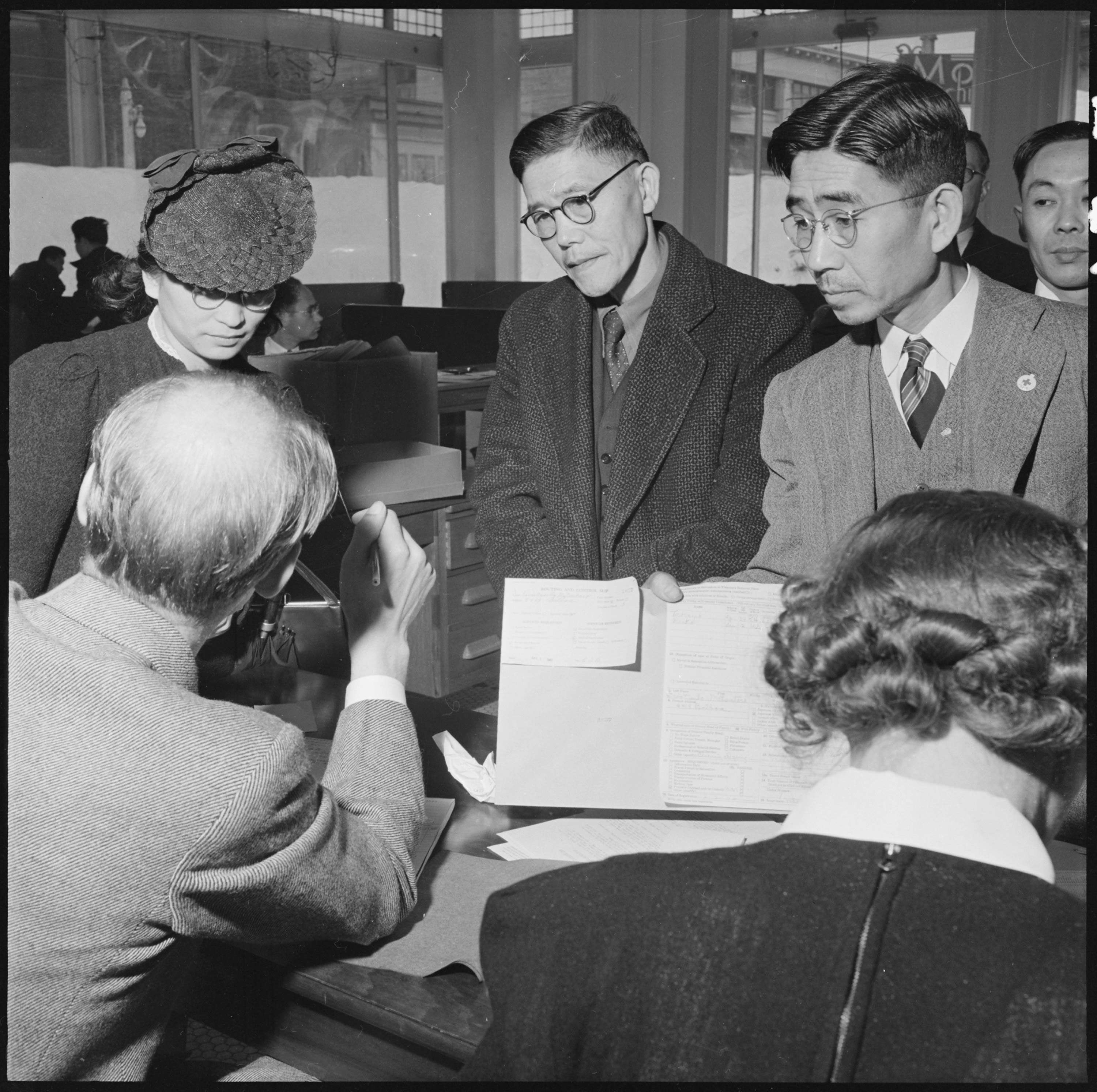
Hayward, California. Two children of the Mochida family who, with their parents, are awaiting evacuation bus.
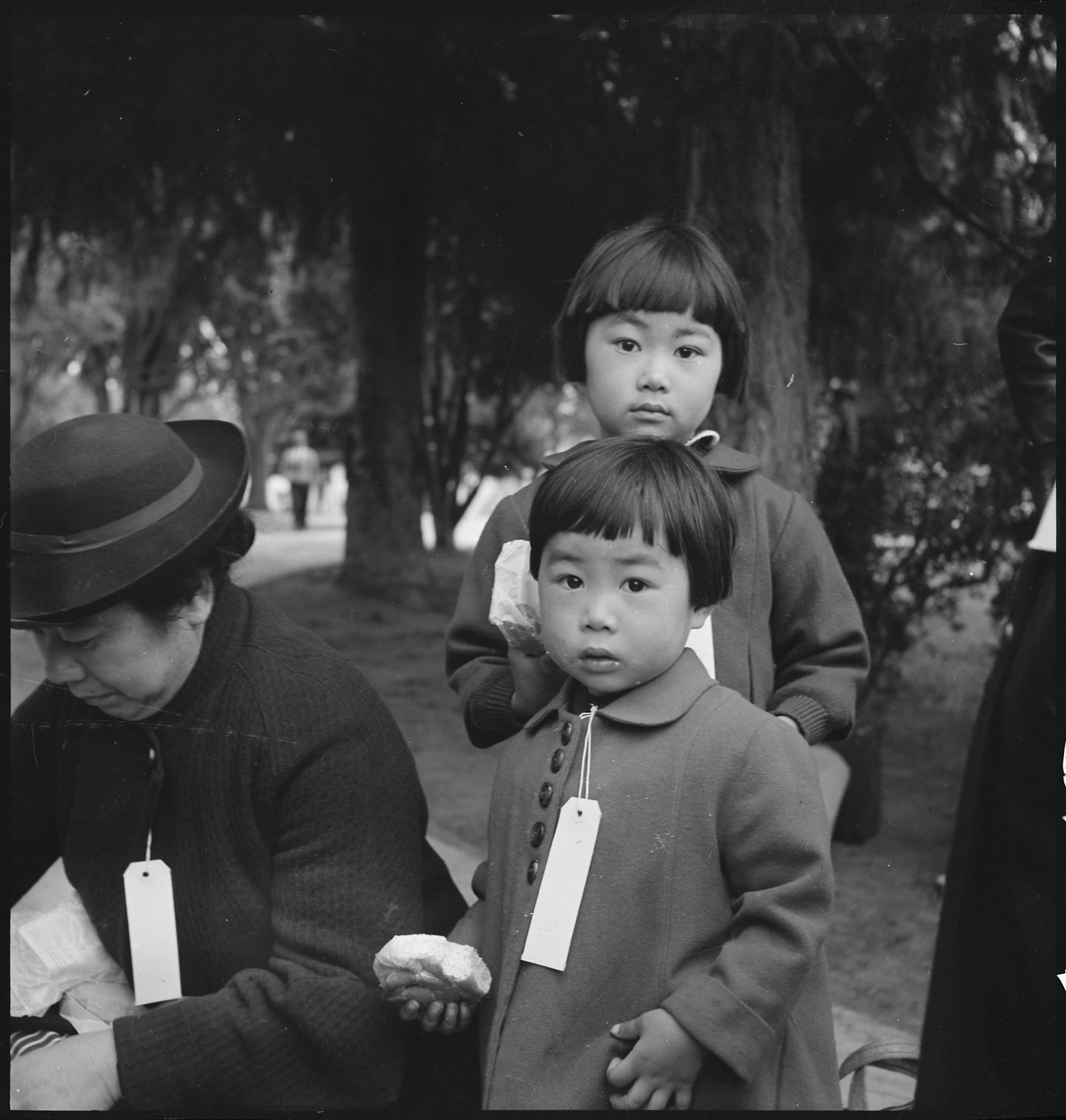
San Francisco, California. With baggage stacked, residents of Japanese ancestry await bus at Wartime. . .

Los Angeles, California. Mr. and Mrs. K. Tseri have closed their drugstore
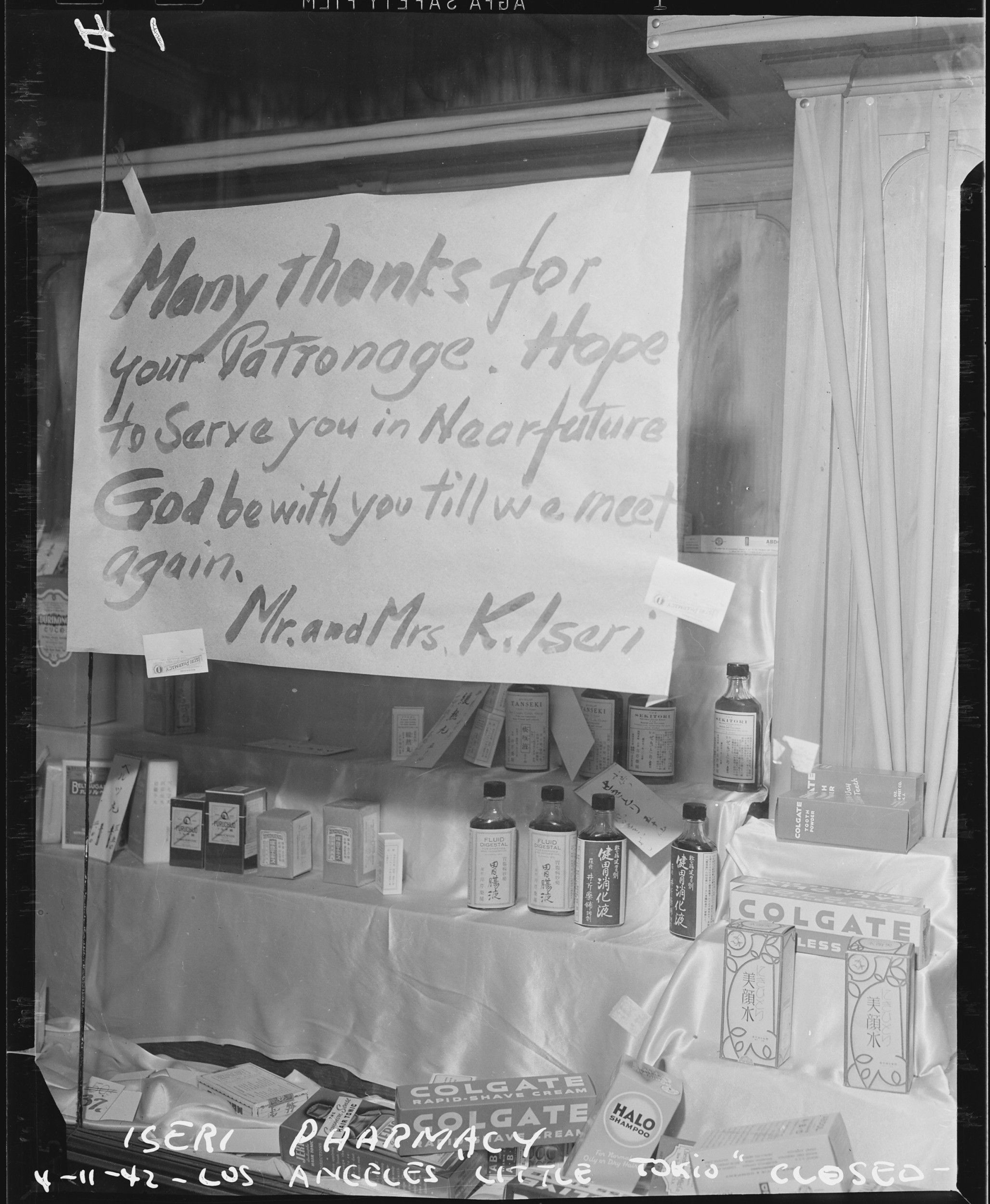
Enter your response
The federal government created the War Relocation Authority (WRA) in March 1942 to manage the forced removal and incarceration of more than 120,000 Japanese Americans to "relocation centers" (or "internment camps"). People were first sent to "assembly centers" – often racetracks or fairgrounds – where they waited and were tagged to indicate the location of a long-term "relocation center." Nearly 70,000 of the evacuees were American citizens. There were no charges of disloyalty against any of them, nor was there any way that they could appeal their loss of property and personal liberty.
"Relocation centers" were situated many miles inland, often in remote and desolate locales, in California, Idaho, Utah, Arizona, Wyoming, Colorado, and Arkansas.
Look at the map that follows, and then read the government report about the relocation program. In the blank box that follows, answer: What kind of language and wording is used? How do you think this would have been written differently if from the perspective of the people imprisoned in the camps?
"Relocation centers" were situated many miles inland, often in remote and desolate locales, in California, Idaho, Utah, Arizona, Wyoming, Colorado, and Arkansas.
Look at the map that follows, and then read the government report about the relocation program. In the blank box that follows, answer: What kind of language and wording is used? How do you think this would have been written differently if from the perspective of the people imprisoned in the camps?
Map of Camps, from the National Park Service, http://www.npshistory.com/publications/nhl/theme-studies/japanese-americans-ww2.pdf
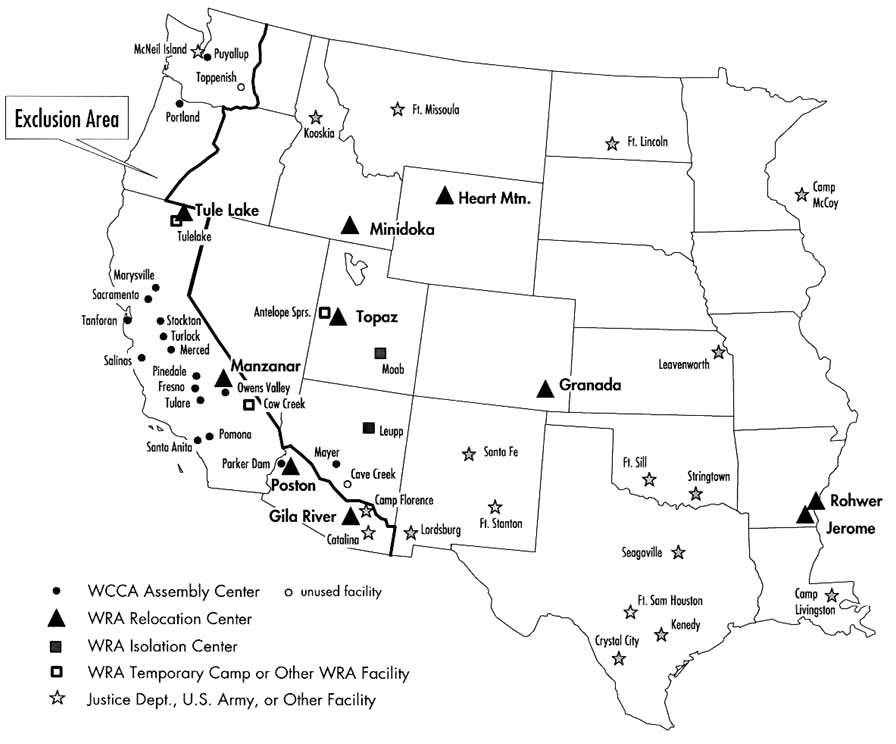
Report on Japanese-Americans in Relocation Centers
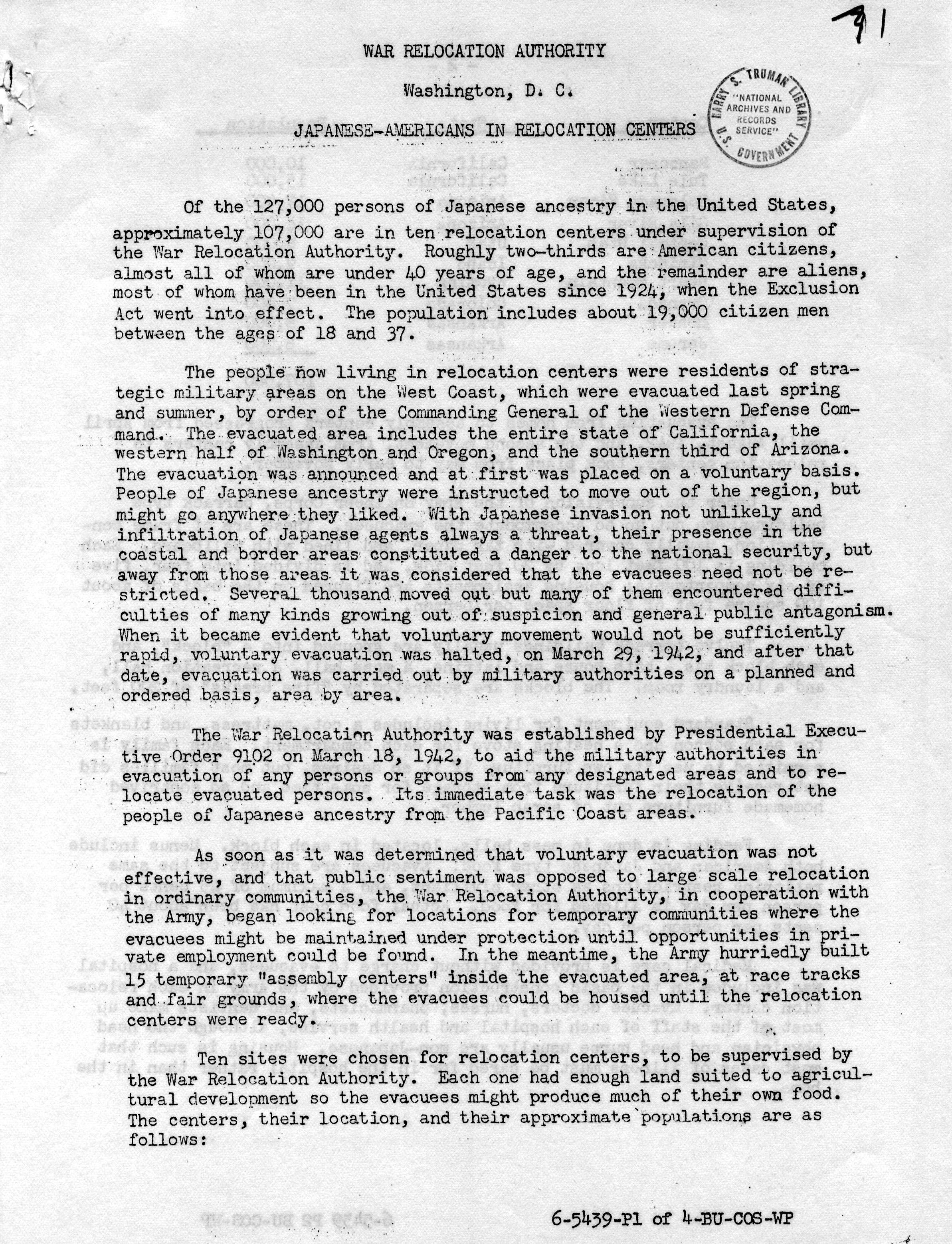
Enter your response
Photographers working for the War Relocation Authority took thousands of photographs of Japanese American families preparing to leave their homes, at "assembly centers," and at "internment" camps. Many of these photographs attempt to show life "as normal" in camps.
Four or five families, with their sparse collections of clothing and possessions, shared tar-papered army-style barracks. Most lived in these conditions for nearly three years or more until the end of the war. Gradually some insulation was added and lightweight partitions made them a little more comfortable and somewhat private. Life took on some familiar routines of socializing and school. However, eating in common facilities, using shared restrooms, and having limited opportunities for work interrupted social and cultural patterns. Persons who resisted were sent to a special camp at Tule Lake, California, where dissidents were housed.
Look through the following photos. In the blank box that follows, list at least two examples of how they attempt to depict "normal life," as well as at least two ways that they show civil liberties being denied.
Four or five families, with their sparse collections of clothing and possessions, shared tar-papered army-style barracks. Most lived in these conditions for nearly three years or more until the end of the war. Gradually some insulation was added and lightweight partitions made them a little more comfortable and somewhat private. Life took on some familiar routines of socializing and school. However, eating in common facilities, using shared restrooms, and having limited opportunities for work interrupted social and cultural patterns. Persons who resisted were sent to a special camp at Tule Lake, California, where dissidents were housed.
Look through the following photos. In the blank box that follows, list at least two examples of how they attempt to depict "normal life," as well as at least two ways that they show civil liberties being denied.
Eden, Idaho. Baggage, belonging to evacuees from the assembly center at Puyallup, Washington is sorted.

Topaz, Utah. A panorama view of the Central Utah Relocation Center, taken from the water tower.
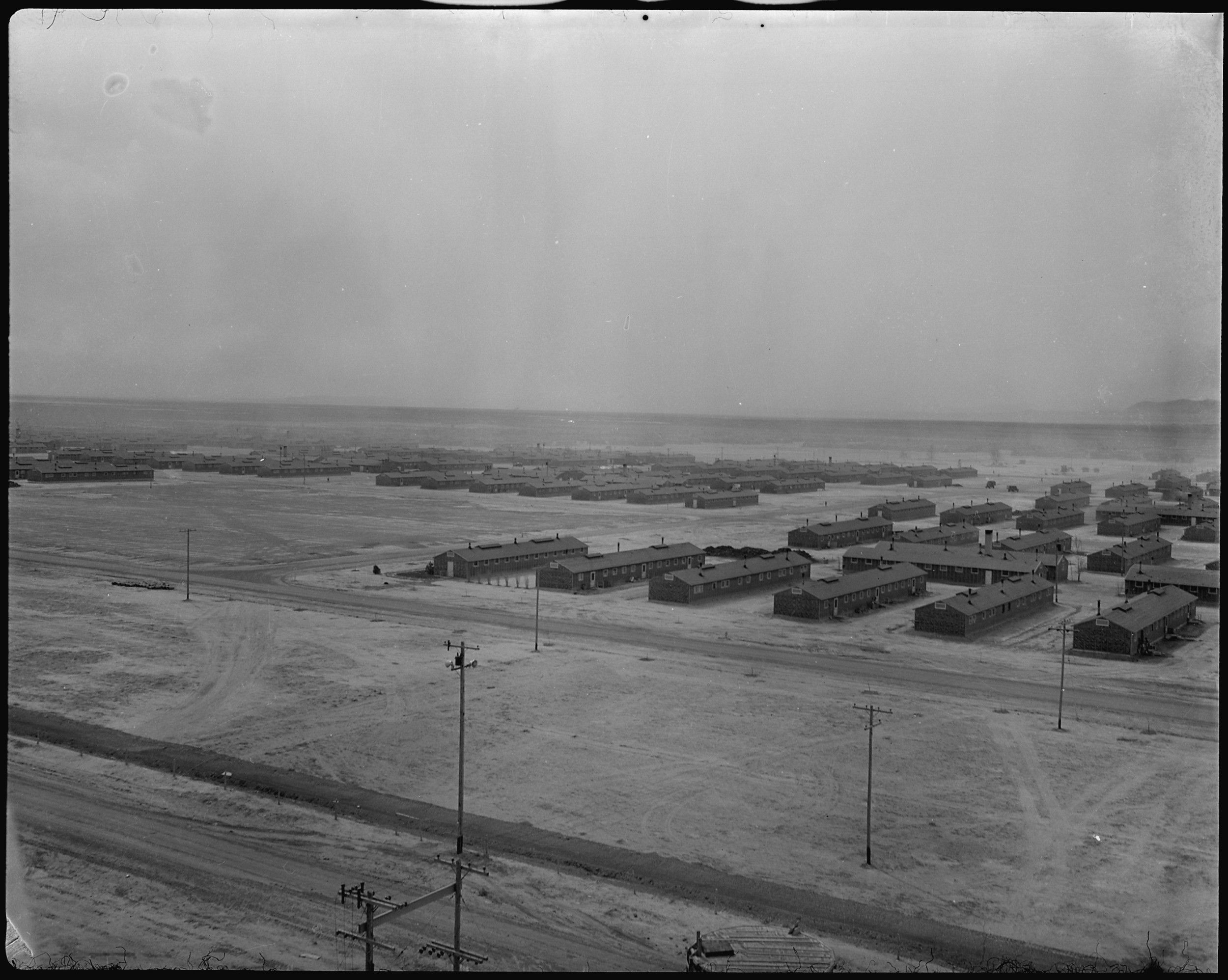
Poston, Arizona. Mosaru Oshio with his children on the steps of his barrack home at this War Relocation Authority center for evacuees of Japanese ancestry.
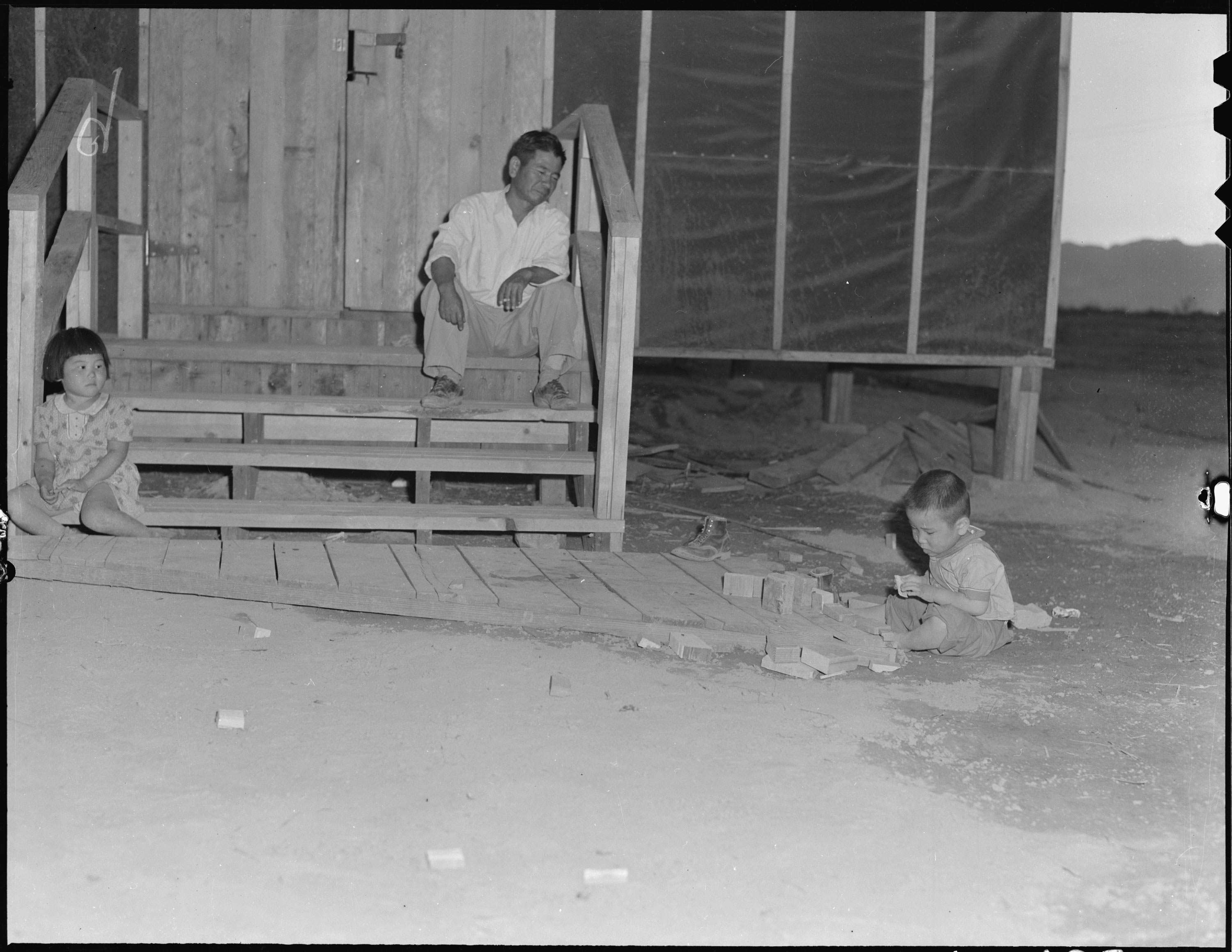
Manzanar Relocation Center, Manzanar, California. An elementary school with voluntary attendance has been established with volunteer evacuee teachers, most of whom are college graduates.

Poston, Arizona. Cheiko Neeno, nurse`s aid student at th Poston Hospital, attending a baby patient in the children`s ward. These nurse`s aid students are taught to efficiently assist Registered Nurses in the care and treatment of patients. The course
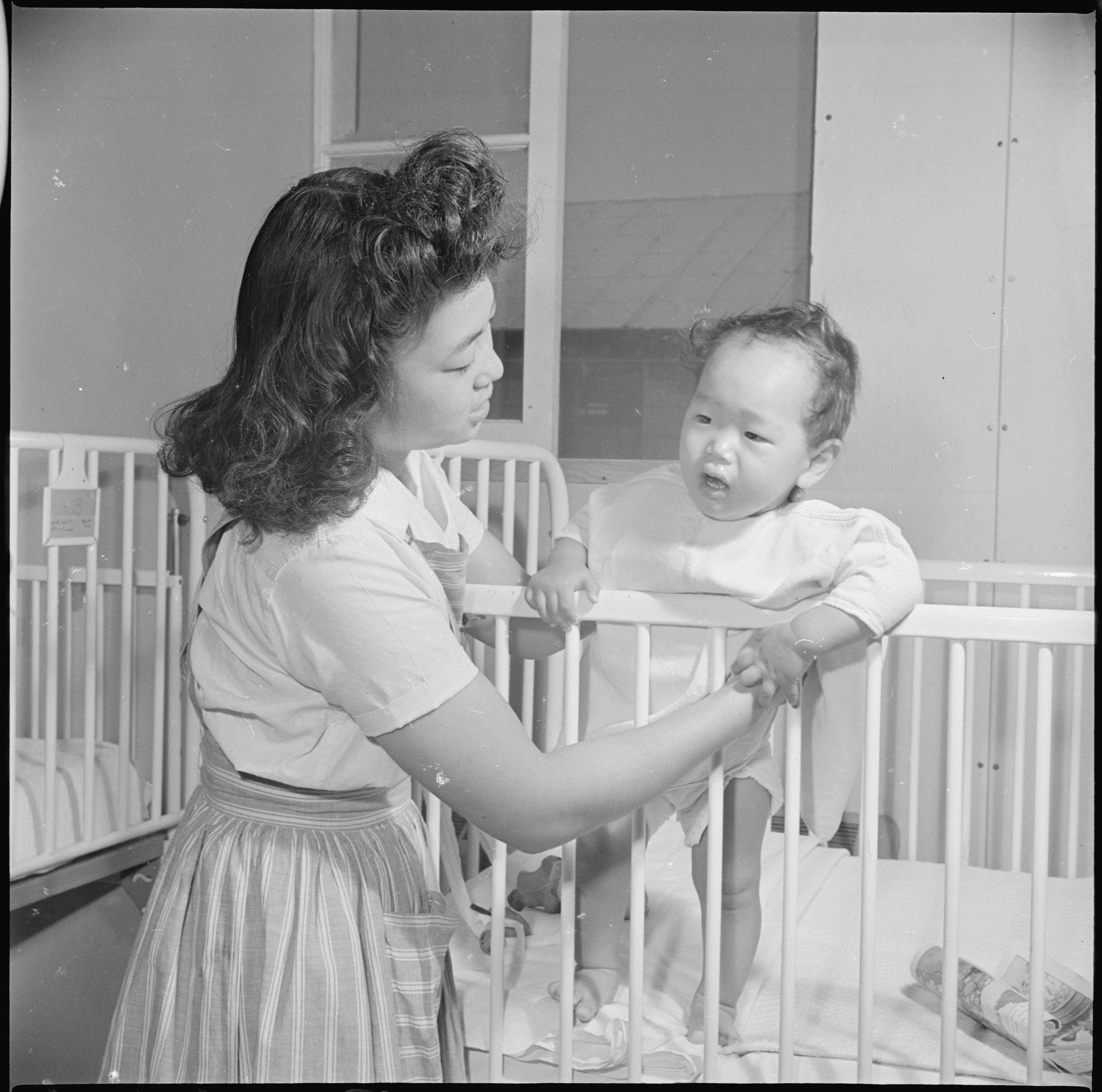
Tule Lake Relocation Center, Newell, California. A view in the lunch shed at the farm.
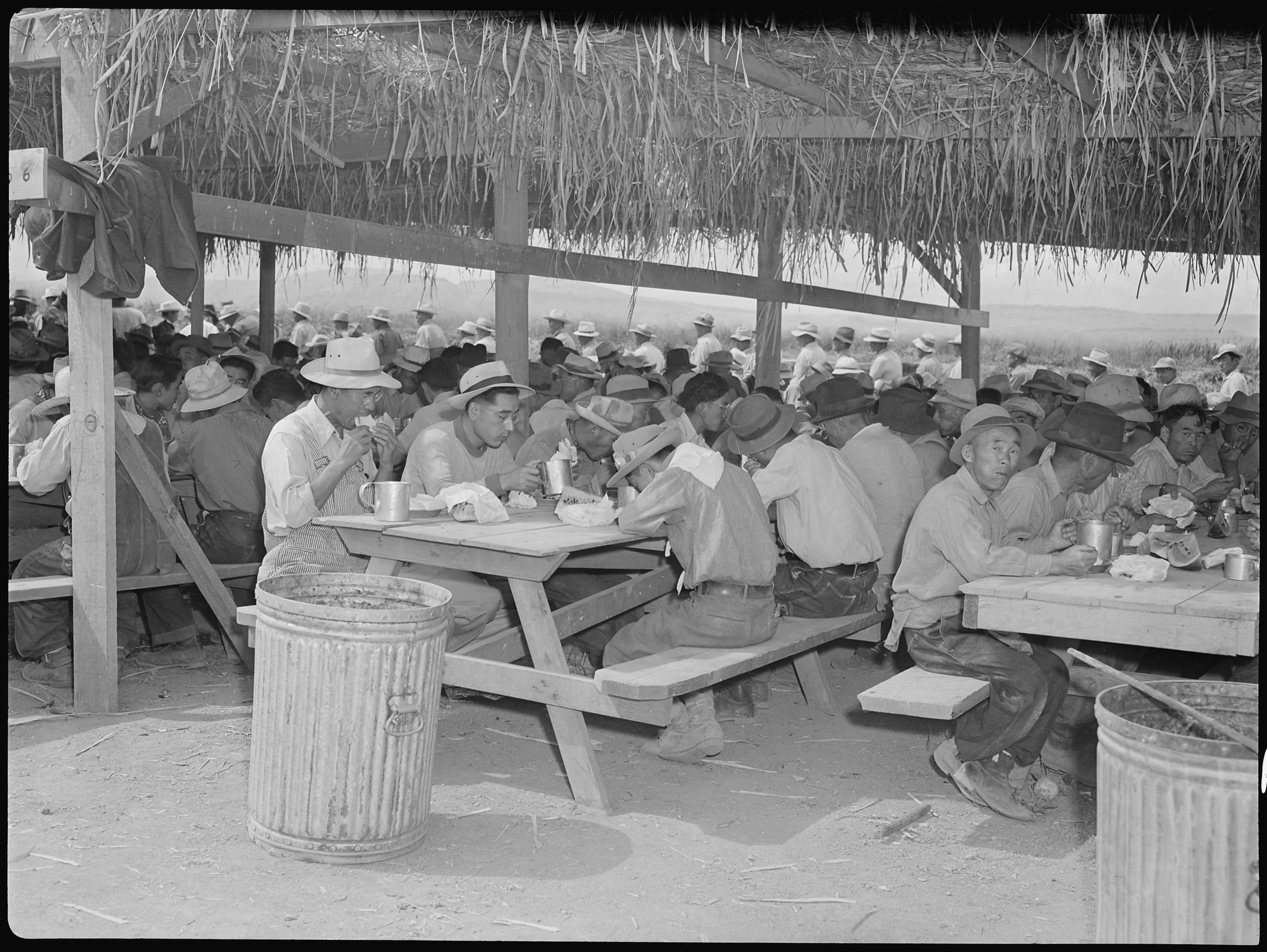
Manzanar Relocation Center, Manzanar, California. Baseball is the most popular recreation at this War Relocation Authority center...
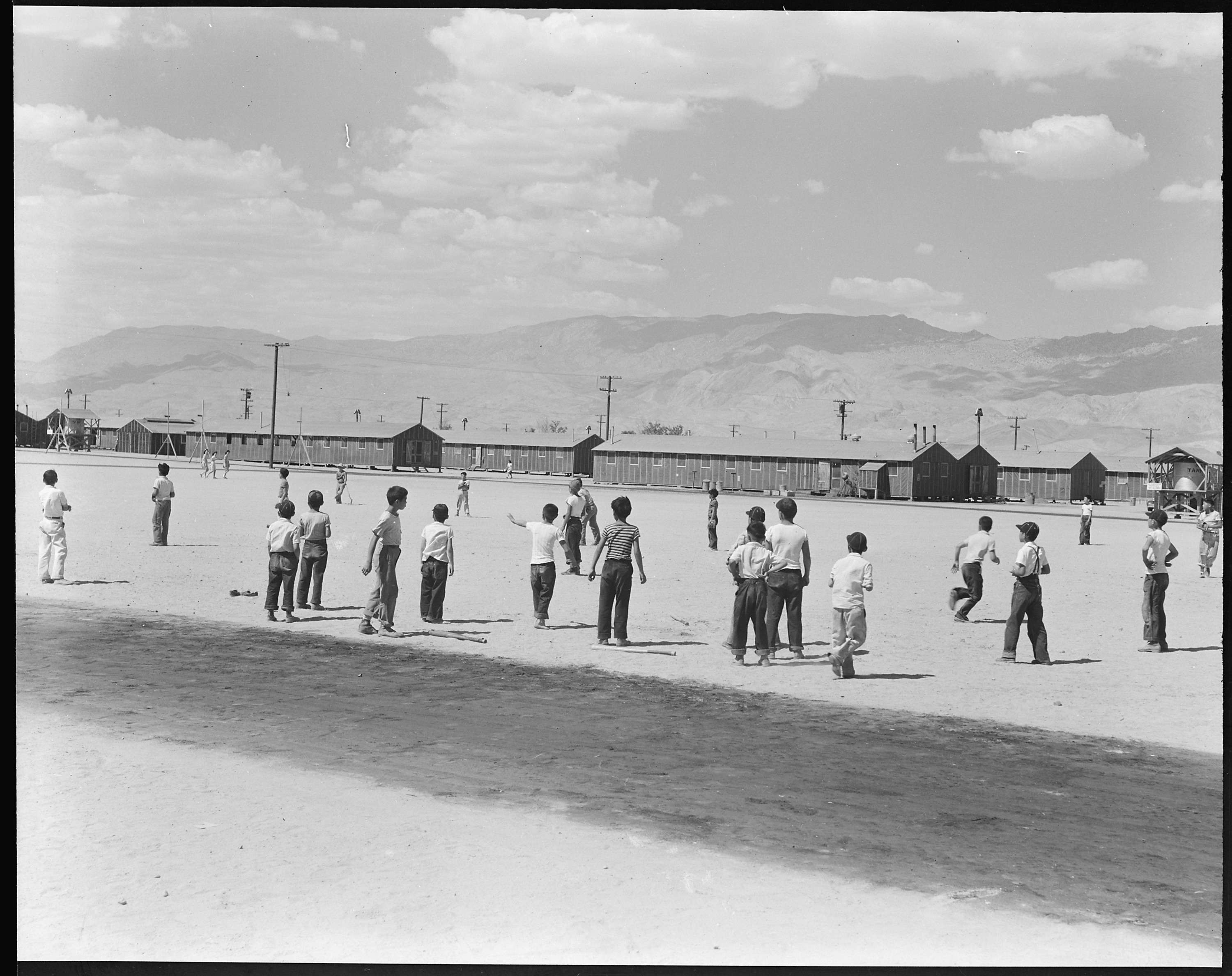
Heart Mountain Relocation Center, Heart Mountain, Wyoming. It takes approximately four carloads of coal a day to provide heat.
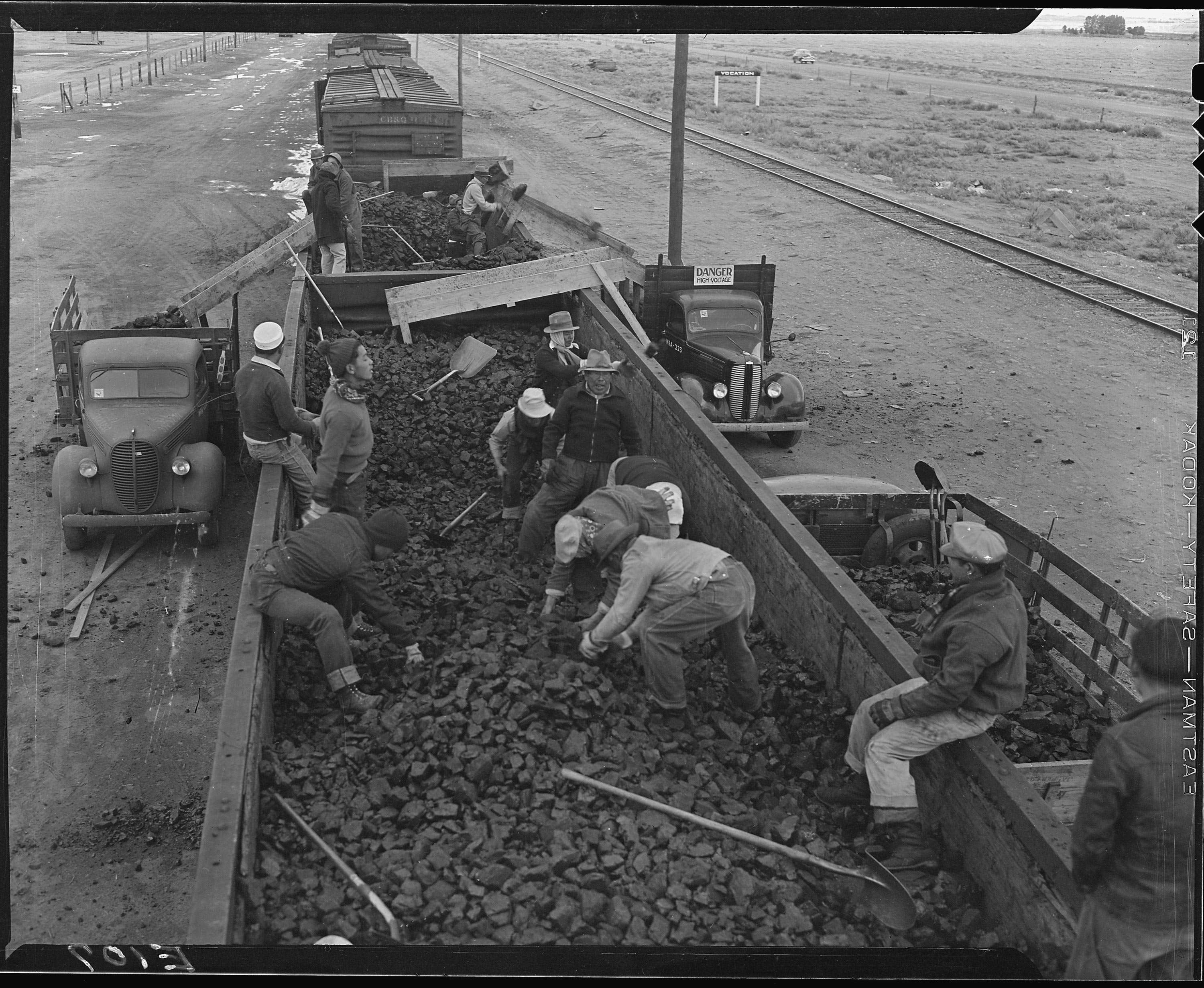
Heart Mountain Relocation Center, Heart Mountain, Wyoming. The poster crew at this relocation center.
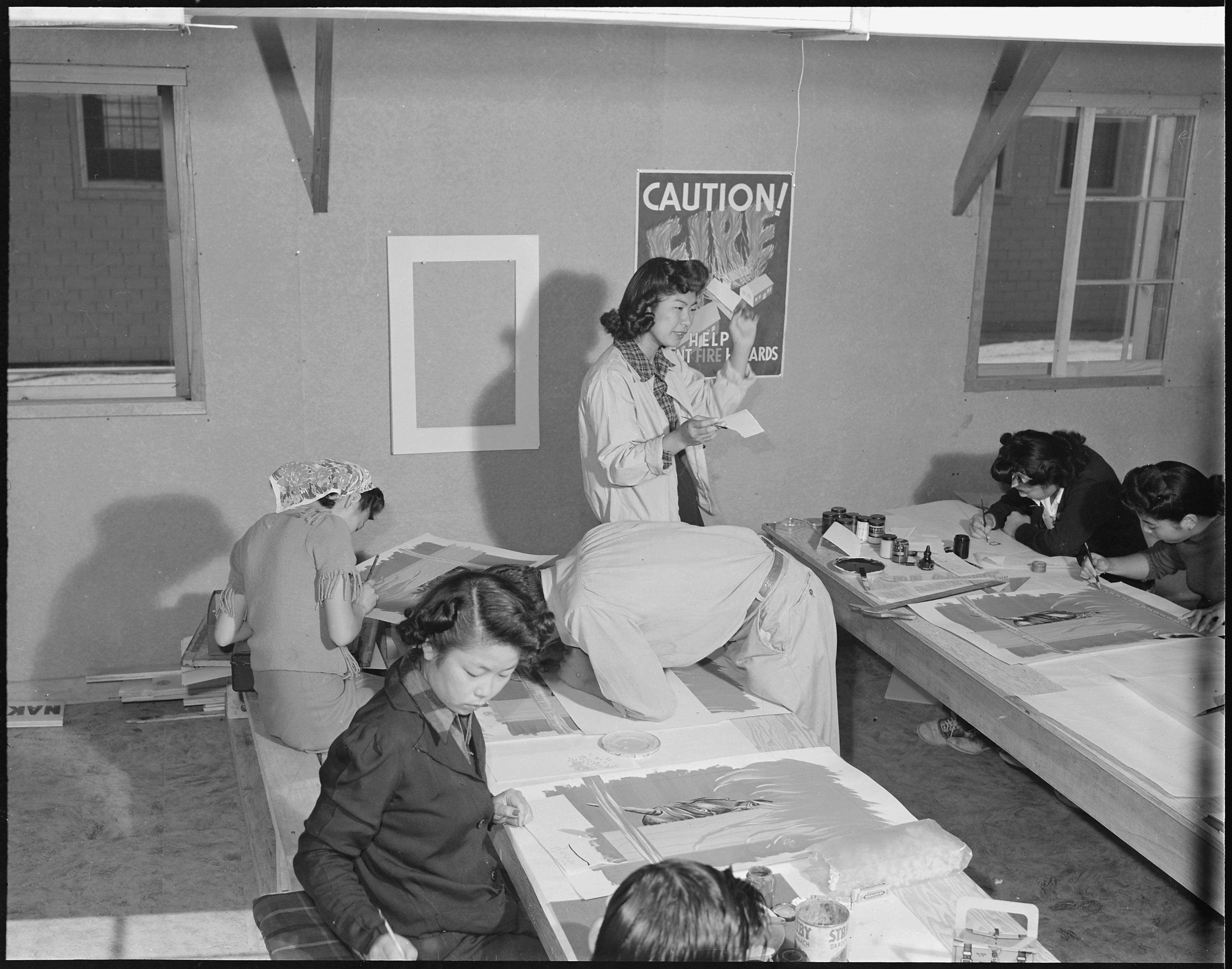
San Bruno, California. Entering Recreational Hall where election is being held for Councilman...

Heart Mountain Relocation Center, Heart Mountain, Wyoming. A session of the court.
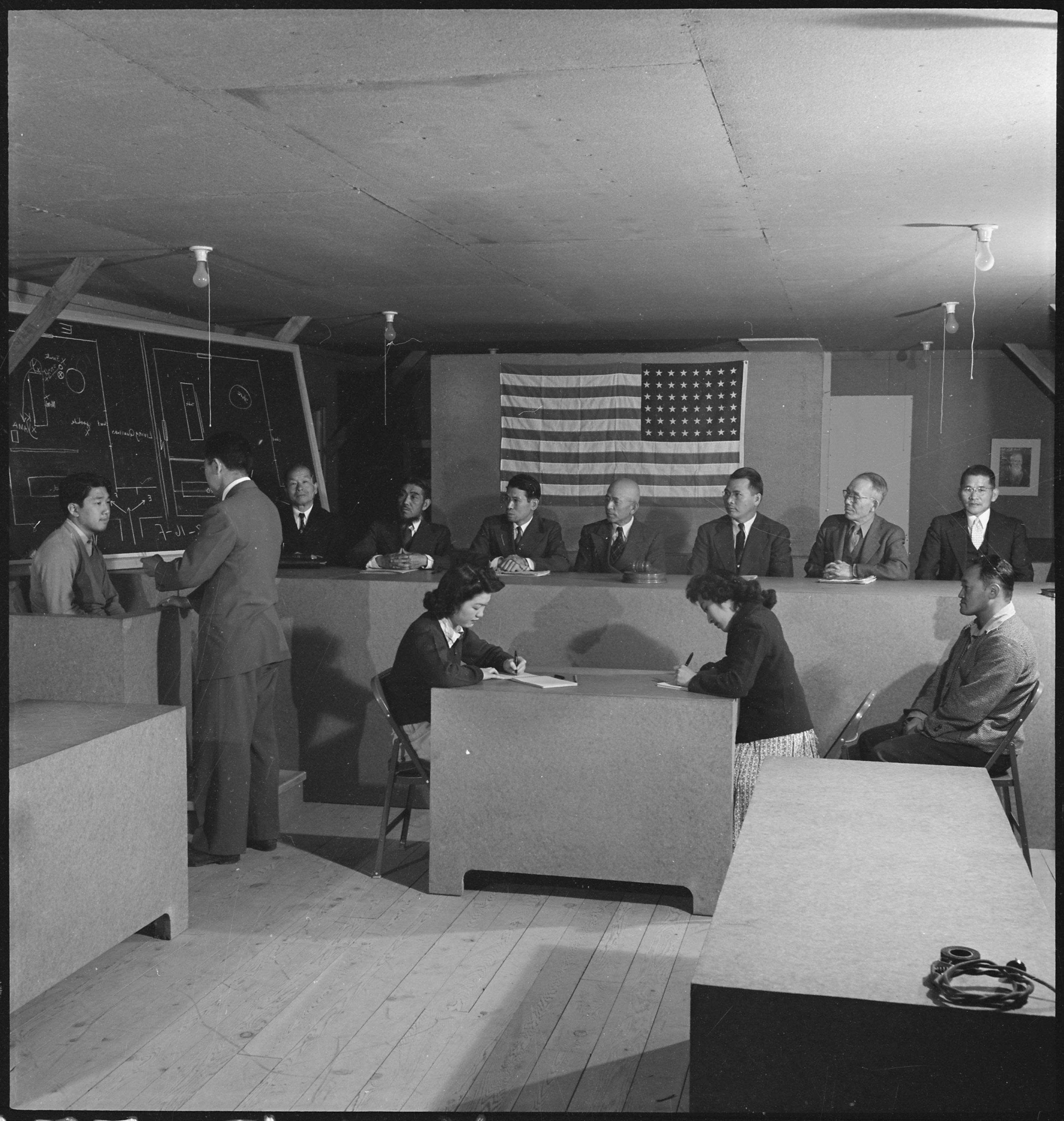
Enter your response
The incarceration of Japanese Americans sparked constitutional and political debate. Although several Japanese Americans challenged the government’s actions in court cases, the Supreme Court upheld their legality.
Read the following documents: a statement from the director of the War Relocation Authority to Congress and a letter from the Assistant Secretary of War. In the blank box that follows, answer: Why did government officials think the program was necessary? How did they argue that it didn't violate the Constitution?
Read the following documents: a statement from the director of the War Relocation Authority to Congress and a letter from the Assistant Secretary of War. In the blank box that follows, answer: Why did government officials think the program was necessary? How did they argue that it didn't violate the Constitution?
Constitutional Principles Involved in the Relocation Program
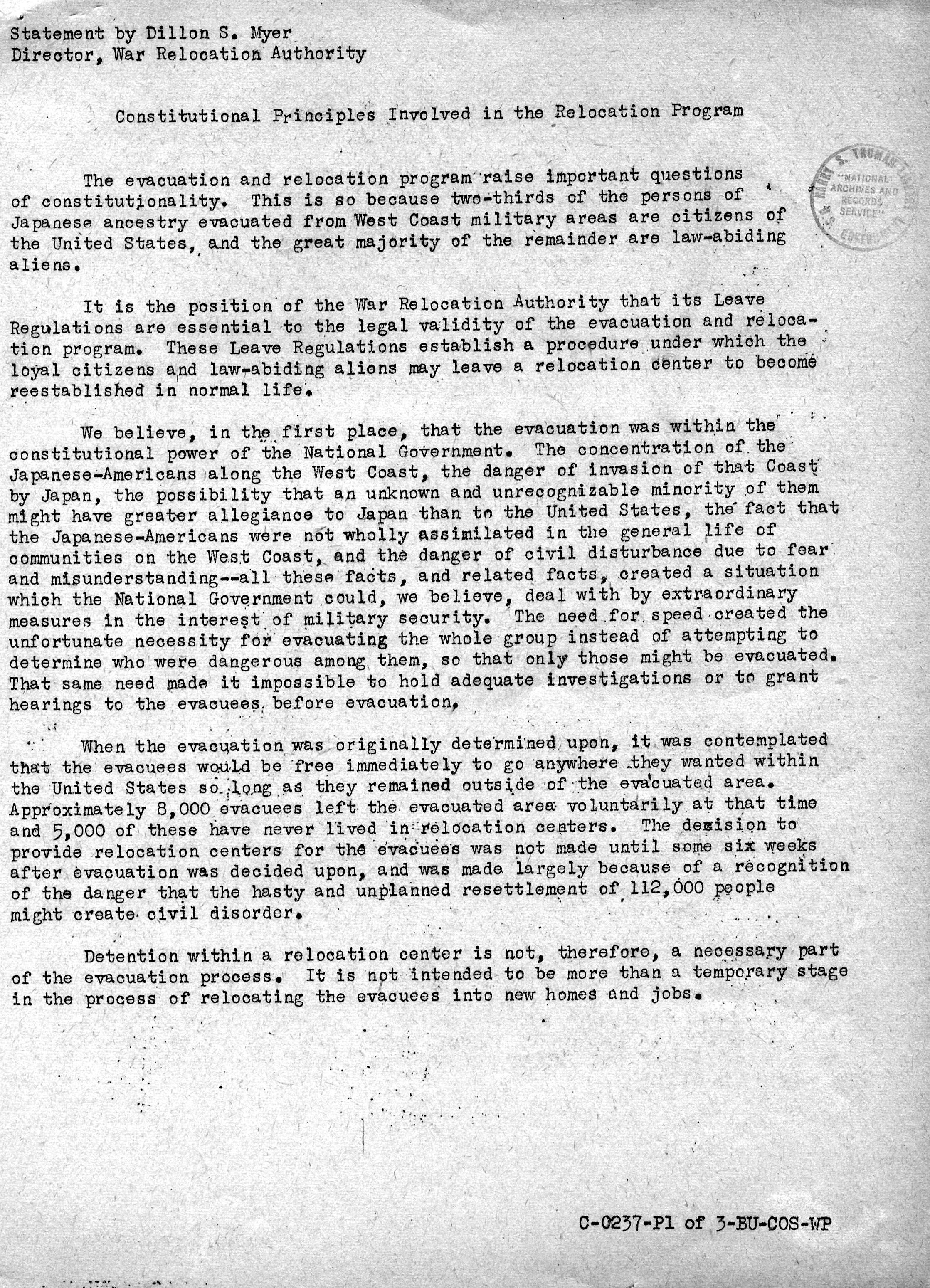
Letter to Mr. Paul T. Bannai, Executive Director of the Commission on Wartime Relocation and Internment of Civilians, from John McCloy
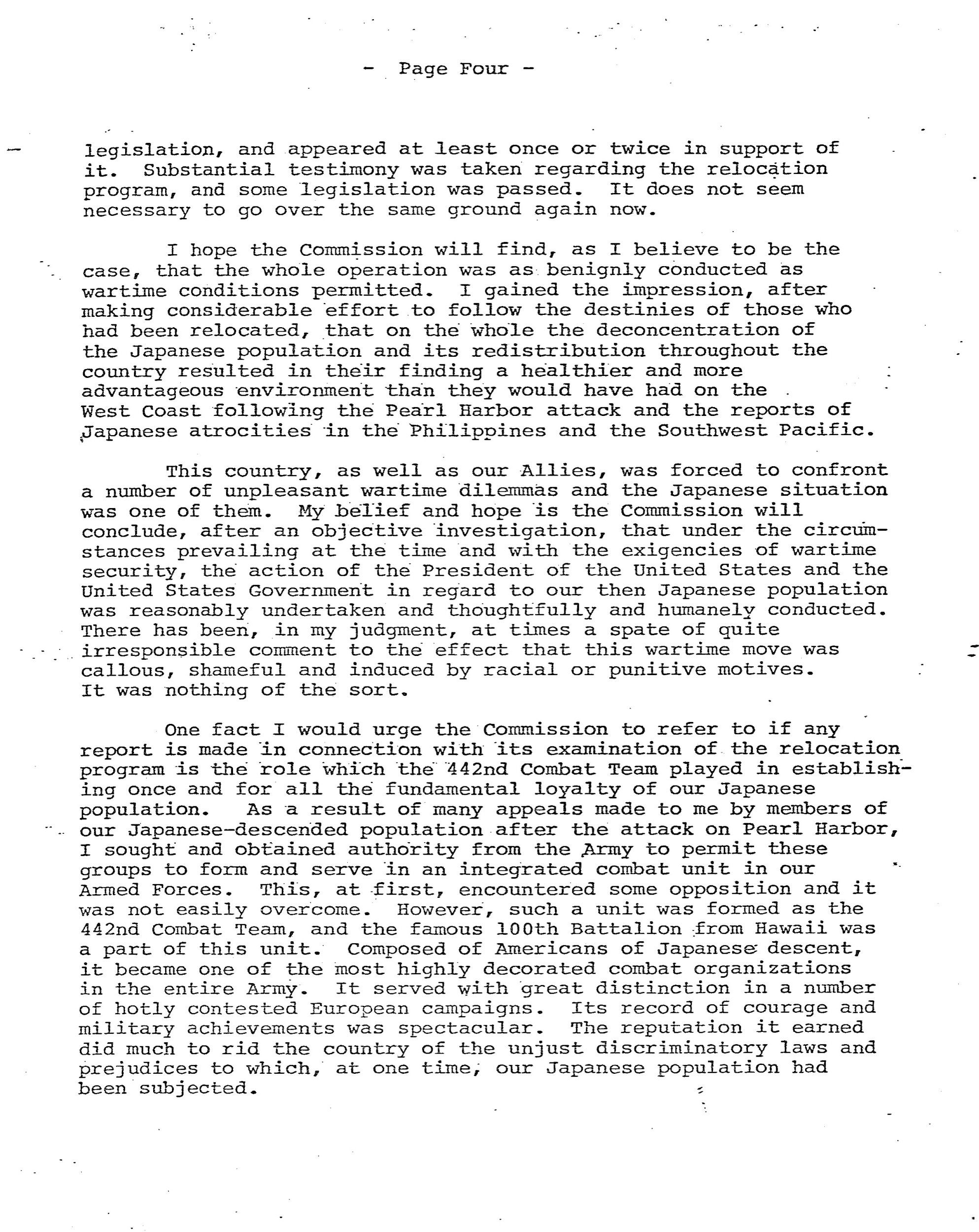
Enter your response
Japanese Americans had been encouraged to serve in the U.S. armed forces, and some were also drafted. More than 30,000 served with distinction in segregated units. The 442d Regimental Combat Team gained fame as the most highly decorated of the war.
The Hirano family, left to right, George, Hisa, and Yasbei. Colorado River Relocation Center, Poston, Arizona.

World War II ended on August 14, 1945, when Japan surrendered. On September 4, 1945, all restrictions to Japanese Americans living on the west coast were lifted, and the last "internment camp" closed on March 28, 1946.
Poston, Arizona. The bus waits outside and young and old are anxious to be off.
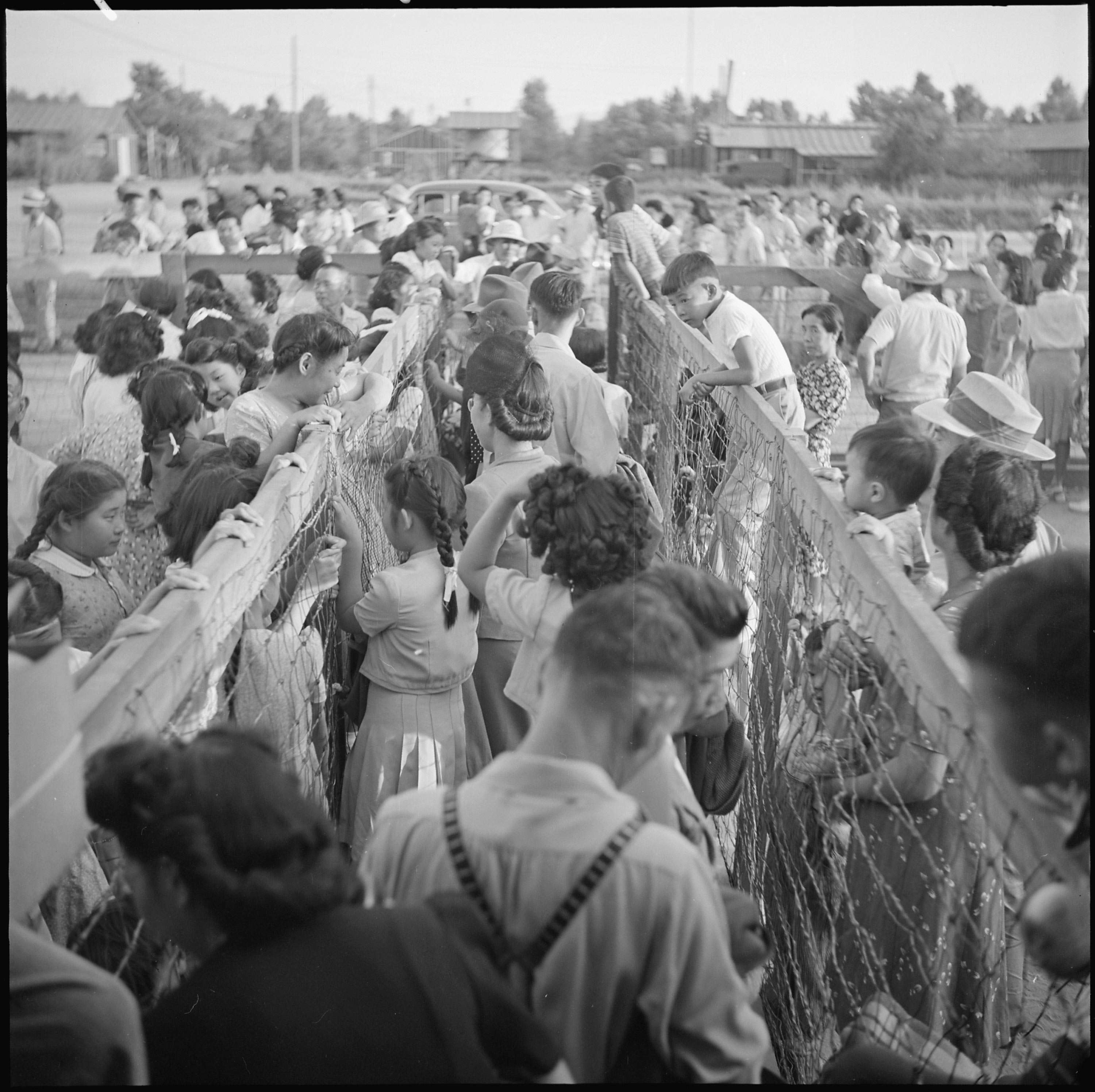
1
Activity Element
Executive Order 9066 dated February 19, 1942, in which President Franklin D. Roosevelt Authorizes the Secretary of War to Prescribe Military Areas
Page 1

2
Activity Element
Transcript of Telephone Conversation between Secretary of the Treasury Henry Morgenthau, Jr. and President Franklin D. Roosevelt
Page 2

3
Activity Element
Letter to Mr. Paul T. Bannai, Executive Director of the Commission on Wartime Relocation and Internment of Civilians, from John McCloy
Page 2

4
Activity Element
Exhibit L: Copy of "Conference with General De Witt"
Page 1

5
Activity Element
Final Report: Japanese Evacuation from the West Coast
Page 3

6
Activity Element
[R9.20] Civilian Exclusion Order Instructions
Page 3

7
Activity Element
An Act of March 21, 1942, Public Law 77-503, 56 STAT 173, to Provide a Penalty for Violation of Restrictions or Orders with Respect to Persons Entering, Remaining in, Leaving, or Committing Any Act in Military Areas or Zones
Page 1

8
Activity Element
San Francisco, California. Civilian Exclusion Order Number 5, Ordering Evacuation of Residents of Japanese Ancestry
Page 1

9
Activity Element
San Francisco, California. Japanese family heads and persons living alone form a line outside Civil Control Station
Page 1

10
Activity Element
San Francisco, California. Residents of Japanese ancestry file forms containing personal data, two days before evacuation.
Page 1

11
Activity Element
Hayward, California. Two children of the Mochida family who, with their parents, are awaiting evacuation bus.
Page 1

12
Activity Element
San Francisco, California. With baggage stacked, residents of Japanese ancestry await bus at Wartime. . .
Page 1

13
Activity Element
Los Angeles, California. Mr. and Mrs. K. Tseri have closed their drugstore
Page 1

14
Activity Element
Map of Camps, from the National Park Service, http://www.npshistory.com/publications/nhl/theme-studies/japanese-americans-ww2.pdf

15
Activity Element
Report on Japanese-Americans in Relocation Centers
Page 1

16
Activity Element
Eden, Idaho. Baggage, belonging to evacuees from the assembly center at Puyallup, Washington is sorted.
Page 1

17
Activity Element
Topaz, Utah. A panorama view of the Central Utah Relocation Center, taken from the water tower.
Page 1

18
Activity Element
Poston, Arizona. Mosaru Oshio with his children on the steps of his barrack home at this War Relocation Authority center for evacuees of Japanese ancestry.
Page 1

19
Activity Element
Manzanar Relocation Center, Manzanar, California. An elementary school with voluntary attendance has been established with volunteer evacuee teachers, most of whom are college graduates.
Page 1

20
Activity Element
Poston, Arizona. Cheiko Neeno, nurse`s aid student at th Poston Hospital, attending a baby patient in the children`s ward. These nurse`s aid students are taught to efficiently assist Registered Nurses in the care and treatment of patients. The course
Page 1

21
Activity Element
Tule Lake Relocation Center, Newell, California. A view in the lunch shed at the farm.
Page 1

22
Activity Element
Manzanar Relocation Center, Manzanar, California. Baseball is the most popular recreation at this War Relocation Authority center...
Page 1

23
Activity Element
Heart Mountain Relocation Center, Heart Mountain, Wyoming. It takes approximately four carloads of coal a day to provide heat.
Page 1

24
Activity Element
Heart Mountain Relocation Center, Heart Mountain, Wyoming. The poster crew at this relocation center.
Page 1

25
Activity Element
San Bruno, California. Entering Recreational Hall where election is being held for Councilman...
Page 1

26
Activity Element
Heart Mountain Relocation Center, Heart Mountain, Wyoming. A session of the court.
Page 1

27
Activity Element
Constitutional Principles Involved in the Relocation Program
Page 1

28
Activity Element
Letter to Mr. Paul T. Bannai, Executive Director of the Commission on Wartime Relocation and Internment of Civilians, from John McCloy
Page 4

29
Activity Element
The Hirano family, left to right, George, Hisa, and Yasbei. Colorado River Relocation Center, Poston, Arizona.
Page 1

30
Activity Element
Poston, Arizona. The bus waits outside and young and old are anxious to be off.
Page 1

Conclusion
Japanese American Incarceration During World War II
Making Connections
Four decades after the forced relocation and incarceration of Japanese Americans during World War II, the United States took some steps to redress these violations of civil liberties:- In 1980, Congress appointed a Commission on Wartime Relocation and Internment of Civilians (CWRIC) to conduct an official study of what happened.
- In 1984, a federal court voided the 1944 Supreme Court conviction of Fred Korematsu (Korematsu v. United States), who had been found guilty of resisting "relocation" and "internment."
- In 1988, based on the CWRIC's findings, Congress passed the Civil Liberties Act of 1988 that acknowledged the injustice of "internment," apologized for it, and provided a $20,000 cash payment to each person who was interned, totaling $1.6 billion in reparation.
In the 1984 Korematsu decision, the court wrote the following, including quotes from Personal Justice Denied, the CWRIC's report:
The findings and conclusions of the Commission were unanimous. ...at the time of the issuance of Executive Order 9066 and implementing military orders, there was substantial credible evidence from a number of federal civilian and military agencies contradicting the report of General DeWitt that military necessity justified exclusion and internment of all persons of Japanese ancestry without regard to individual identification of those who may have been potentially disloyal.
The Commission found that military necessity did not warrant the exclusion and detention of ethnic Japanese. It concluded that "broad historical causes...were race prejudice, war hysteria and a failure of political leadership." As a result, "a grave injustice was done to American citizens and resident aliens of Japanese ancestry who, without...evidence against them, were excluded, removed and detained by the United States during World War II."
...in times of war or declared military necessity our institutions must be vigilant in protecting constitutional guarantees. ...in times of international hostility and antagonisms our institutions, legislative, executive and judicial, must be prepared to exercise their authority to protect all citizens from the petty fears and prejudices that are so easily aroused.
Write one sentence that summarizes the lesson that the court wanted Americans to learn from this history.
Your Response
Document
Executive Order 9066 dated February 19, 1942, in which President Franklin D. Roosevelt Authorizes the Secretary of War to Prescribe Military Areas
2/19/1942
Issued by President Franklin Roosevelt on February 19, 1942, Executive Order 9066 authorized the Secretary of War to evacuate all persons deemed a threat to national security from the West Coast to "relocation centers" further inland.
Prior to the outbreak of World War II, the Federal Bureau of Investigation (FBI) had identified German, Italian, and Japanese aliens who were suspected of being potential enemy agents. Following the attack at Pearl Harbor, the West Coast was divided into military zones and suspect enemy aliens were kept under surveillance. By mid-January 1942, demands arose to exclude not only suspicious aliens whose origins were in belligerent nations, but all persons of Japanese descent, whether foreign born (issei) or American citizens (nisei). During congressional committee hearings, Department of Justice representatives raised constitutional and ethical objections to the proposal, so the U.S. Army carried out the task instead.
The West Coast was divided into military zones, and on February 19, 1942, President Franklin D. Roosevelt issued Executive Order 9066 that authorized military commanders to exclude civilians from military areas. Although the language of the order did not specify any ethnic group, Lieutenant General John L. DeWitt of the Western Defense Command proceeded to announce curfews that included only Japanese Americans. Next, he encouraged voluntary evacuation by Japanese Americans from a limited number of areas; about 7 percent of the total Japanese American population in these areas complied.
On March 29, 1942, under the authority of the President's executive order, DeWitt issued Public Proclamation No. 4, which began the forced evacuation and detention of Japanese-American West Coast residents on a 48-hour notice. Only a few days prior to the proclamation, on March 21, Congress had passed Public Law 503, which made violation of Executive Order 9066 a misdemeanor punishable by up to one year in prison and a $5,000 fine.
From the end of March to August, approximately 122,000 men, women, and children were forcibly moved to "assembly centers." They were then evacuated to and confined in isolated, fenced, and guarded "relocation centers," also known as "internment camps." The 10 sites were in remote areas in six western states and Arkansas: Heart Mountain in Wyoming, Tule Lake and Manzanar in California, Topaz in Utah, Poston and Gila River in Arizona, Granada in Colorado, Minidoka in Idaho, and Jerome and Rowher in Arkansas.
Nearly 70,000 of the evacuees were American citizens. There were no charges of disloyalty against any of these citizens, nor was there any vehicle by which they could appeal their loss of property and personal liberty. All lost personal liberties; most lost homes and property as well.
Although several Japanese Americans challenged the government’s actions in court cases, the Supreme Court upheld their legality. Nisei were nevertheless encouraged to serve in the armed forces, and some were also drafted. Altogether, more than 30,000 Japanese Americans served with distinction during World War II in segregated units.
For many years after the war, various individuals and groups sought compensation for those incarcerated. The speed of the "evacuation" forced many homeowners and businessmen to sell out quickly; total property loss is estimated at $1.3 billion, and net income loss at $2.7 billion (calculated in 1983 dollars based on a congressional commission investigation). The Japanese American Evacuation Claims Act of 1948, with amendments in 1951 and 1965, provided token payments for some property losses. More serious efforts to make amends took place in the early 1980s, when the congressionally established Commission on Wartime Relocation and Internment of Civilians held investigations and made recommendations. As a result, several bills were introduced in Congress from 1984 until 1988. In 1988, Public Law 100-383 acknowledged the injustice of the incarceration, apologized for it, and provided partial restitution – a $20,000 cash payment to each person who was incarcerated.
Prior to the outbreak of World War II, the Federal Bureau of Investigation (FBI) had identified German, Italian, and Japanese aliens who were suspected of being potential enemy agents. Following the attack at Pearl Harbor, the West Coast was divided into military zones and suspect enemy aliens were kept under surveillance. By mid-January 1942, demands arose to exclude not only suspicious aliens whose origins were in belligerent nations, but all persons of Japanese descent, whether foreign born (issei) or American citizens (nisei). During congressional committee hearings, Department of Justice representatives raised constitutional and ethical objections to the proposal, so the U.S. Army carried out the task instead.
The West Coast was divided into military zones, and on February 19, 1942, President Franklin D. Roosevelt issued Executive Order 9066 that authorized military commanders to exclude civilians from military areas. Although the language of the order did not specify any ethnic group, Lieutenant General John L. DeWitt of the Western Defense Command proceeded to announce curfews that included only Japanese Americans. Next, he encouraged voluntary evacuation by Japanese Americans from a limited number of areas; about 7 percent of the total Japanese American population in these areas complied.
On March 29, 1942, under the authority of the President's executive order, DeWitt issued Public Proclamation No. 4, which began the forced evacuation and detention of Japanese-American West Coast residents on a 48-hour notice. Only a few days prior to the proclamation, on March 21, Congress had passed Public Law 503, which made violation of Executive Order 9066 a misdemeanor punishable by up to one year in prison and a $5,000 fine.
From the end of March to August, approximately 122,000 men, women, and children were forcibly moved to "assembly centers." They were then evacuated to and confined in isolated, fenced, and guarded "relocation centers," also known as "internment camps." The 10 sites were in remote areas in six western states and Arkansas: Heart Mountain in Wyoming, Tule Lake and Manzanar in California, Topaz in Utah, Poston and Gila River in Arizona, Granada in Colorado, Minidoka in Idaho, and Jerome and Rowher in Arkansas.
Nearly 70,000 of the evacuees were American citizens. There were no charges of disloyalty against any of these citizens, nor was there any vehicle by which they could appeal their loss of property and personal liberty. All lost personal liberties; most lost homes and property as well.
Although several Japanese Americans challenged the government’s actions in court cases, the Supreme Court upheld their legality. Nisei were nevertheless encouraged to serve in the armed forces, and some were also drafted. Altogether, more than 30,000 Japanese Americans served with distinction during World War II in segregated units.
For many years after the war, various individuals and groups sought compensation for those incarcerated. The speed of the "evacuation" forced many homeowners and businessmen to sell out quickly; total property loss is estimated at $1.3 billion, and net income loss at $2.7 billion (calculated in 1983 dollars based on a congressional commission investigation). The Japanese American Evacuation Claims Act of 1948, with amendments in 1951 and 1965, provided token payments for some property losses. More serious efforts to make amends took place in the early 1980s, when the congressionally established Commission on Wartime Relocation and Internment of Civilians held investigations and made recommendations. As a result, several bills were introduced in Congress from 1984 until 1988. In 1988, Public Law 100-383 acknowledged the injustice of the incarceration, apologized for it, and provided partial restitution – a $20,000 cash payment to each person who was incarcerated.
Transcript
Executive Order No. 9066The President
Executive Order
Authorizing the Secretary of War to Prescribe Military Areas
Whereas the successful prosecution of the war requires every possible protection against espionage and against sabotage to national-defense material, national-defense premises, and national-defense utilities as defined in Section 4, Act of April 20, 1918, 40 Stat. 533, as amended by the Act of November 30, 1940, 54 Stat. 1220, and the Act of August 21, 1941, 55 Stat. 655 (U.S.C., Title 50, Sec. 104);
Now, therefore, by virtue of the authority vested in me as President of the United States, and Commander in Chief of the Army and Navy, I hereby authorize and direct the Secretary of War, and the Military Commanders whom he may from time to time designate, whenever he or any designated Commander deems such action necessary or desirable, to prescribe military areas in such places and of such extent as he or the appropriate Military Commander may determine, from which any or all persons may be excluded, and with respect to which, the right of any person to enter, remain in, or leave shall be subject to whatever restrictions the Secretary of War or the appropriate Military Commander may impose in his discretion. The Secretary of War is hereby authorized to provide for residents of any such area who are excluded therefrom, such transportation, food, shelter, and other accommodations as may be necessary, in the judgment of the Secretary of War or the said Military Commander, and until other arrangements are made, to accomplish the purpose of this order. The designation of military areas in any region or locality shall supersede designations of prohibited and restricted areas by the Attorney General under the Proclamations of December 7 and 8, 1941, and shall supersede the responsibility and authority of the Attorney General under the said Proclamations in respect of such prohibited and restricted areas.
I hereby further authorize and direct the Secretary of War and the said Military Commanders to take such other steps as he or the appropriate Military Commander may deem advisable to enforce compliance with the restrictions applicable to each Military area hereinabove authorized to be designated, including the use of Federal troops and other Federal Agencies, with authority to accept assistance of state and local agencies.
I hereby further authorize and direct all Executive Departments, independent establishments and other Federal Agencies, to assist the Secretary of War or the said Military Commanders in carrying out this Executive Order, including the furnishing of medical aid, hospitalization, food, clothing, transportation, use of land, shelter, and other supplies, equipment, utilities, facilities, and services.
This order shall not be construed as modifying or limiting in any way the authority heretofore granted under Executive Order No. 8972, dated December 12, 1941, nor shall it be construed as limiting or modifying the duty and responsibility of the Federal Bureau of Investigation, with respect to the investigation of alleged acts of sabotage or the duty and responsibility of the Attorney General and the Department of Justice under the Proclamations of December 7 and 8, 1941, prescribing regulations for the conduct and control of alien enemies, except as such duty and responsibility is superseded by the designation of military areas hereunder.
Franklin D. Roosevelt
The White House,
February 19, 1942.
This primary source comes from the General Records of the United States Government.
National Archives Identifier: 5730250
Full Citation: Executive Order 9066 dated February 19, 1942, in which President Franklin D. Roosevelt Authorizes the Secretary of War to Prescribe Military Areas; 2/19/1942; Executive Orders 9041 - 9070; Executive Orders, 1862 - 2011; General Records of the United States Government, ; National Archives Building, Washington, DC. [Online Version, https://www.docsteach.org/documents/document/executive-order-9066, April 19, 2024]Executive Order 9066 dated February 19, 1942, in which President Franklin D. Roosevelt Authorizes the Secretary of War to Prescribe Military Areas
Page 1
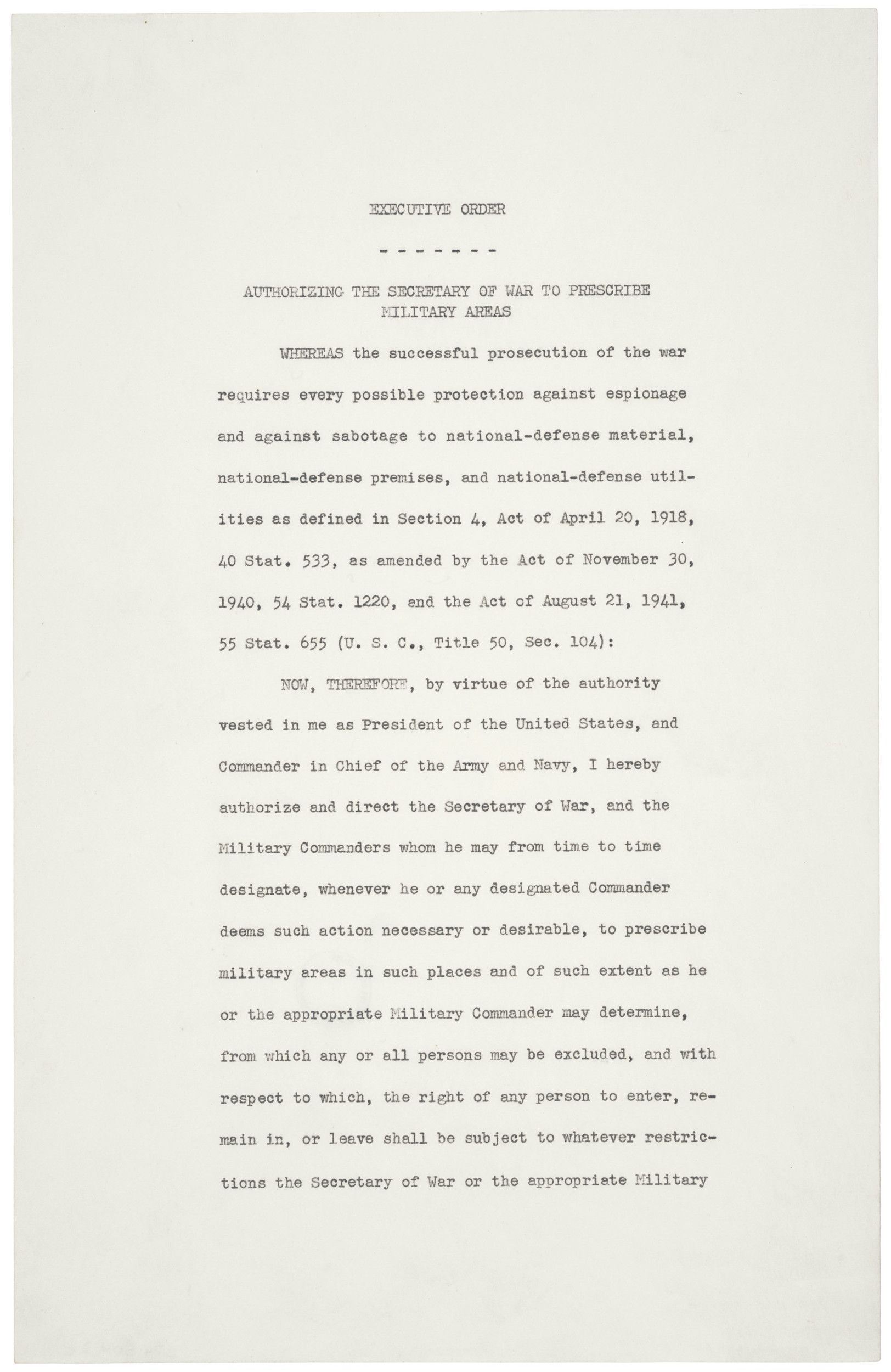
Executive Order 9066 dated February 19, 1942, in which President Franklin D. Roosevelt Authorizes the Secretary of War to Prescribe Military Areas
Page 2
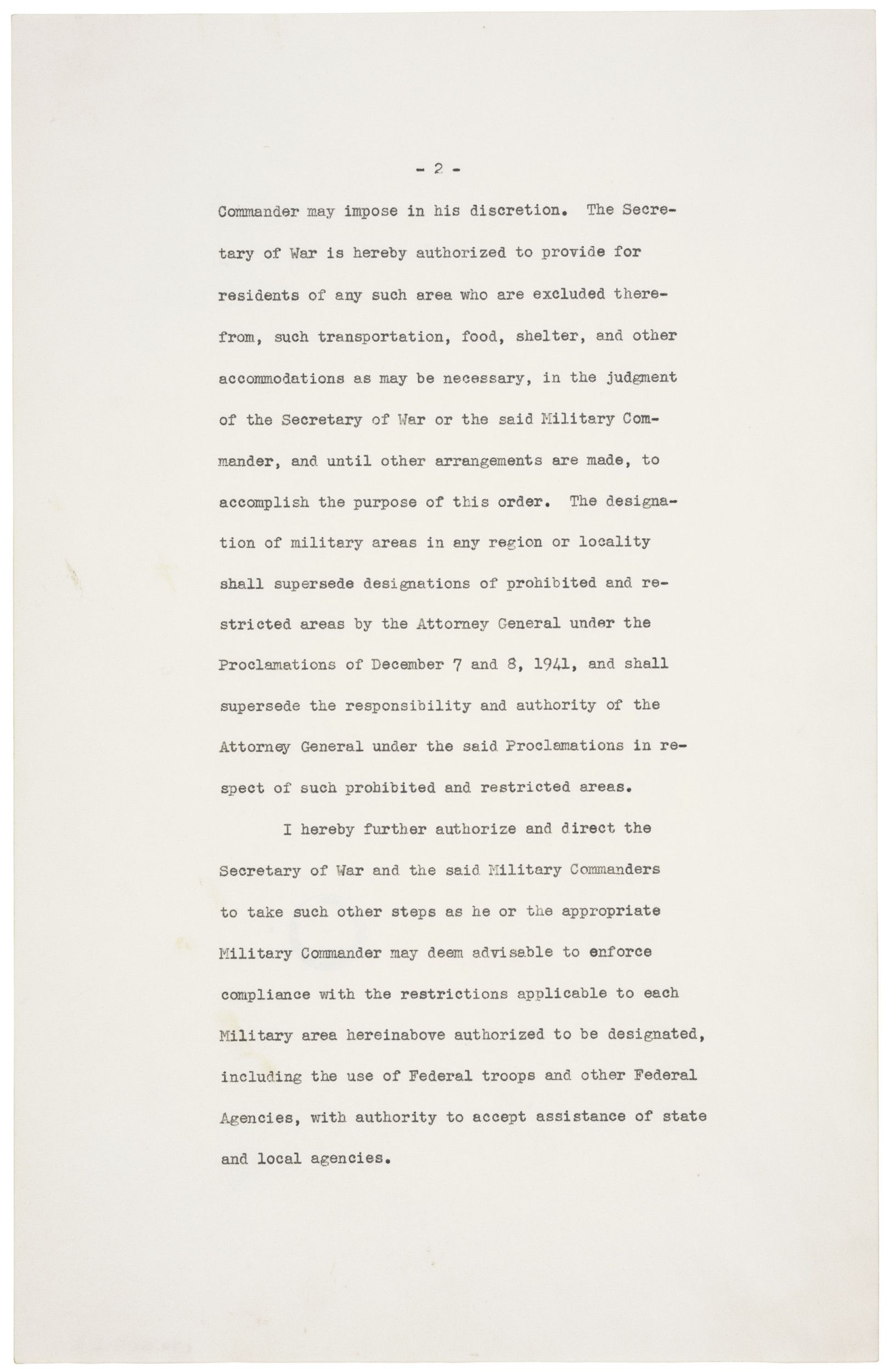
Executive Order 9066 dated February 19, 1942, in which President Franklin D. Roosevelt Authorizes the Secretary of War to Prescribe Military Areas
Page 3
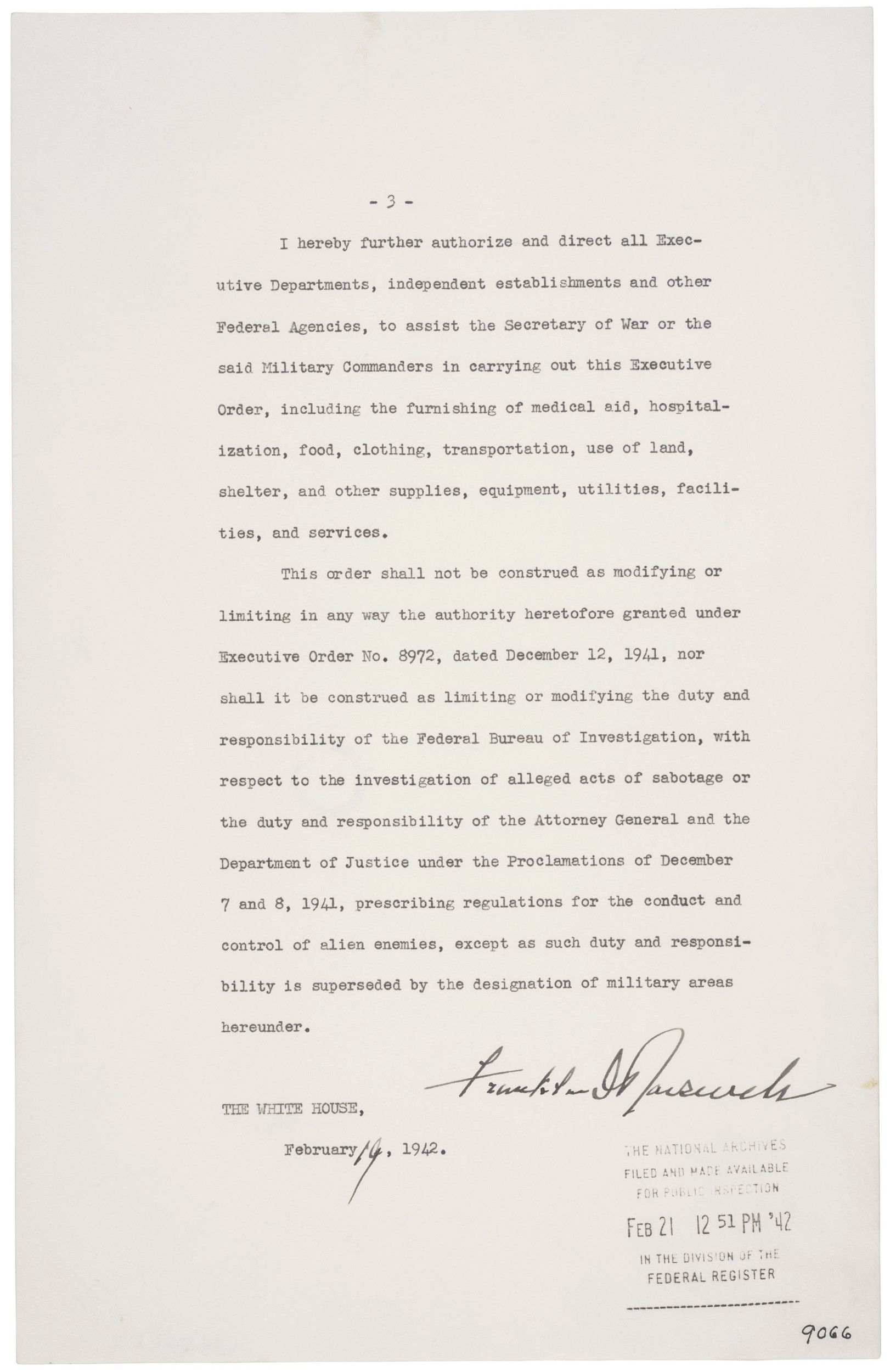
Document
Transcript of Telephone Conversation between Secretary of the Treasury Henry Morgenthau, Jr. and President Franklin D. Roosevelt
12/7/1941
This is a transcript of a conversation between Treasury Secretary Henry Morgenthau, Jr., and President Franklin D. Roosevelt on the evening of December 7, 1941, following the Japanese attack on Pearl Harbor, Hawaii.
At the time Roosevelt telephoned, Secretary Morgenthau was meeting with U.S. Secret Service Chief Frank Wilson and Assistant Secretary of the Treasury Herbert Gaston about increased security at the White House during wartime. As was typical of Morgenthau's office practice, the meeting between the three officials was being transcribed at the time Roosevelt telephoned and interrupted the meeting.
Although conversations with Roosevelt usually were not recorded or transcribed, this particular conversation was picked up by the stenographer. The conversation primarily involves a discussion of proposed actions to protect the White House. Roosevelt denies Morgenthau's request to place soldiers on the White House grounds but agrees to doubling the guard and closing traffic around the White House.
At the time Roosevelt telephoned, Secretary Morgenthau was meeting with U.S. Secret Service Chief Frank Wilson and Assistant Secretary of the Treasury Herbert Gaston about increased security at the White House during wartime. As was typical of Morgenthau's office practice, the meeting between the three officials was being transcribed at the time Roosevelt telephoned and interrupted the meeting.
Although conversations with Roosevelt usually were not recorded or transcribed, this particular conversation was picked up by the stenographer. The conversation primarily involves a discussion of proposed actions to protect the White House. Roosevelt denies Morgenthau's request to place soldiers on the White House grounds but agrees to doubling the guard and closing traffic around the White House.
Transcript
19
- 4 -
(At this point, the President came on the wire and the following is their conversation:) [handwritten: copy in President's Book.]
The President: Hello, Henry. Cabinet at 8:30.
HM Jr: Yes, sir. I have some orders which we are getting out. I cleared all of them with Welles.
The President: Fine.
HM Jr: We are freezing all Japanese funds.
The President: Yes.
HM Jr: We are not going to let any Japanese leave the country or to carry on any communications.
The President: I see.
HM Jr: Well, our responsibility is the border.
The President: Yes, Yes. That's right.
HM Jr: And we're putting people into all the Japanese banks and business houses tonight and we're not going to let the Japanese get in there at all.
The President: That's good.
HM Jr: Now the other thing I would like - Chief Wilson and Gaston are here.
The President: Yes.
HM Jr: We would like permission to put a detail of soldiers on the White House grounds.
The President: Well, wait just a second. Steve Early said something about that. (Slight pause while President talks aside.)
This primary source comes from the Collection FDR-MORGEN: Henry Morgenthau, Jr. Papers.
National Archives Identifier: 593228
Full Citation: Transcript of Telephone Conversation between Secretary of the Treasury Henry Morgenthau, Jr. and President Franklin D. Roosevelt; 12/7/1941; Diaries of Henry Morgenthau, Jr., 4/27/1933 - 7/21/1945; Collection FDR-MORGEN: Henry Morgenthau, Jr. Papers, ; Franklin D. Roosevelt Library, Hyde Park, NY. [Online Version, https://www.docsteach.org/documents/document/morgenthau-fdr-transcript, April 19, 2024]Transcript of Telephone Conversation between Secretary of the Treasury Henry Morgenthau, Jr. and President Franklin D. Roosevelt
Page 2

Document
Letter to Mr. Paul T. Bannai, Executive Director of the Commission on Wartime Relocation and Internment of Civilians, from John McCloy
7/24/1981
In 1980, Congress appointed a Commission on Wartime Relocation and Internment of Civilians to conduct an official study into Japanese-American internment during World War II. John McCloy, Assistant Secretary of War during World War II, sent this letter to Mr. Paul T. Bannai, executive director of the commission, expressing his willingness to testify regarding the "relocation" program.
McCloy wrote that "it is important to keep in mind it was a relocation program and not an internment or punitive measure." And "I hope the Commission will find, as I believe to be the case, that the whole operation was as benignly conducted as wartime conditions permitted....[that] the action of the President of the United States and the United States Government in regard to our then Japanese population was reasonably undertaken and thoughtfully and humanely conducted."
This document was digitized by teachers in our Primarily Teaching 2013 Summer Workshop in Washington, DC.
McCloy wrote that "it is important to keep in mind it was a relocation program and not an internment or punitive measure." And "I hope the Commission will find, as I believe to be the case, that the whole operation was as benignly conducted as wartime conditions permitted....[that] the action of the President of the United States and the United States Government in regard to our then Japanese population was reasonably undertaken and thoughtfully and humanely conducted."
This document was digitized by teachers in our Primarily Teaching 2013 Summer Workshop in Washington, DC.
This primary source comes from the Records of Temporary Committees, Commissions, and Boards.
National Archives Identifier: 29915382
Full Citation: Letter to Mr. Paul T. Bannai, Executive Director of the Commission on Wartime Relocation and Internment of Civilians, from John McCloy; 7/24/1981; McCloy, John, 1981 - 1983; Numerical Files, 1981 - 1983; Records of Temporary Committees, Commissions, and Boards, ; National Archives at College Park, College Park, MD. [Online Version, https://www.docsteach.org/documents/document/letter-to-bannai, April 19, 2024]Letter to Mr. Paul T. Bannai, Executive Director of the Commission on Wartime Relocation and Internment of Civilians, from John McCloy
Page 1
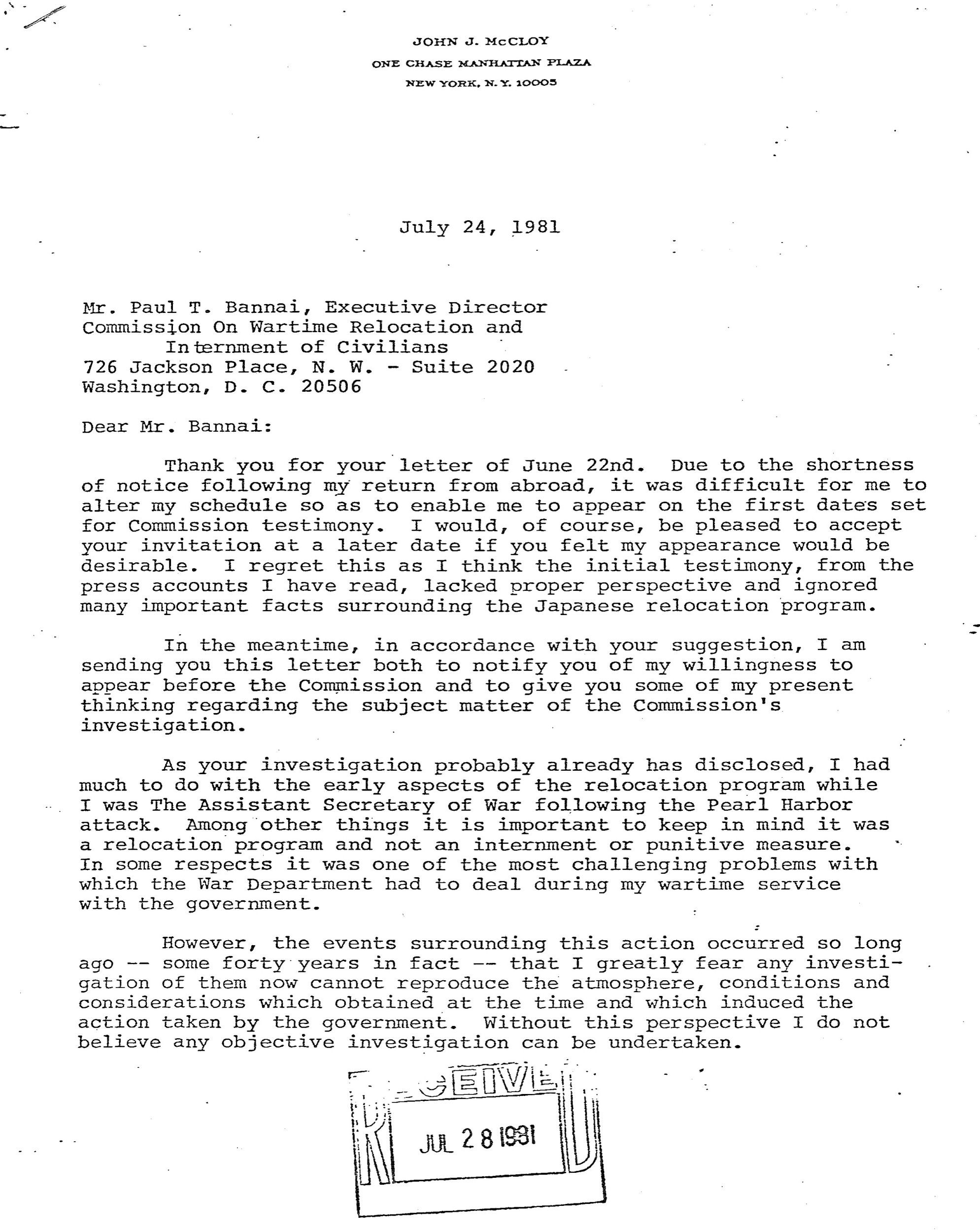
Letter to Mr. Paul T. Bannai, Executive Director of the Commission on Wartime Relocation and Internment of Civilians, from John McCloy
Page 2
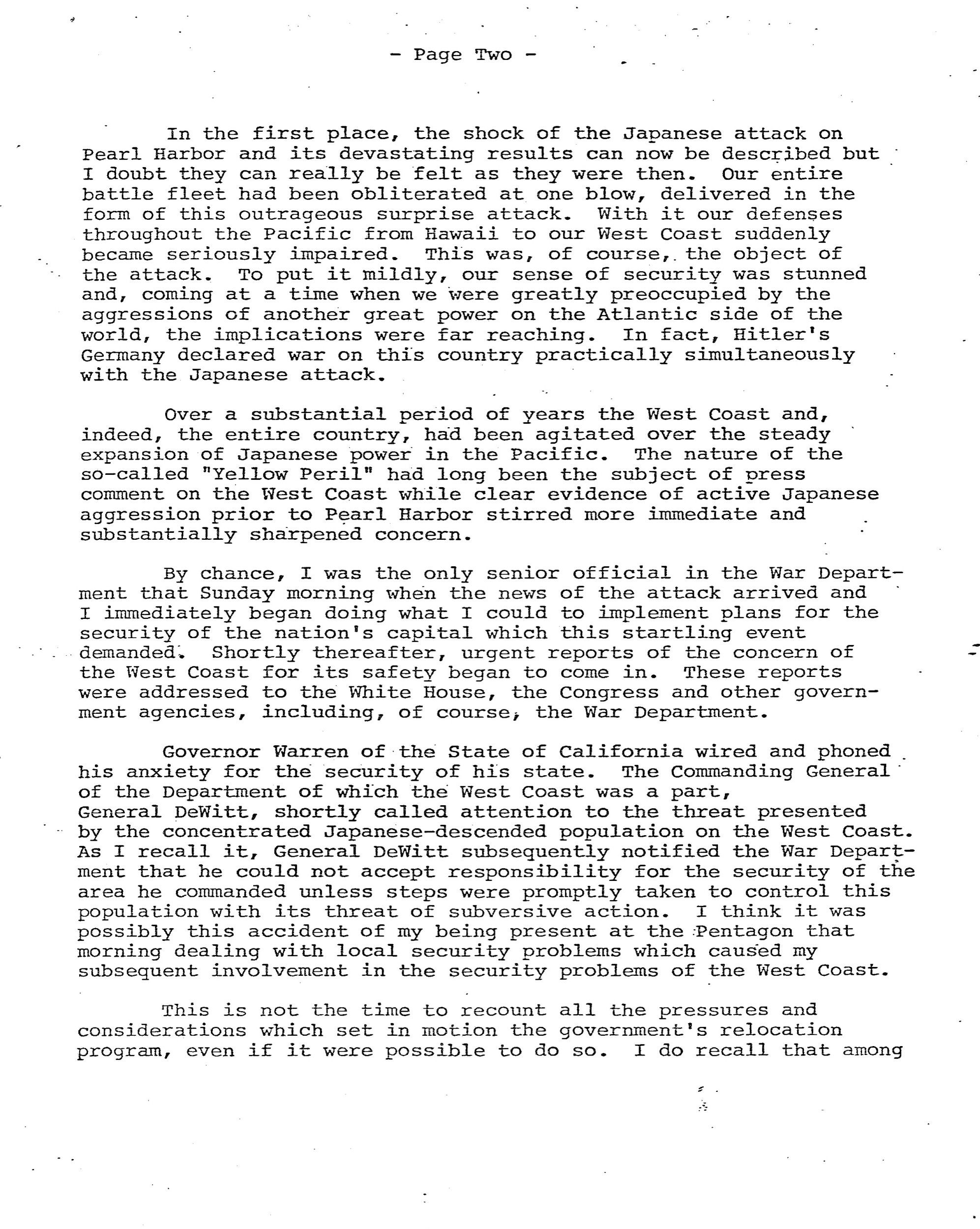
Letter to Mr. Paul T. Bannai, Executive Director of the Commission on Wartime Relocation and Internment of Civilians, from John McCloy
Page 3
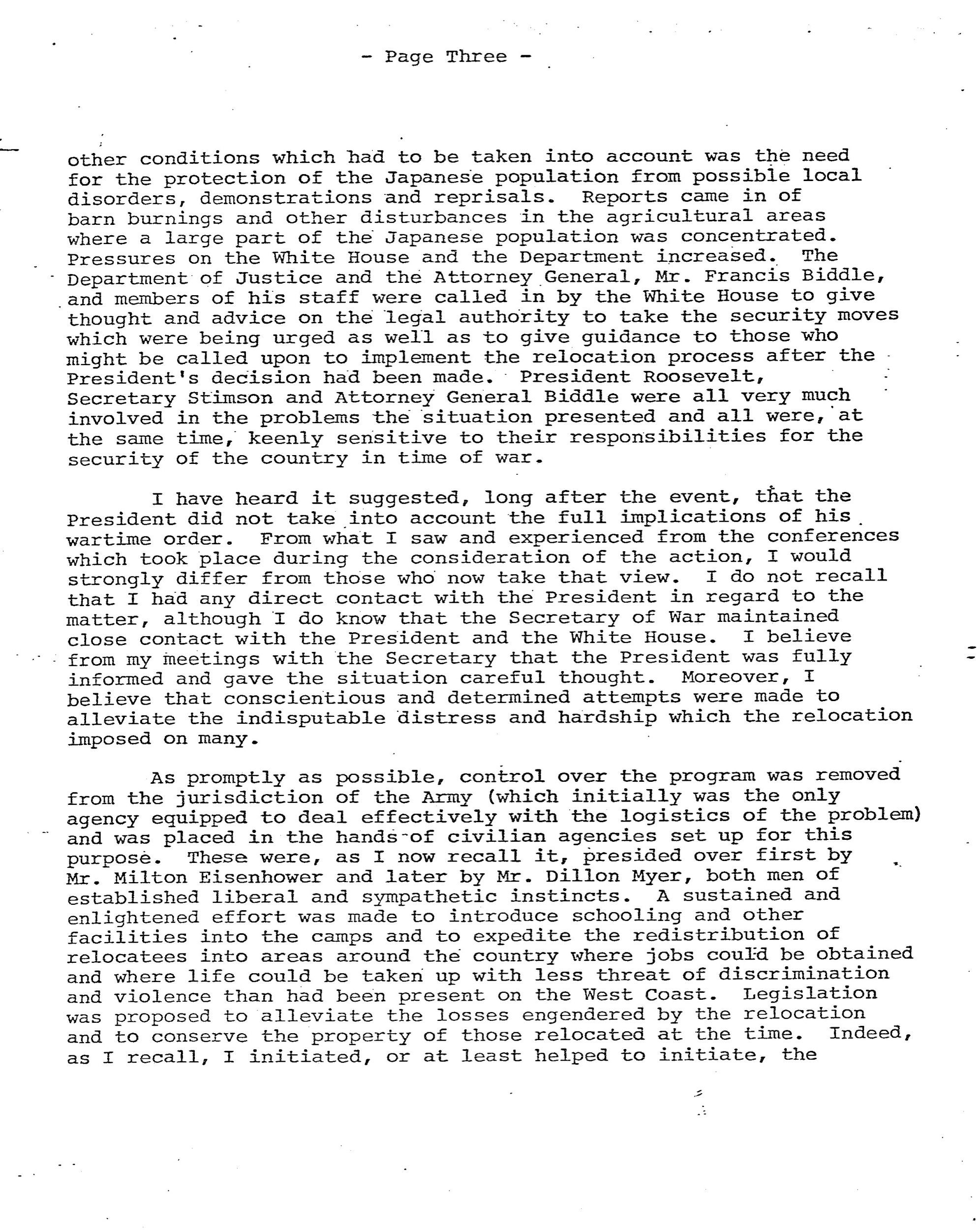
Letter to Mr. Paul T. Bannai, Executive Director of the Commission on Wartime Relocation and Internment of Civilians, from John McCloy
Page 4
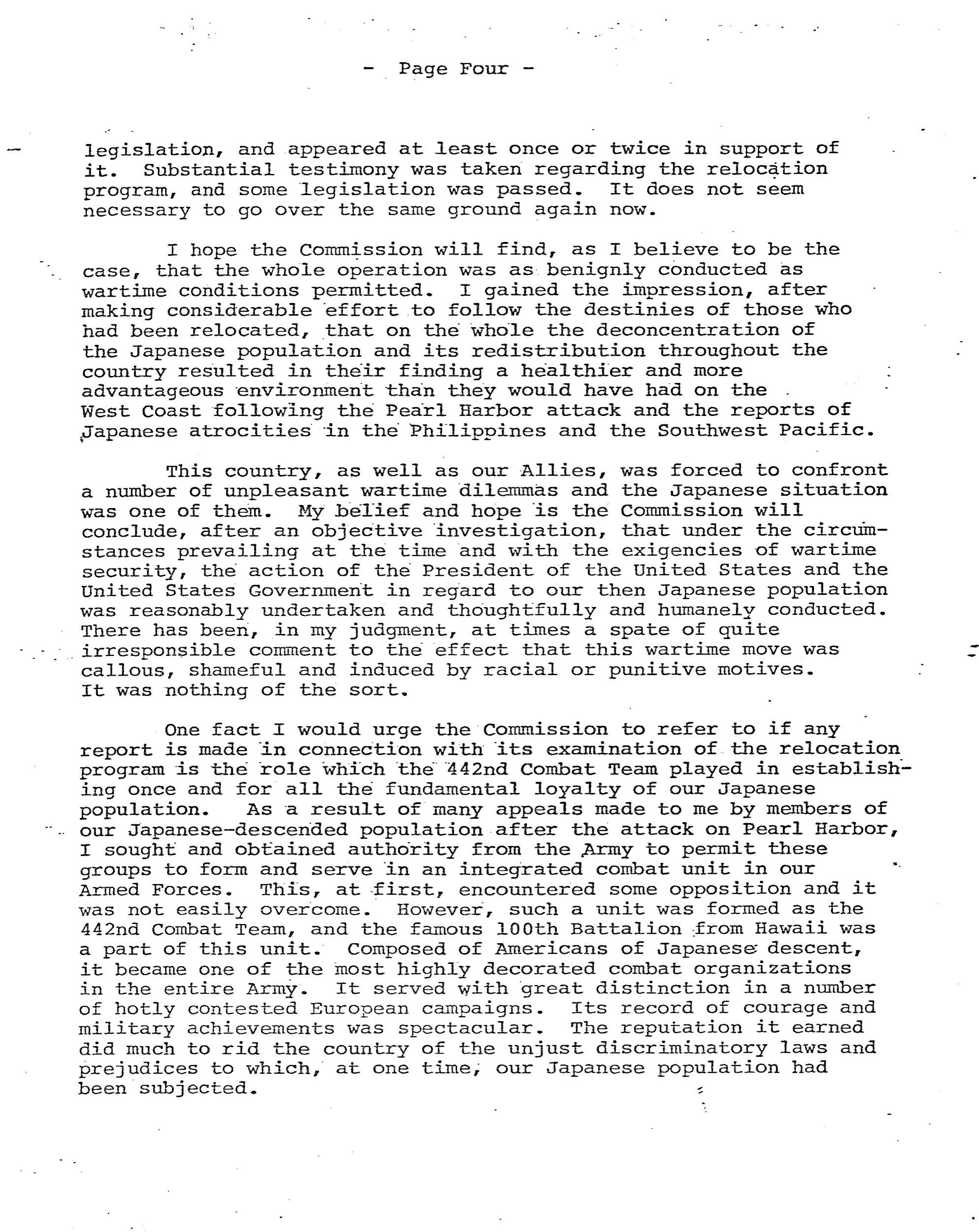
Letter to Mr. Paul T. Bannai, Executive Director of the Commission on Wartime Relocation and Internment of Civilians, from John McCloy
Page 5
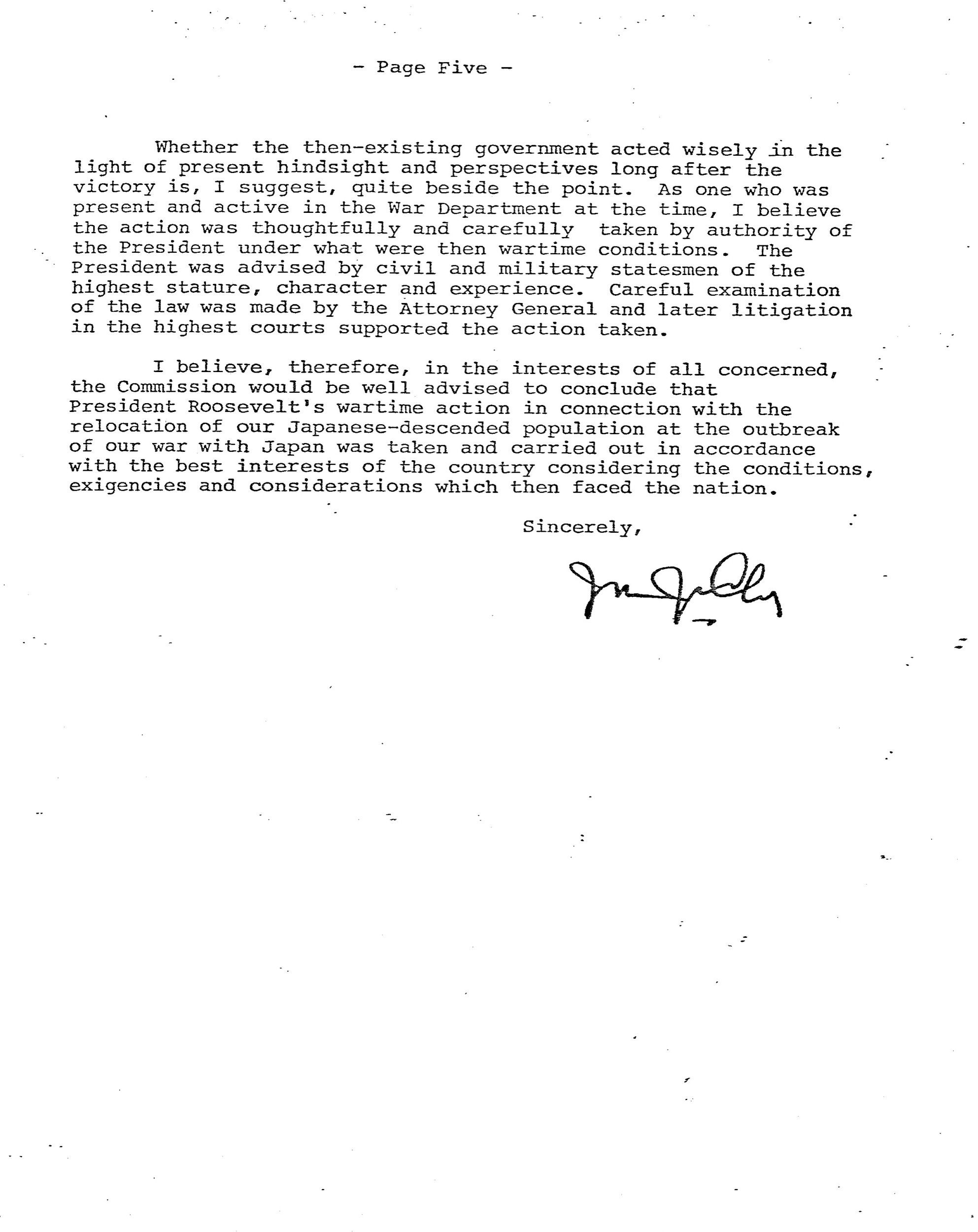
Document
Exhibit L: Copy of 'Conference with General De Witt'
1/4/1942
This document is a transcription of a meeting between Lieutenant General John L. DeWitt and representatives of the Department of Justice and the Army who had traveled to San Francisco, California, to meet with him at the Office of Commanding General, Headquarters, Western Defense Command and Fourth Army.
In this conversation, General DeWitt stated his concern with "enemy aliens" on the West Coast, especially in relation to defense installations and factories. The meeting took place one month before President Franklin Delano Roosevelt issued Executive Order 9066 that resulted in the internment of Japanese Americans.
About Japanese-Americans, he said "I have no confidence in their loyalty whatsoever." (He was speaking about both foreign born, called issei, and U.S.-born American citizens, called nisei.) He wanted blanket search and seizure authority "without waiting for normal processes of the law" and "to go in and search the house or residence and premises of every alien beginning with the Japanese right now."
This document was filed as Exhibit L in the case of United States v. Korematsu, which was a criminal action brought against Japanese-American Fred Korematsu for resisting relocation and internment as an enemy alien during World War II. His conviction in 1942 was affirmed by the Supreme Court in 1944. In 1983, Korematsu succeeded in winning a court order which vacated and recognized the injustice of the original conviction, and in the process, the injustice of the World War II Japanese internment program.
In this conversation, General DeWitt stated his concern with "enemy aliens" on the West Coast, especially in relation to defense installations and factories. The meeting took place one month before President Franklin Delano Roosevelt issued Executive Order 9066 that resulted in the internment of Japanese Americans.
About Japanese-Americans, he said "I have no confidence in their loyalty whatsoever." (He was speaking about both foreign born, called issei, and U.S.-born American citizens, called nisei.) He wanted blanket search and seizure authority "without waiting for normal processes of the law" and "to go in and search the house or residence and premises of every alien beginning with the Japanese right now."
This document was filed as Exhibit L in the case of United States v. Korematsu, which was a criminal action brought against Japanese-American Fred Korematsu for resisting relocation and internment as an enemy alien during World War II. His conviction in 1942 was affirmed by the Supreme Court in 1944. In 1983, Korematsu succeeded in winning a court order which vacated and recognized the injustice of the original conviction, and in the process, the injustice of the World War II Japanese internment program.
This primary source comes from the Records of District Courts of the United States.
National Archives Identifier: 296057
Full Citation: Exhibit L: Copy of 'Conference with General De Witt'; 1/4/1942; United States v. Korematsu; Criminal Case Files, ca. 1851 - 1986; Records of District Courts of the United States, ; National Archives at San Francisco, San Bruno, CA. [Online Version, https://www.docsteach.org/documents/document/conference-de-witt, April 19, 2024]Exhibit L: Copy of 'Conference with General De Witt'
Page 1
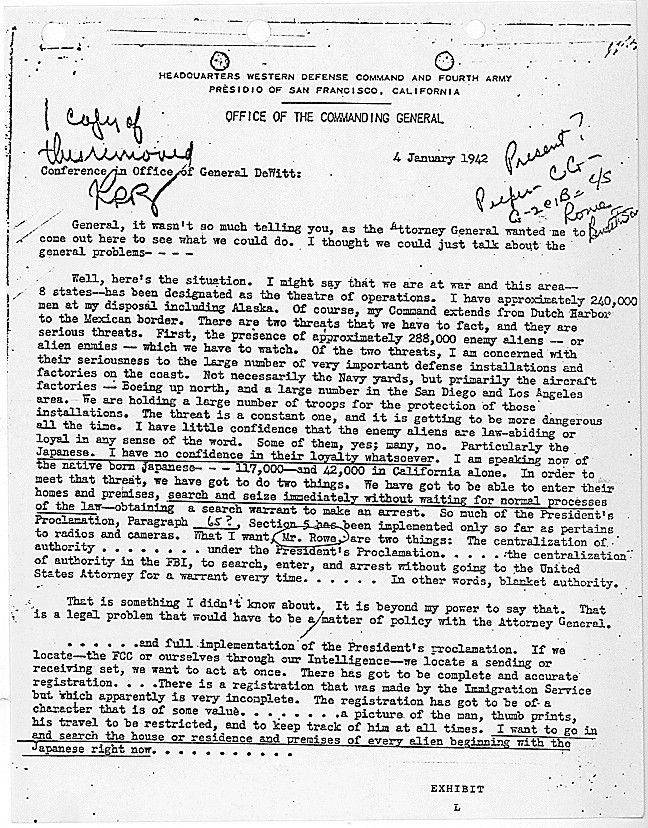
Exhibit L: Copy of 'Conference with General De Witt'
Page 2

Exhibit L: Copy of 'Conference with General De Witt'
Page 3
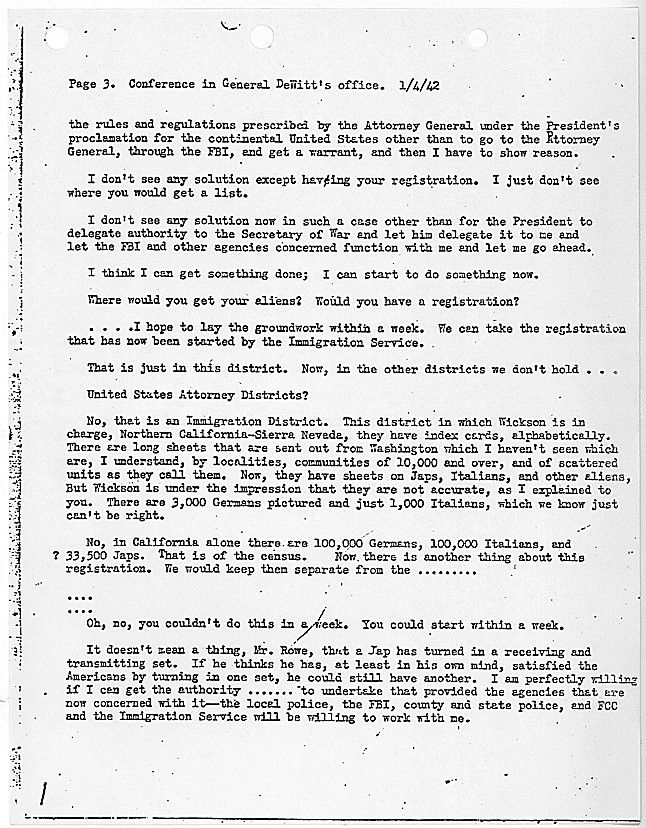
Exhibit L: Copy of 'Conference with General De Witt'
Page 4
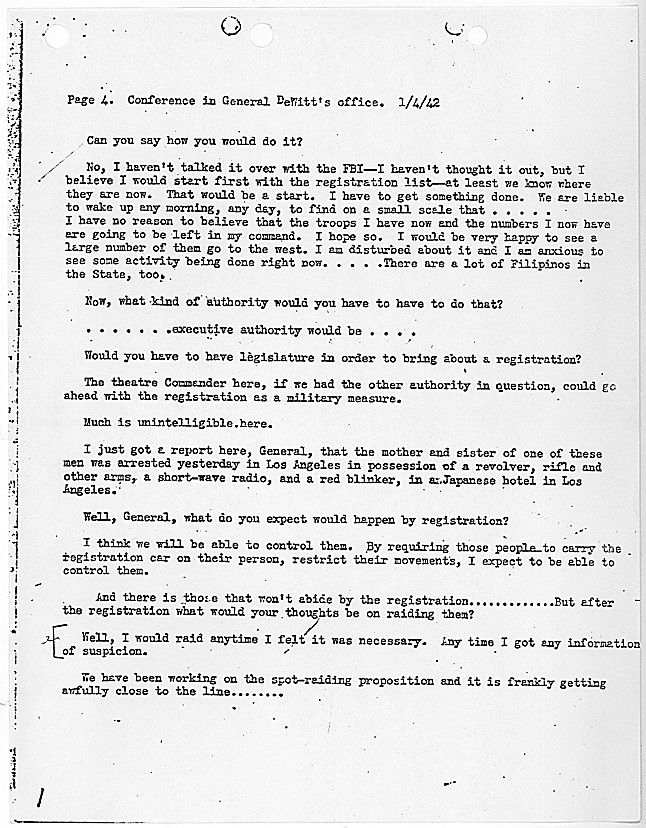
Exhibit L: Copy of 'Conference with General De Witt'
Page 5
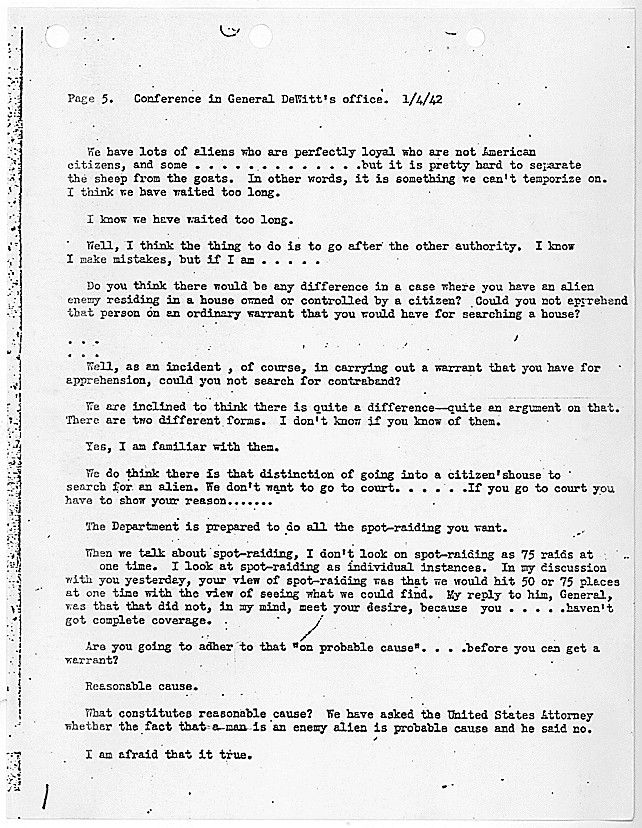
Exhibit L: Copy of 'Conference with General De Witt'
Page 6
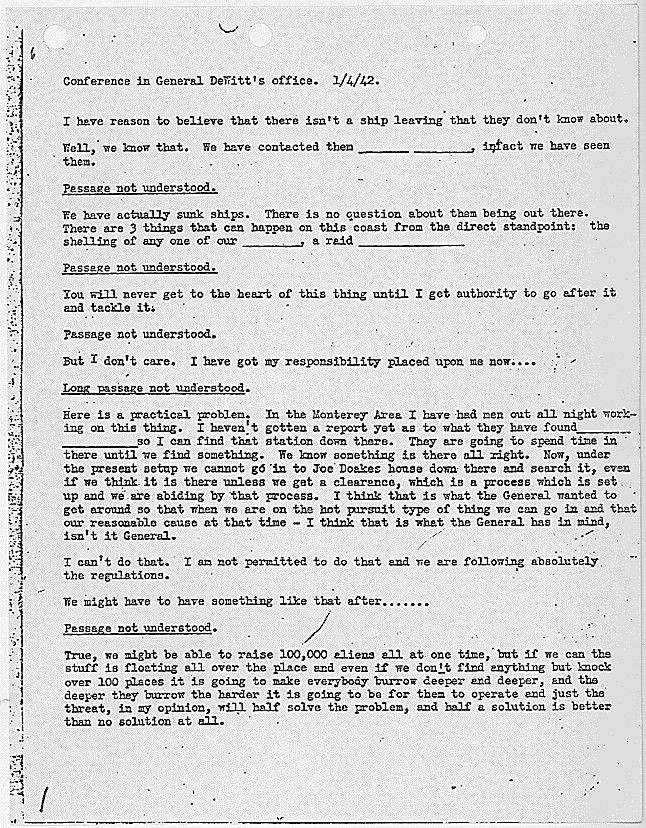
Exhibit L: Copy of 'Conference with General De Witt'
Page 7

Exhibit L: Copy of 'Conference with General De Witt'
Page 8
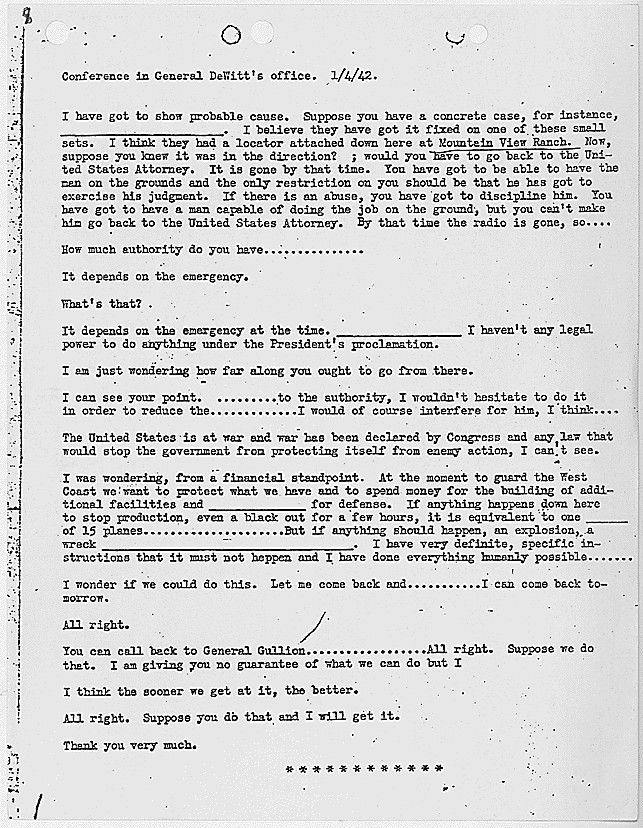
Document
Final Report: Japanese Evacuation from the West Coast
1943
This report was written by Lieutenant General John L. DeWitt. As the commanding general of the Western Defense Command and the Fourth Army, DeWitt oversaw and orchestrated the forced removal and incarceration of Japanese-Americans in the United States during World War II.
The report provides a favorable overview of the "evacuation program" and explains the rationale and logistics from the Army's point of view. When it was submitted, it caused disagreement with the War Department over the characterization of the reasoning for the program, and a revised report was issued. Later a footnote was inserted because the Justice Department took issue with allegations about supposed Japanese-American espionage that were found to be untrue.
The document was filed as Exhibit B in the case of United States v. Korematsu, which was a criminal action brought against Japanese-American Fred Korematsu for resisting relocation and internment as an enemy alien during World War II. His conviction in 1942 was affirmed by the Supreme Court in 1944. In 1983, however, Korematsu succeeded in winning a court order that vacated and recognized the injustice of the original conviction, and in the process, the injustice of the World War II Japanese internment program.
The first four pages are shown. See the entire document in the National Archives Catalog.
The report provides a favorable overview of the "evacuation program" and explains the rationale and logistics from the Army's point of view. When it was submitted, it caused disagreement with the War Department over the characterization of the reasoning for the program, and a revised report was issued. Later a footnote was inserted because the Justice Department took issue with allegations about supposed Japanese-American espionage that were found to be untrue.
The document was filed as Exhibit B in the case of United States v. Korematsu, which was a criminal action brought against Japanese-American Fred Korematsu for resisting relocation and internment as an enemy alien during World War II. His conviction in 1942 was affirmed by the Supreme Court in 1944. In 1983, however, Korematsu succeeded in winning a court order that vacated and recognized the injustice of the original conviction, and in the process, the injustice of the World War II Japanese internment program.
The first four pages are shown. See the entire document in the National Archives Catalog.
This primary source comes from the Records of District Courts of the United States.
National Archives Identifier: 296055
Full Citation: Final Report: Japanese Evacuation from the West Coast; 1943; United States v. Korematsu; Criminal Case Files, ca. 1851 - 1986; Records of District Courts of the United States, ; National Archives at San Francisco, San Bruno, CA. [Online Version, https://www.docsteach.org/documents/document/report-japanese-evacuation-west-coast, April 19, 2024]Final Report: Japanese Evacuation from the West Coast
Page 1
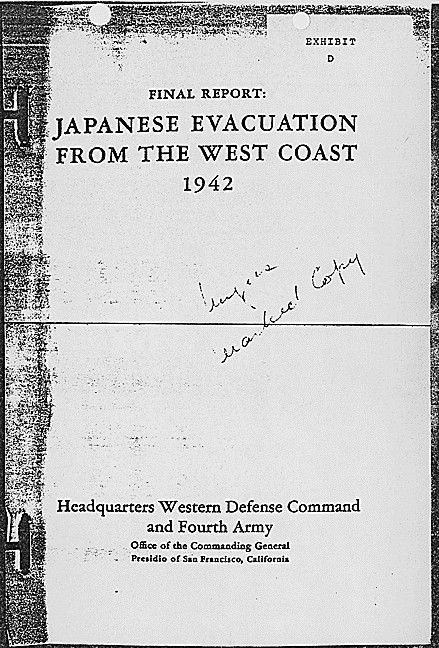
Final Report: Japanese Evacuation from the West Coast
Page 2
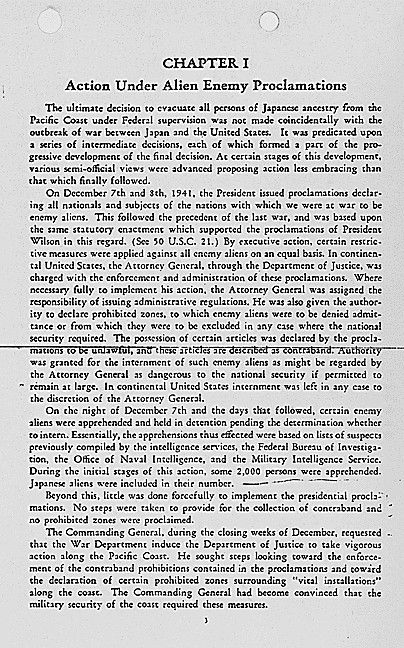
Final Report: Japanese Evacuation from the West Coast
Page 3
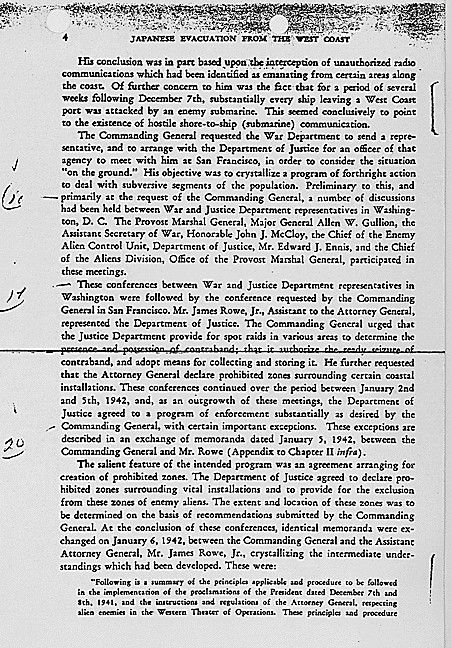
Final Report: Japanese Evacuation from the West Coast
Page 4
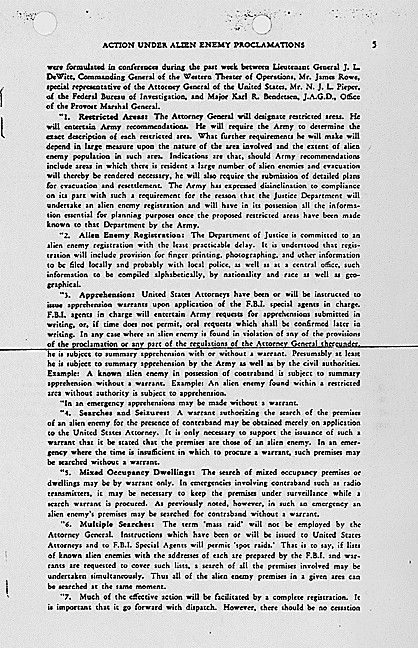
Document
[R9.20] Civilian Exclusion Order Instructions
5/3/1942
Following the attack at Pearl Harbor on December 7, 1941, government suspicion arose around persons of Japanese descent. The entire West Coast was deemed a military area and was divided into military zones. President Franklin D. Roosevelt's Executive Order 9066 authorized military commanders to exclude civilians from military areas.
Although the language of the executive order did not specify any ethnic group, Lieutenant General John L. DeWitt of the Western Defense Command proceeded to announce curfews that included only Japanese Americans. Next, he encouraged voluntary evacuation by Japanese Americans from a limited number of areas; about seven percent of the total Japanese American population in the "military areas" complied. On March 29, 1942, under the authority of the executive order, DeWitt issued Public Proclamation No. 4, which began the forced evacuation and detention of West Coast residents of Japanese-American ancestry on a 48-hour notice.
The document seen here ordered that "all persons of Japanese ancestry, both alien and non-alien, be excluded" from a section of Los Angeles, California. This land was part of "Military Area No. 1," that included western Washington and Oregon, southern Arizona, and western California from the Oregon border to Los Angeles and the area south of Los Angeles.
It describes how one member from each Japanese American family should report to the Civil Control Station at the Japanese Christian Church in L.A., and that any person who failed to comply would be liable to criminal penalties. On March 21, 1942, Congress had passed Public Law 503, which made violation of Executive Order 9066 a misdemeanor punishable by up to one year in prison and a $5,000 fine.
The document also includes "Instructions to all Persons of Japanese Ancestry" about how they will be evacuated. It says that the Civil Control Office will transport them to an "Assembly Center" and provide services with respect to the leasing, sale, or storage of their property. It also outlines rules to follow, including bringing only limited clothing and household essentials, leaving pets behind, and reporting in person for further instruction.
Although the language of the executive order did not specify any ethnic group, Lieutenant General John L. DeWitt of the Western Defense Command proceeded to announce curfews that included only Japanese Americans. Next, he encouraged voluntary evacuation by Japanese Americans from a limited number of areas; about seven percent of the total Japanese American population in the "military areas" complied. On March 29, 1942, under the authority of the executive order, DeWitt issued Public Proclamation No. 4, which began the forced evacuation and detention of West Coast residents of Japanese-American ancestry on a 48-hour notice.
The document seen here ordered that "all persons of Japanese ancestry, both alien and non-alien, be excluded" from a section of Los Angeles, California. This land was part of "Military Area No. 1," that included western Washington and Oregon, southern Arizona, and western California from the Oregon border to Los Angeles and the area south of Los Angeles.
It describes how one member from each Japanese American family should report to the Civil Control Station at the Japanese Christian Church in L.A., and that any person who failed to comply would be liable to criminal penalties. On March 21, 1942, Congress had passed Public Law 503, which made violation of Executive Order 9066 a misdemeanor punishable by up to one year in prison and a $5,000 fine.
The document also includes "Instructions to all Persons of Japanese Ancestry" about how they will be evacuated. It says that the Civil Control Office will transport them to an "Assembly Center" and provide services with respect to the leasing, sale, or storage of their property. It also outlines rules to follow, including bringing only limited clothing and household essentials, leaving pets behind, and reporting in person for further instruction.
This primary source comes from the Records of the War Relocation Authority.
National Archives Identifier: 48552006
Full Citation: [R9.20] Civilian Exclusion Order Instructions; 5/3/1942; Reel 9; San Francisco Branch Evacuee Property Files, 3/18/1942 - 6/30/1946; Records of the War Relocation Authority, ; National Archives at College Park, College Park, MD. [Online Version, https://www.docsteach.org/documents/document/civilian-exclusion-order-los-angeles, April 19, 2024][R9.20] Civilian Exclusion Order Instructions
Page 1
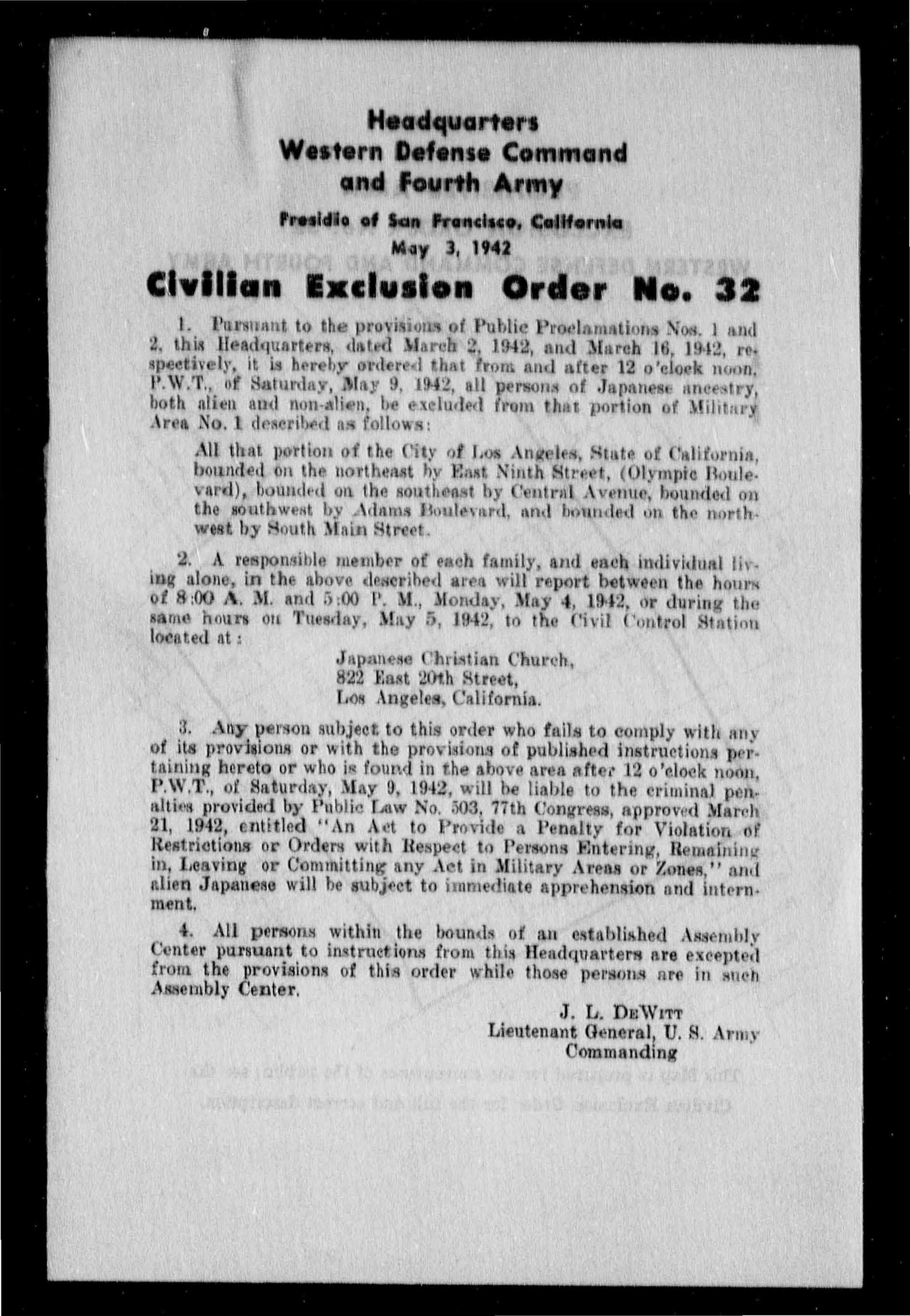
[R9.20] Civilian Exclusion Order Instructions
Page 2
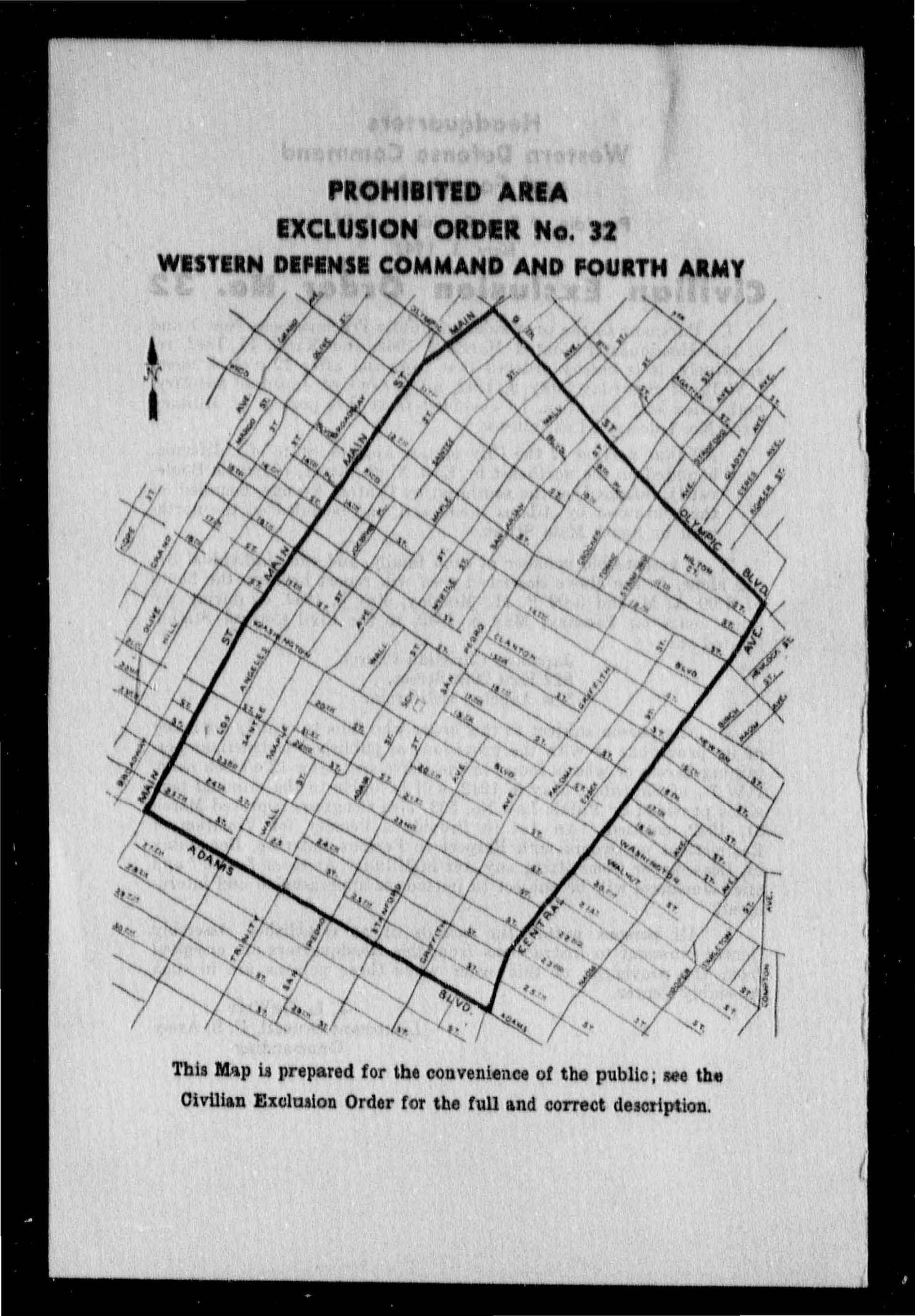
[R9.20] Civilian Exclusion Order Instructions
Page 3
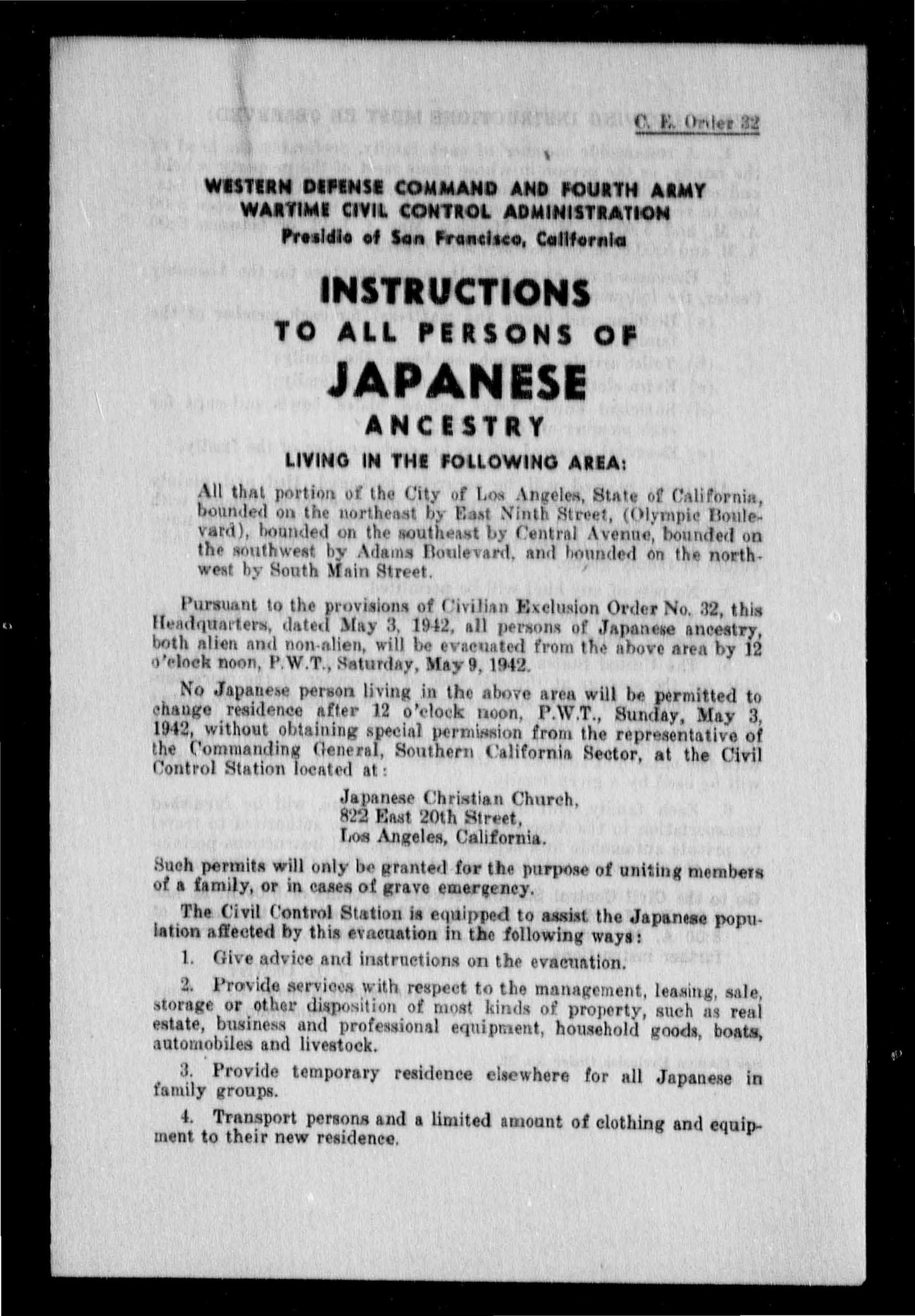
[R9.20] Civilian Exclusion Order Instructions
Page 4

Document
An Act of March 21, 1942, Public Law 77-503, 56 STAT 173, to Provide a Penalty for Violation of Restrictions or Orders with Respect to Persons Entering, Remaining in, Leaving, or Committing Any Act in Military Areas or Zones
3/21/1942
On February 19, 1942, President Franklin D. Roosevelt issued Executive Order 9066 authorizing military commanders to exclude civilians from military areas. Although the language of the order did not specify any ethnic group, Lieutenant General John L. DeWitt of the Western Defense Command proceeded to announce curfews that included only Japanese Americans.
On March 29, 1942, under the authority of the executive order, DeWitt issued Public Proclamation No. 4, which began the controlled, involuntary evacuation and detention of West Coast residents of Japanese American ancestry on a 48-hour notice.
Just prior to the posting of DeWitt's proclamation, on March 21, 1942, Congress had passed Public Law 503, which made violation of Executive Order 9066 a misdemeanor punishable by up to one year in prison and a $5,000 fine. This document is that act: Public Law 77-503, 56 STAT 173, "To provide a penalty for violation of restrictions or orders with respect to persons entering, remaining in, leaving, or committing any act in military areas or zones."
On March 29, 1942, under the authority of the executive order, DeWitt issued Public Proclamation No. 4, which began the controlled, involuntary evacuation and detention of West Coast residents of Japanese American ancestry on a 48-hour notice.
Just prior to the posting of DeWitt's proclamation, on March 21, 1942, Congress had passed Public Law 503, which made violation of Executive Order 9066 a misdemeanor punishable by up to one year in prison and a $5,000 fine. This document is that act: Public Law 77-503, 56 STAT 173, "To provide a penalty for violation of restrictions or orders with respect to persons entering, remaining in, leaving, or committing any act in military areas or zones."
This primary source comes from the General Records of the United States Government.
National Archives Identifier: 5730387
Full Citation: An Act of March 21, 1942, Public Law 77-503, 56 STAT 173, to Provide a Penalty for Violation of Restrictions or Orders with Respect to Persons Entering, Remaining in, Leaving, or Committing Any Act in Military Areas or Zones; 3/21/1942 ; 77th Congress, 2nd Session; Enrolled Acts and Resolutions of Congress, 1789 - 2011; General Records of the United States Government, ; National Archives Building, Washington, DC. [Online Version, https://www.docsteach.org/documents/document/enforcement-executive-order-9066, April 19, 2024]An Act of March 21, 1942, Public Law 77-503, 56 STAT 173, to Provide a Penalty for Violation of Restrictions or Orders with Respect to Persons Entering, Remaining in, Leaving, or Committing Any Act in Military Areas or Zones
Page 1
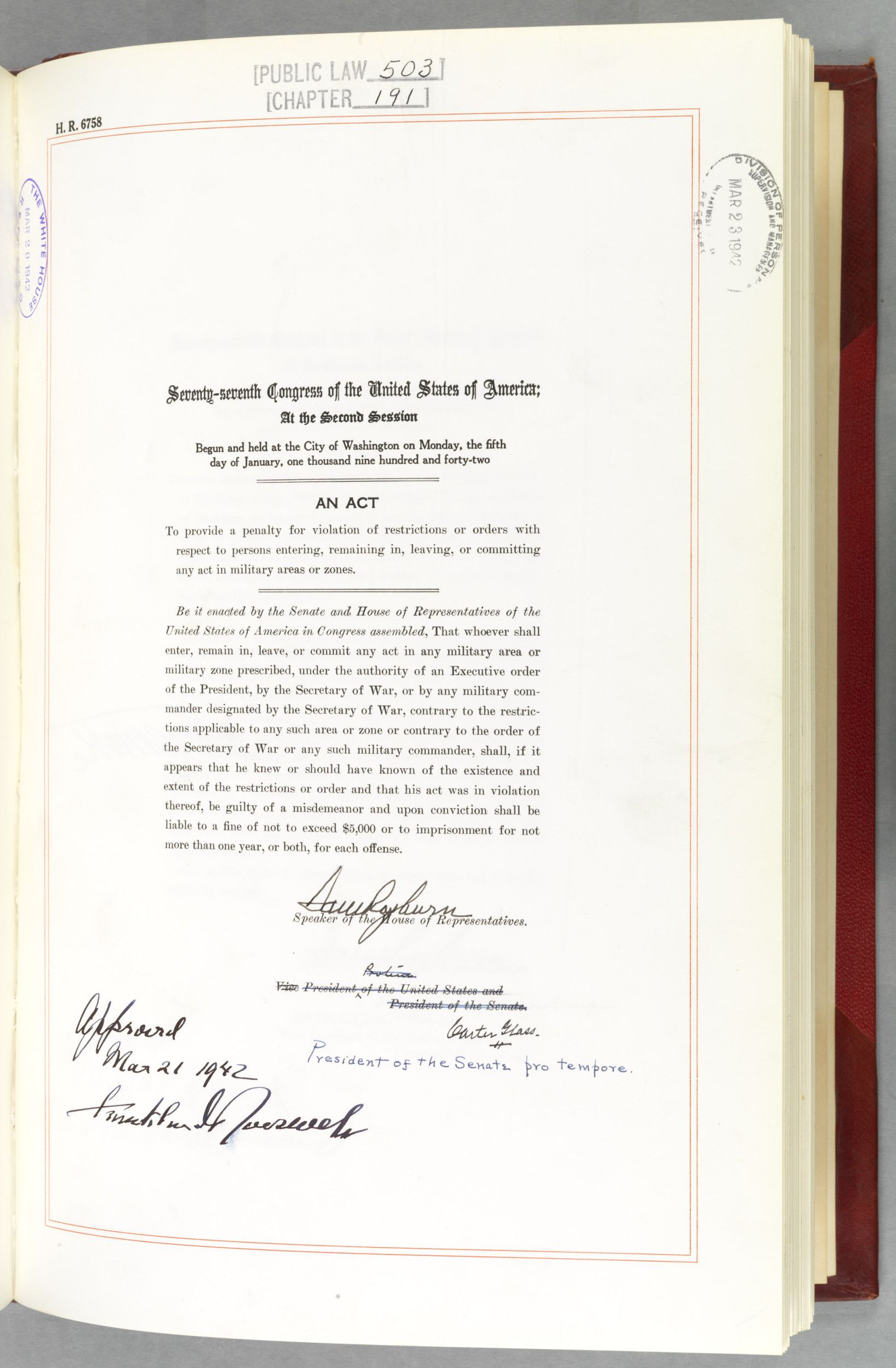
Document
San Francisco, California. Civilian Exclusion Order Number 5, Ordering Evacuation of Residents of Japanese Ancestry
4/4/1942
The original caption for this photograph, taken by photographer Dorothea Lange for the War Relocation Authority, reads: "San Francisco, California. Civilian Exclusion Order Number 5, ordering evacuation of residents of Japanese ancestry, posted in a vacant store window on Grant Avenue in Chinatown. This establishment, like many others in Chinatown, was operated by proprietors of Japanese descent. Evacuees will be housed in War Relocation Authority centers for the duration."
Following the attack at Pearl Harbor on December 7, 1941, government suspicion arose around persons of Japanese descent. The entire West Coast was deemed a military area and was divided into military zones. President Franklin D. Roosevelt's Executive Order 9066 authorized military commanders to exclude civilians from military areas.
Although the language of the executive order did not specify any ethnic group, Lieutenant General John L. DeWitt of the Western Defense Command proceeded to announce curfews that included only Japanese Americans. Next, he encouraged voluntary evacuation by Japanese Americans from a limited number of areas; about seven percent of the total Japanese American population complied. On March 29, 1942, under the authority of the executive order, DeWitt issued Public Proclamation No. 4, which began the forced evacuation and detention of West Coast residents of Japanese-American ancestry on a 48-hour notice.
Following the attack at Pearl Harbor on December 7, 1941, government suspicion arose around persons of Japanese descent. The entire West Coast was deemed a military area and was divided into military zones. President Franklin D. Roosevelt's Executive Order 9066 authorized military commanders to exclude civilians from military areas.
Although the language of the executive order did not specify any ethnic group, Lieutenant General John L. DeWitt of the Western Defense Command proceeded to announce curfews that included only Japanese Americans. Next, he encouraged voluntary evacuation by Japanese Americans from a limited number of areas; about seven percent of the total Japanese American population complied. On March 29, 1942, under the authority of the executive order, DeWitt issued Public Proclamation No. 4, which began the forced evacuation and detention of West Coast residents of Japanese-American ancestry on a 48-hour notice.
This primary source comes from the Records of the War Relocation Authority.
National Archives Identifier: 536452
Full Citation: Photograph 210-G-A561; San Francisco, California. Civilian Exclusion Order Number 5, Ordering Evacuation of Residents of Japanese Ancestry; 4/4/1942; Central Photographic File of the War Relocation Authority, 1942 - 1945; Records of the War Relocation Authority, ; National Archives at College Park, College Park, MD. [Online Version, https://www.docsteach.org/documents/document/exclusion-order-san-francisco, April 19, 2024]San Francisco, California. Civilian Exclusion Order Number 5, Ordering Evacuation of Residents of Japanese Ancestry
Page 1
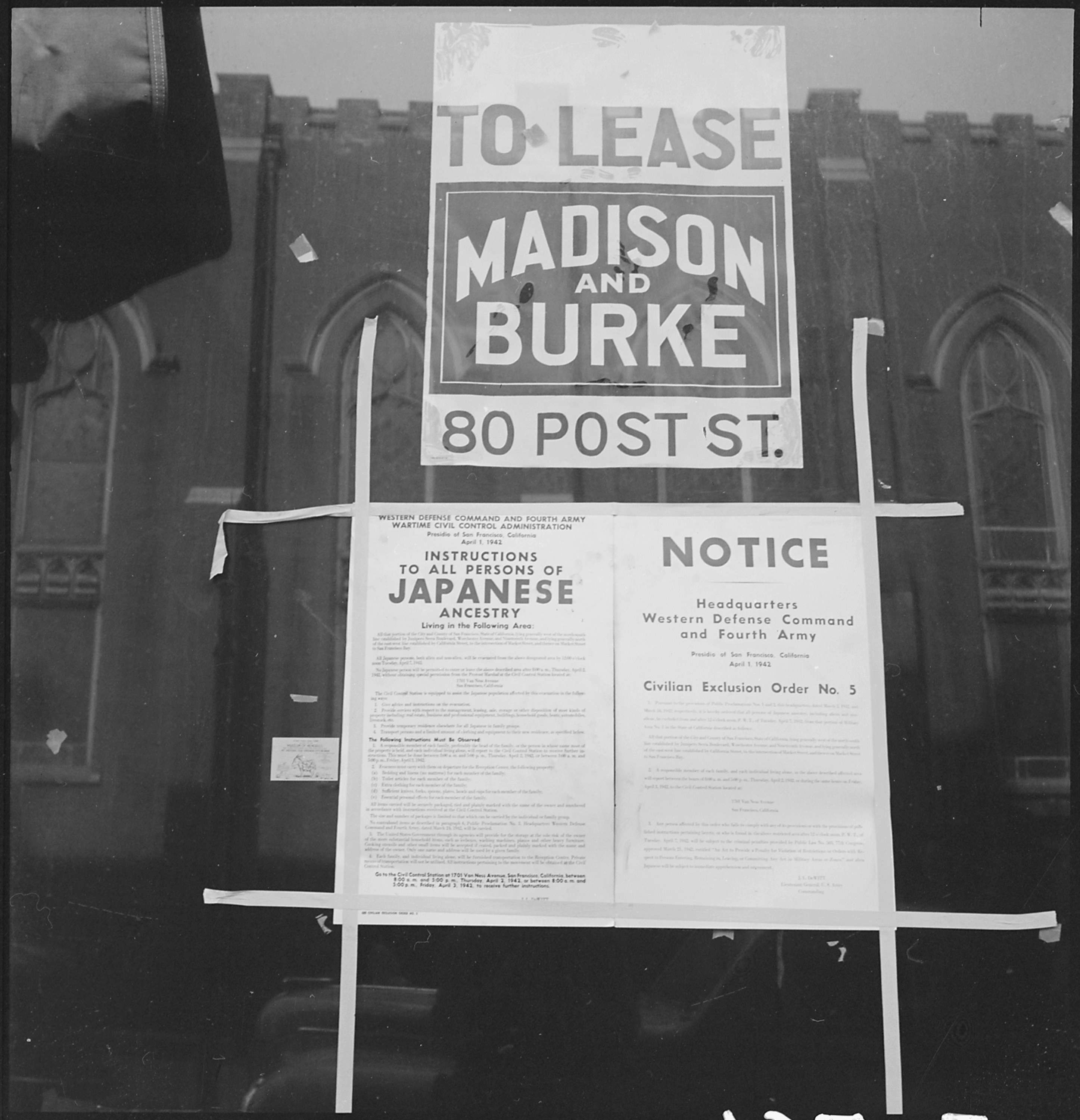
Document
San Francisco, California. Japanese family heads and persons living alone form a line outside Civil Control Station
4/25/1942
The original caption for this photograph, taken by photographer Dorothea Lange for the War Relocation Authority, reads: San Francisco, California. Japanese family heads and persons living alone, form a line outside Civil Control Station located in the Japanese American Citizens League Auditorium at 2031 Bush Street, to appear for "processing" in response to Civilian Exclusion Order Number 20.
This primary source comes from the Records of the War Relocation Authority.
National Archives Identifier: 536422
Full Citation: Photograph 210-G-A530; San Francisco, California. Japanese family heads and persons living alone form a line outside Civil Control Station; 4/25/1942; Central Photographic File of the War Relocation Authority, 1942 - 1945; Records of the War Relocation Authority, ; National Archives at College Park, College Park, MD. [Online Version, https://www.docsteach.org/documents/document/line-civil-control-station, April 19, 2024]San Francisco, California. Japanese family heads and persons living alone form a line outside Civil Control Station
Page 1
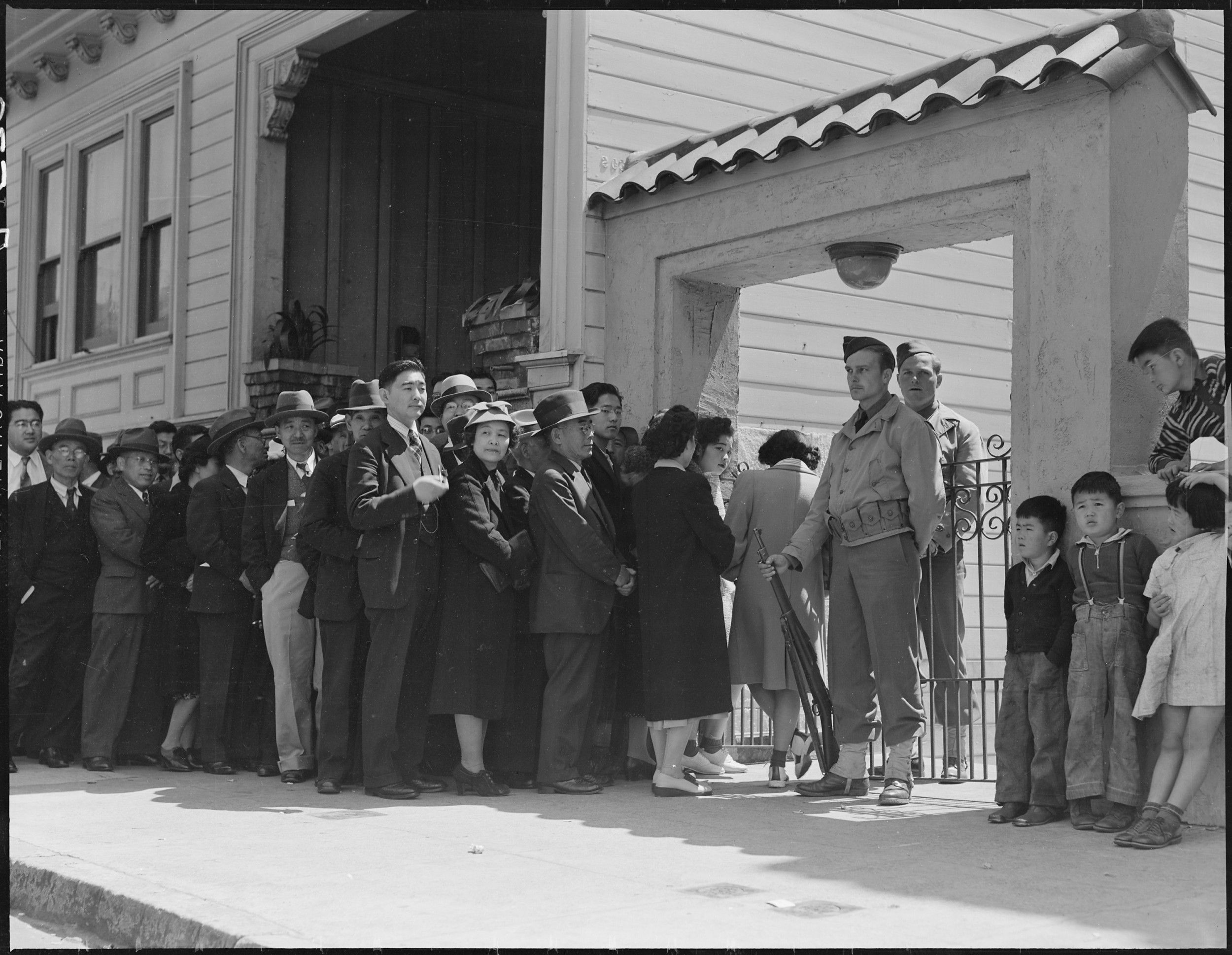
Document
San Francisco, California. Residents of Japanese ancestry file forms containing personal data, two days before evacuation.
4/4/1942
The original caption for this photograph, taken by photographer Dorothea Lange, reads: San Francisco, California. Residents of Japanese ancestry file forms containing personal data, two days before evacuation, at Wartime Civil Control Administration station. Evacuees will be housed in War Relocation Authority centers for the duration.
This primary source comes from the Records of the War Relocation Authority.
National Archives Identifier: 536056
Full Citation: Photograph 210-G-A81; San Francisco, California. Residents of Japanese ancestry file forms containing personal data, two days before evacuation.; 4/4/1942; Central Photographic File of the War Relocation Authority, 1942 - 1945; Records of the War Relocation Authority, ; National Archives at College Park, College Park, MD. [Online Version, https://www.docsteach.org/documents/document/residents-file-forms, April 19, 2024]San Francisco, California. Residents of Japanese ancestry file forms containing personal data, two days before evacuation.
Page 1

Document
Hayward, California. Two children of the Mochida family who, with their parents, are awaiting evacuation bus.
5/8/1942
In March 1942, under the authority of President Franklin D. Roosevelt's Executive Order 9066, the U.S. Army began the forced evacuation and detention of West Coast residents of Japanese-American ancestry. From the end of March to August, approximately 112,000 persons were sent to "assembly centers" – often racetracks or fairgrounds – where they waited and were tagged to indicate the location of a long-term "relocation center" that would be their home for the rest of the war. Nearly 70,000 of the evacuees were American citizens. There were no charges of disloyalty against any of these citizens, nor was there any vehicle by which they could appeal their loss of property and personal liberty.
The original caption for this photograph, taken by photographer Dorothea Lange for the War Relocation Authority, reads: "Hayward, California. Two children of the Mochida family who, with their parents, are awaiting evacuation bus. The youngster on the right holds a sandwich given her by one of a group of women who were present from a local Church. The family unit is kept intact during evacuation and at War Relocation Authority centers where evacuees of Japanese ancestry will be housed for the duration."
The original caption for this photograph, taken by photographer Dorothea Lange for the War Relocation Authority, reads: "Hayward, California. Two children of the Mochida family who, with their parents, are awaiting evacuation bus. The youngster on the right holds a sandwich given her by one of a group of women who were present from a local Church. The family unit is kept intact during evacuation and at War Relocation Authority centers where evacuees of Japanese ancestry will be housed for the duration."
This primary source comes from the Records of the War Relocation Authority.
National Archives Identifier: 537507
Full Citation: Photograph 210-G-C155; Hayward, California. Two children of the Mochida family who, with their parents, are awaiting evacuation bus.; 5/8/1942; Central Photographic File of the War Relocation Authority, 1942 - 1945; Records of the War Relocation Authority, ; National Archives at College Park, College Park, MD. [Online Version, https://www.docsteach.org/documents/document/mochida-children, April 19, 2024]Hayward, California. Two children of the Mochida family who, with their parents, are awaiting evacuation bus.
Page 1
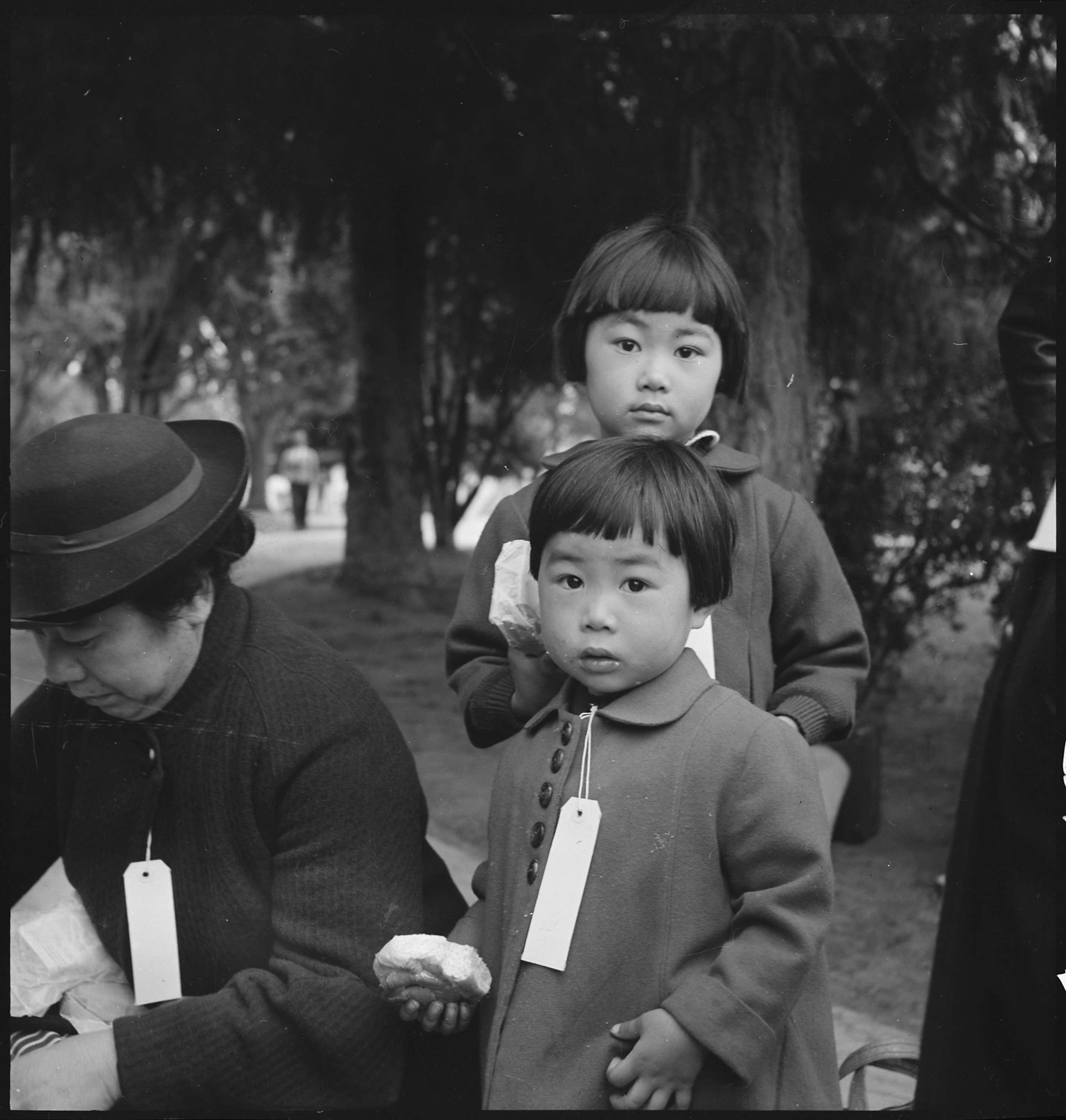
Document
San Francisco, California. With baggage stacked, residents of Japanese ancestry await bus at Wartime. . .
4/6/1942
The original caption for this photograph, taken by photographer Dorothea Lange, reads: San Francisco, California. With baggage stacked, residents of Japanese ancestry await bus at Wartime Civil Control Administration station, 2020 Van Ness Avenue, as part of the first group of 664 to be evacuated from San Francisco on April 6, 1942. Evacuees will be housed in War Relocation Authority centers for the duration.
This primary source comes from the Records of the War Relocation Authority.
National Archives Identifier: 536065
Full Citation: Photograph 210-G-A92; San Francisco, California. With baggage stacked, residents of Japanese ancestry await bus at Wartime. . .; 4/6/1942; Central Photographic File of the War Relocation Authority, 1942 - 1945; Records of the War Relocation Authority, ; National Archives at College Park, College Park, MD. [Online Version, https://www.docsteach.org/documents/document/await-bus-with-baggage, April 19, 2024]San Francisco, California. With baggage stacked, residents of Japanese ancestry await bus at Wartime. . .
Page 1
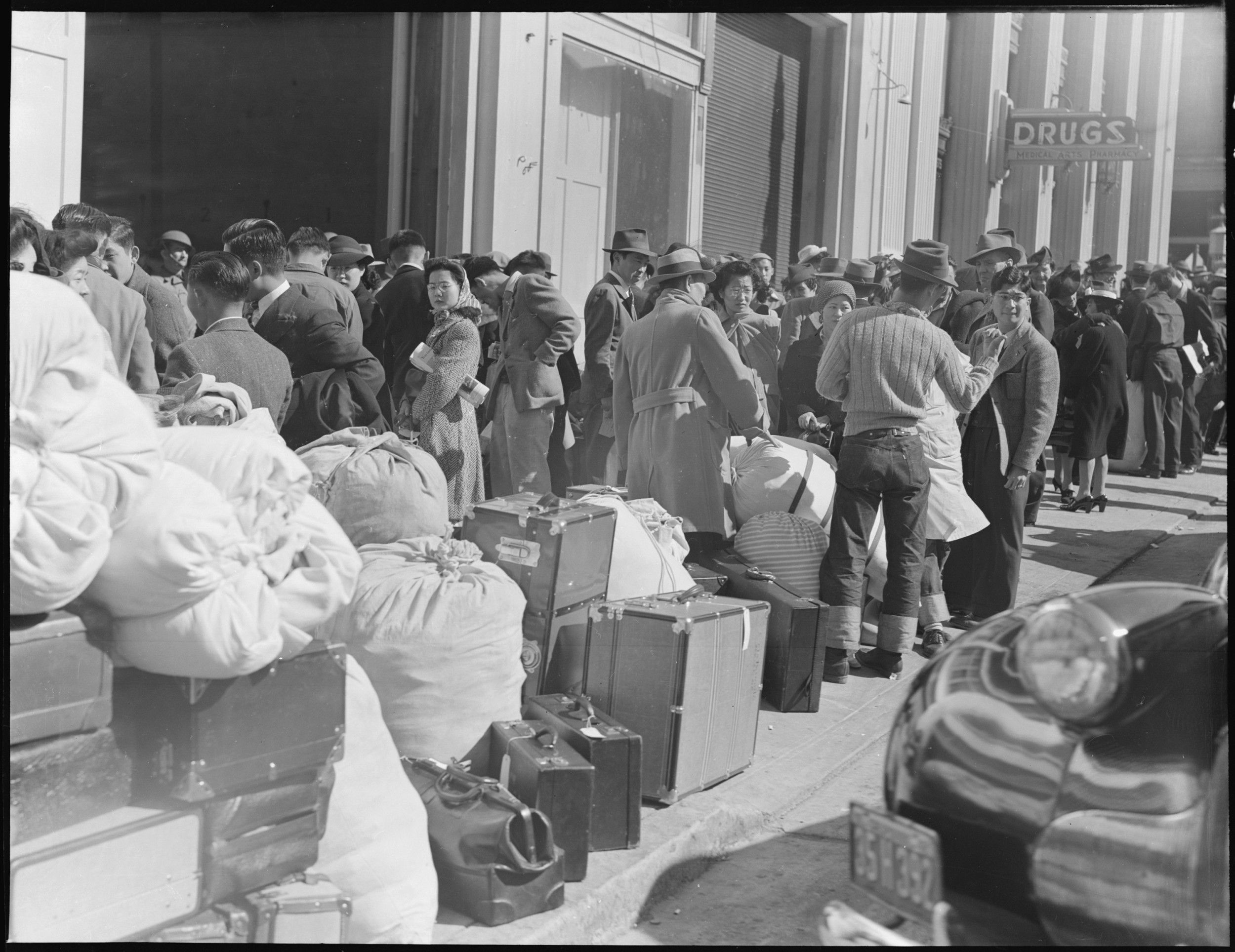
Document
Los Angeles, California. Mr. and Mrs. K. Tseri have closed their drugstore
4/11/1942
The original caption for this photograph reads: Los Angeles, California. Mr. and Mrs. K. Iseri have closed their drugstore in preparation for the forthcoming evacuation from their "Little Tokyo" in Los Angeles.
Transcript
[sign in window:]Many thanks for your patronage. Hope to serve you in near future. God be with you till we meet again.
Mr. and Mrs. K. Iseri
[written on photograph:]
Iseri Pharmacy
4-11-42 - Los Angeles "Little Tokyo" Closed -
This primary source comes from the Records of the War Relocation Authority.
National Archives Identifier: 536001
Full Citation: Photograph 210-G-A1; Los Angeles, California. Mr. and Mrs. K. Tseri have closed their drugstore; 4/11/1942; Central Photographic File of the War Relocation Authority, 1942 - 1945; Records of the War Relocation Authority, ; National Archives at College Park, College Park, MD. [Online Version, https://www.docsteach.org/documents/document/iseri-drugstore, April 19, 2024]Los Angeles, California. Mr. and Mrs. K. Tseri have closed their drugstore
Page 1
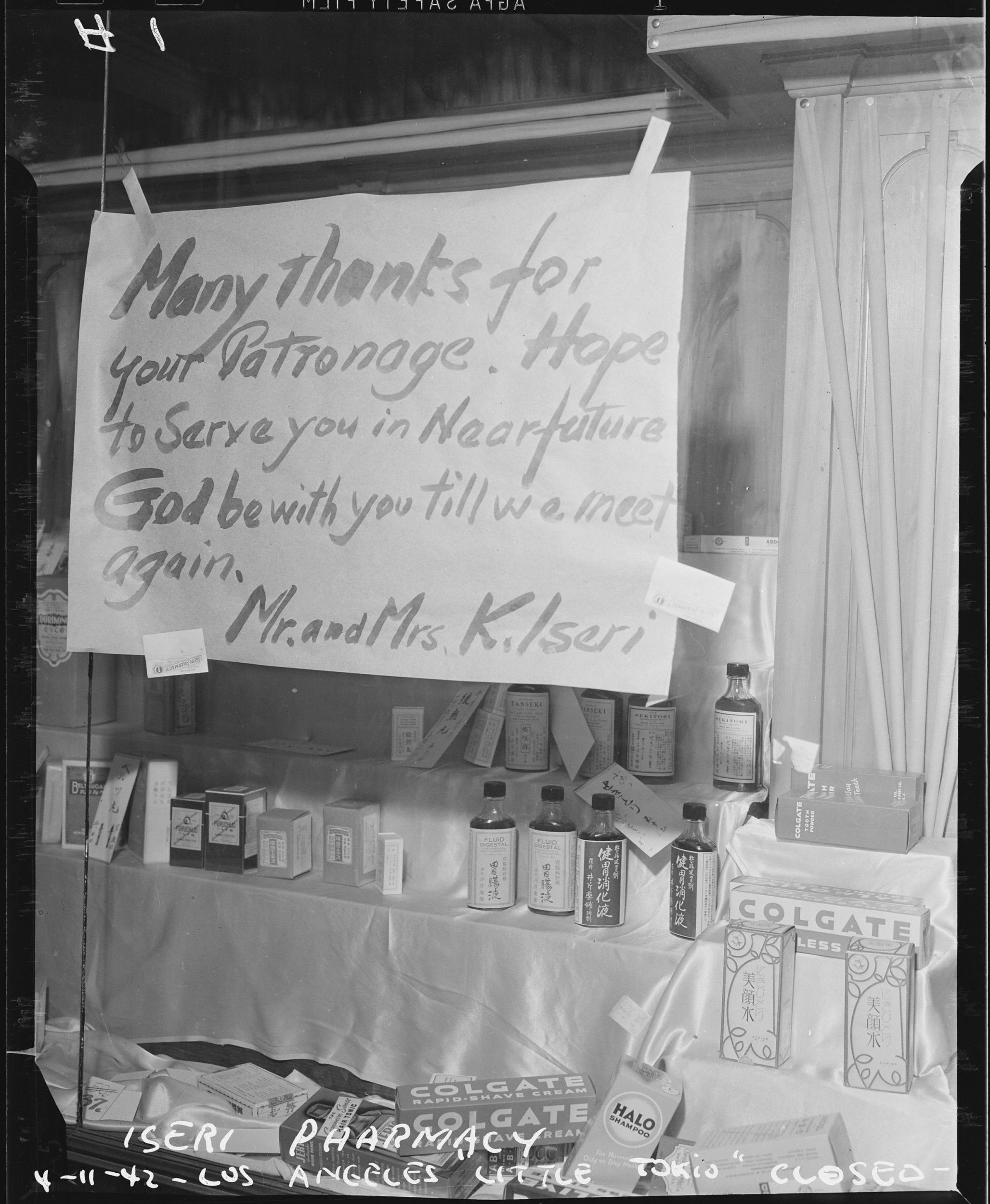
Document
Report on Japanese-Americans in Relocation Centers
3/1943
This report about the forced removal and incarceration of Japanese Americans to "relocation centers" (or "internment camps") was prepared by the War Relocation Authority (WRA), the federal government agency that was created to handle the program.
This document was identified by teachers in our Primarily Teaching 2016 Summer Workshop at the Truman Library.
This document was identified by teachers in our Primarily Teaching 2016 Summer Workshop at the Truman Library.
This primary source comes from the Collection HST-PN: Philleo Nash Papers.
National Archives Identifier: 40019800
Full Citation: Report on Japanese-Americans in Relocation Centers; 3/1943; Minorities-Japanese-War Relocation Authority-News Stories, 1943-1944; White House Files, 1936 - 1953; Collection HST-PN: Philleo Nash Papers, ; Harry S. Truman Library, Independence, MO. [Online Version, https://www.docsteach.org/documents/document/report-japanese-americans-relocation-centers, April 19, 2024]Report on Japanese-Americans in Relocation Centers
Page 1
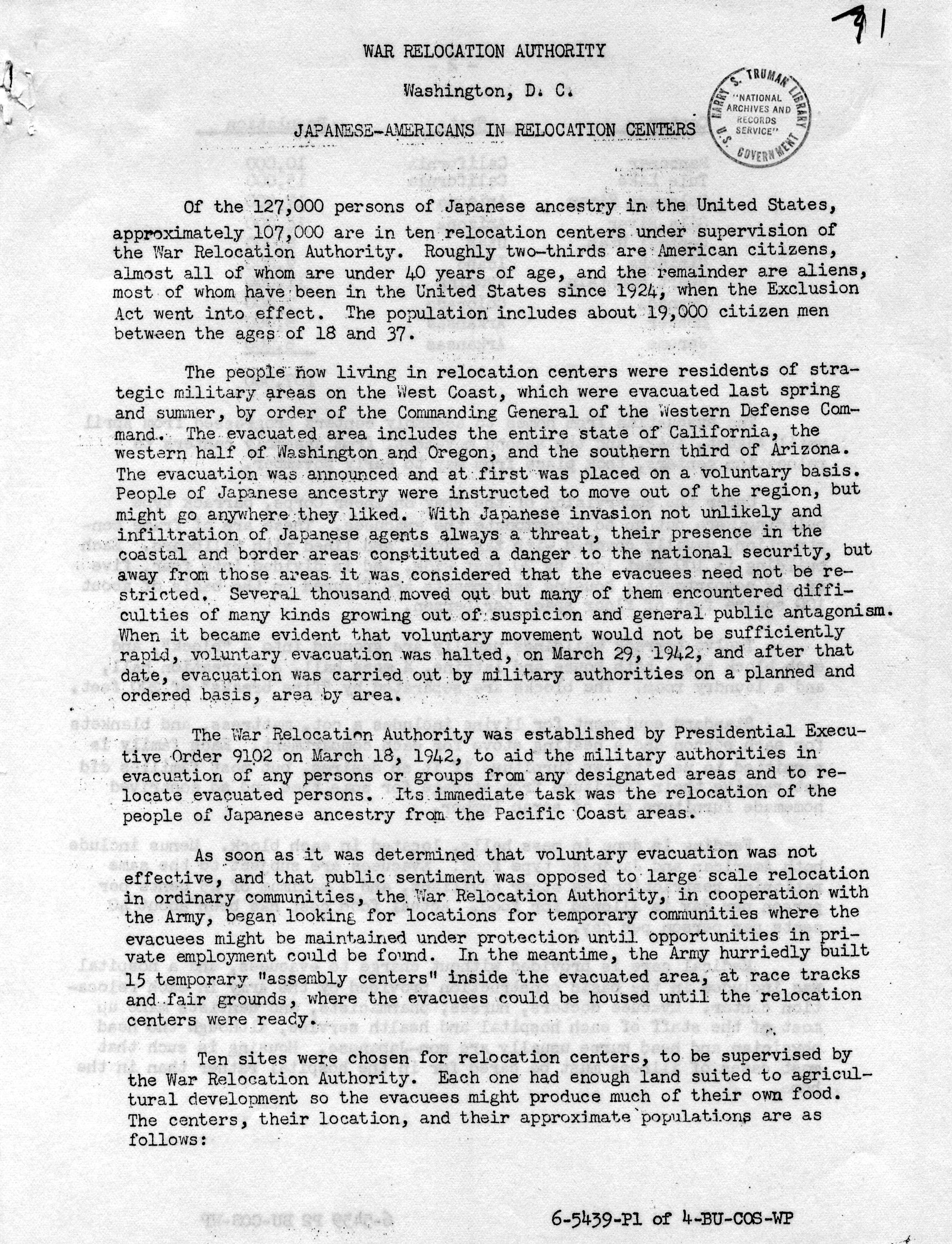
Report on Japanese-Americans in Relocation Centers
Page 2
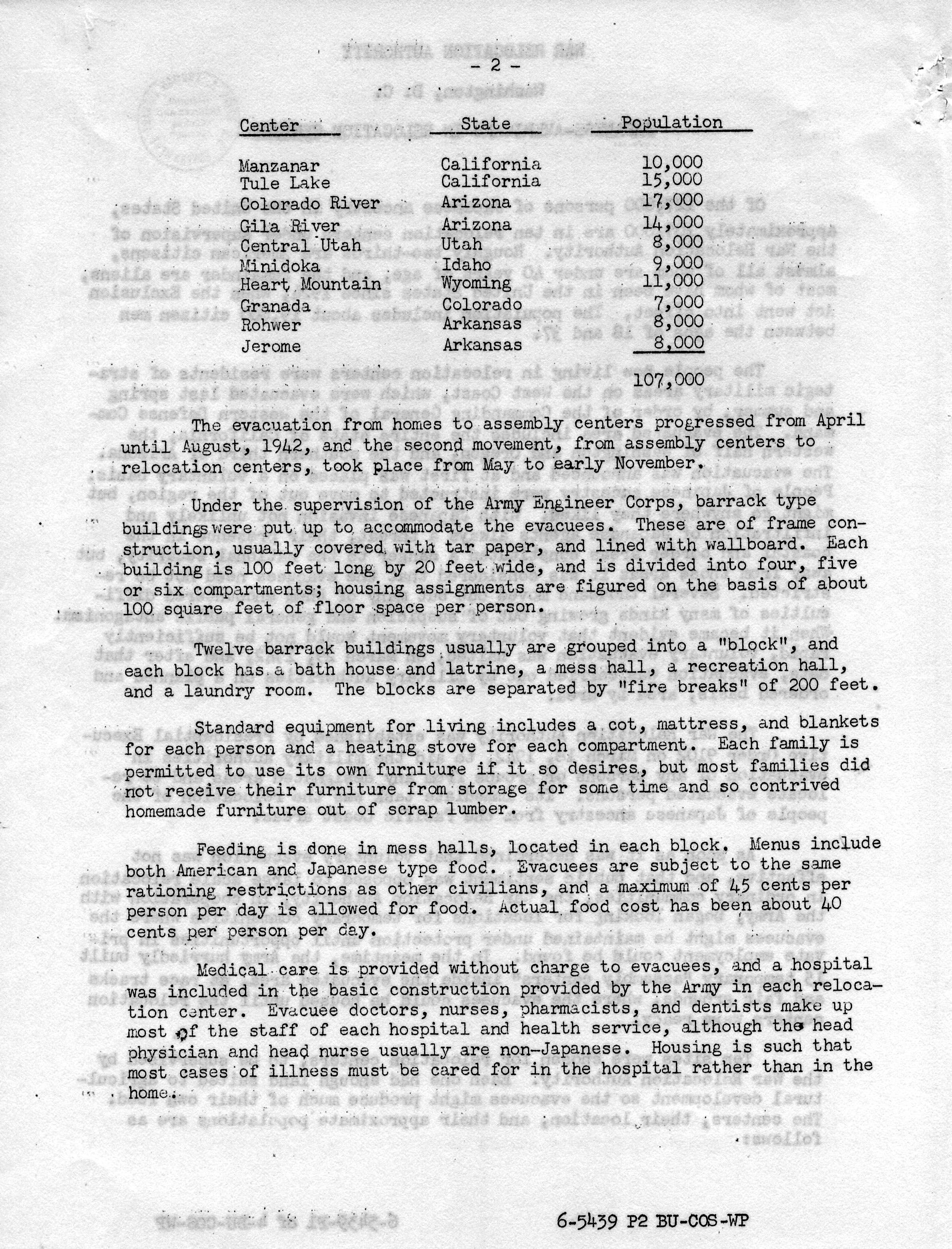
Report on Japanese-Americans in Relocation Centers
Page 3
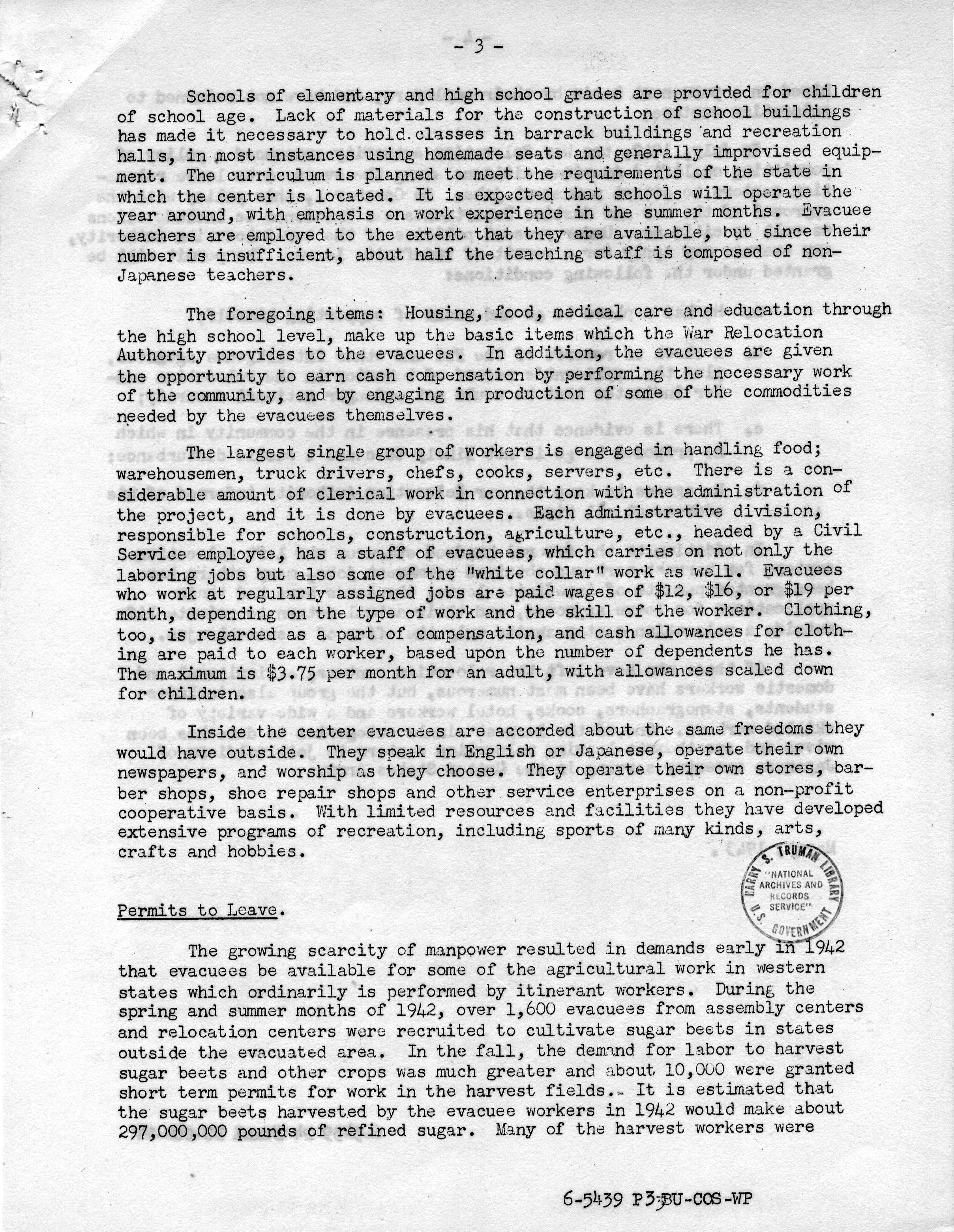
Report on Japanese-Americans in Relocation Centers
Page 4

Document
Eden, Idaho. Baggage, belonging to evacuees from the assembly center at Puyallup, Washington is sorted.
8/17/1942
The original caption for this photograph, taken by War Relocation Authority photographer Francis Stewart, reads: Eden, Idaho. Baggage, belonging to evacuees from the assembly center at Puyallup, Washington, is sorted and trucked to owners in their barrack apartments.
This primary source comes from the Records of the War Relocation Authority.
National Archives Identifier: 538278
Full Citation: Photograph 210-G-D87; Eden, Idaho. Baggage, belonging to evacuees from the assembly center at Puyallup, Washington is sorted. ; 8/17/1942; Central Photographic File of the War Relocation Authority, 1942 - 1945; Records of the War Relocation Authority, ; National Archives at College Park, College Park, MD. [Online Version, https://www.docsteach.org/documents/document/eden-idaho-baggage, April 19, 2024]Eden, Idaho. Baggage, belonging to evacuees from the assembly center at Puyallup, Washington is sorted.
Page 1
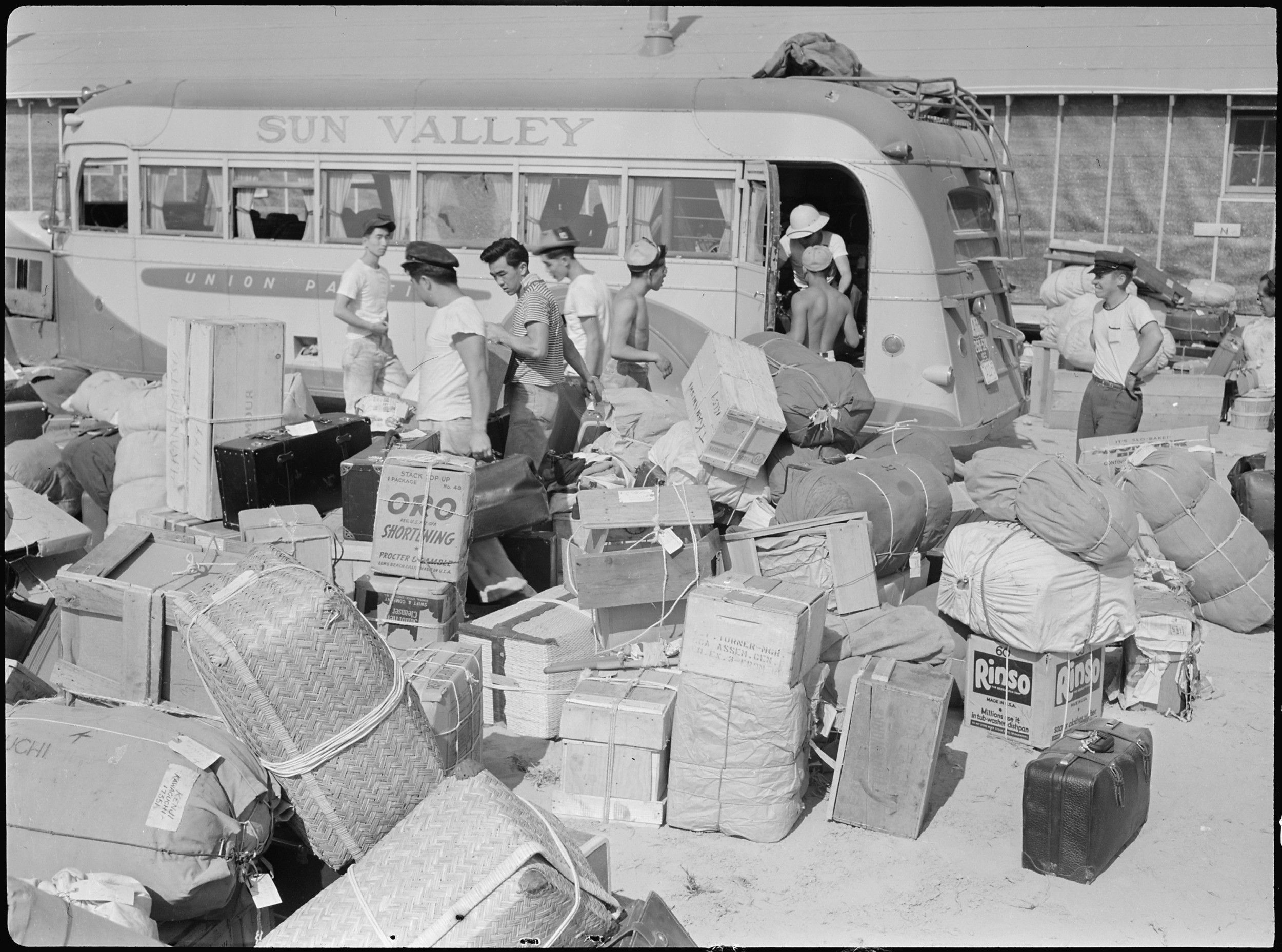
Document
Topaz, Utah. A panorama view of the Central Utah Relocation Center, taken from the water tower.
3/14/1943
The original caption for this photograph, taken by a War Relocation Authority photographer, reads: Topaz, Utah. A panorama view of the Central Utah Relocation Center, taken from the water tower.
This primary source comes from the Records of the War Relocation Authority.
National Archives Identifier: 536976
Full Citation: Photograph 210-G-B281; Topaz, Utah. A panorama view of the Central Utah Relocation Center, taken from the water tower.; 3/14/1943; Central Photographic File of the War Relocation Authority, 1942 - 1945; Records of the War Relocation Authority, ; National Archives at College Park, College Park, MD. [Online Version, https://www.docsteach.org/documents/document/topaz-relocation-center, April 19, 2024]Topaz, Utah. A panorama view of the Central Utah Relocation Center, taken from the water tower.
Page 1
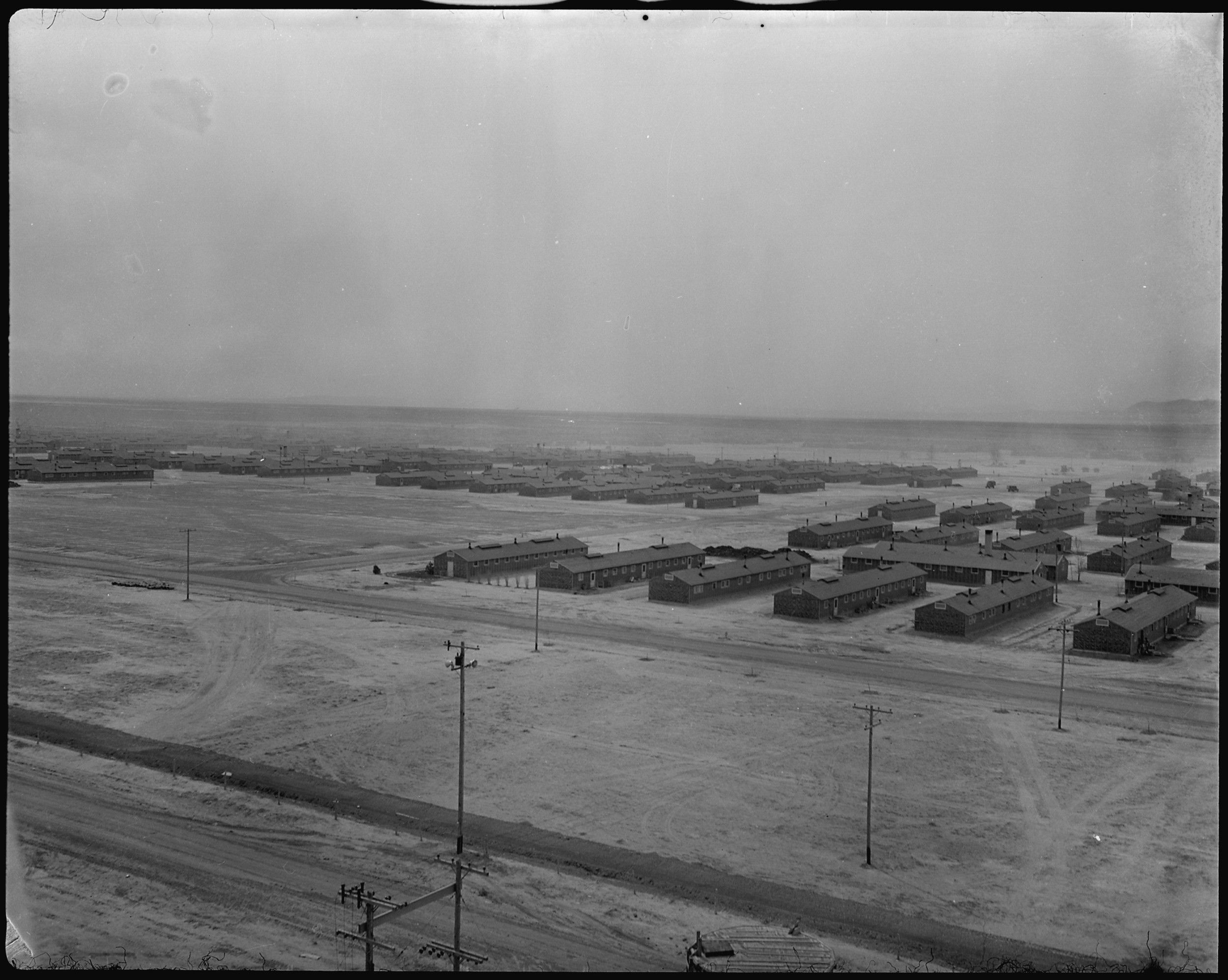
Document
Poston, Arizona. Mosaru Oshio with his children on the steps of his barrack home at this War Relocation Authority center for evacuees of Japanese ancestry.
6/1/1942
During World War II, Japanese Americans were targeted and detained at internment camps, including the Colorado River Relocation Center in Poston, Arizona (also known as the Poston War Relocation Center).
The original caption for this photograph reads: Poston, Arizona. Mosaru Oshio with his children on the steps of his barrack home at this War Relocation Authority center for evacuees of Japanese ancestry.
The original caption for this photograph reads: Poston, Arizona. Mosaru Oshio with his children on the steps of his barrack home at this War Relocation Authority center for evacuees of Japanese ancestry.
This primary source comes from the Records of the War Relocation Authority.
National Archives Identifier: 536155
Full Citation: Photograph 210-G-A193; Poston, Arizona. Mosaru Oshio with his children on the steps of his barrack home at this War Relocation Authority center for evacuees of Japanese ancestry.; 6/1/1942; Central Photographic File of the War Relocation Authority, 1942 - 1945; Records of the War Relocation Authority, ; National Archives at College Park, College Park, MD. [Online Version, https://www.docsteach.org/documents/document/oshio-family-poston, April 19, 2024]Poston, Arizona. Mosaru Oshio with his children on the steps of his barrack home at this War Relocation Authority center for evacuees of Japanese ancestry.
Page 1
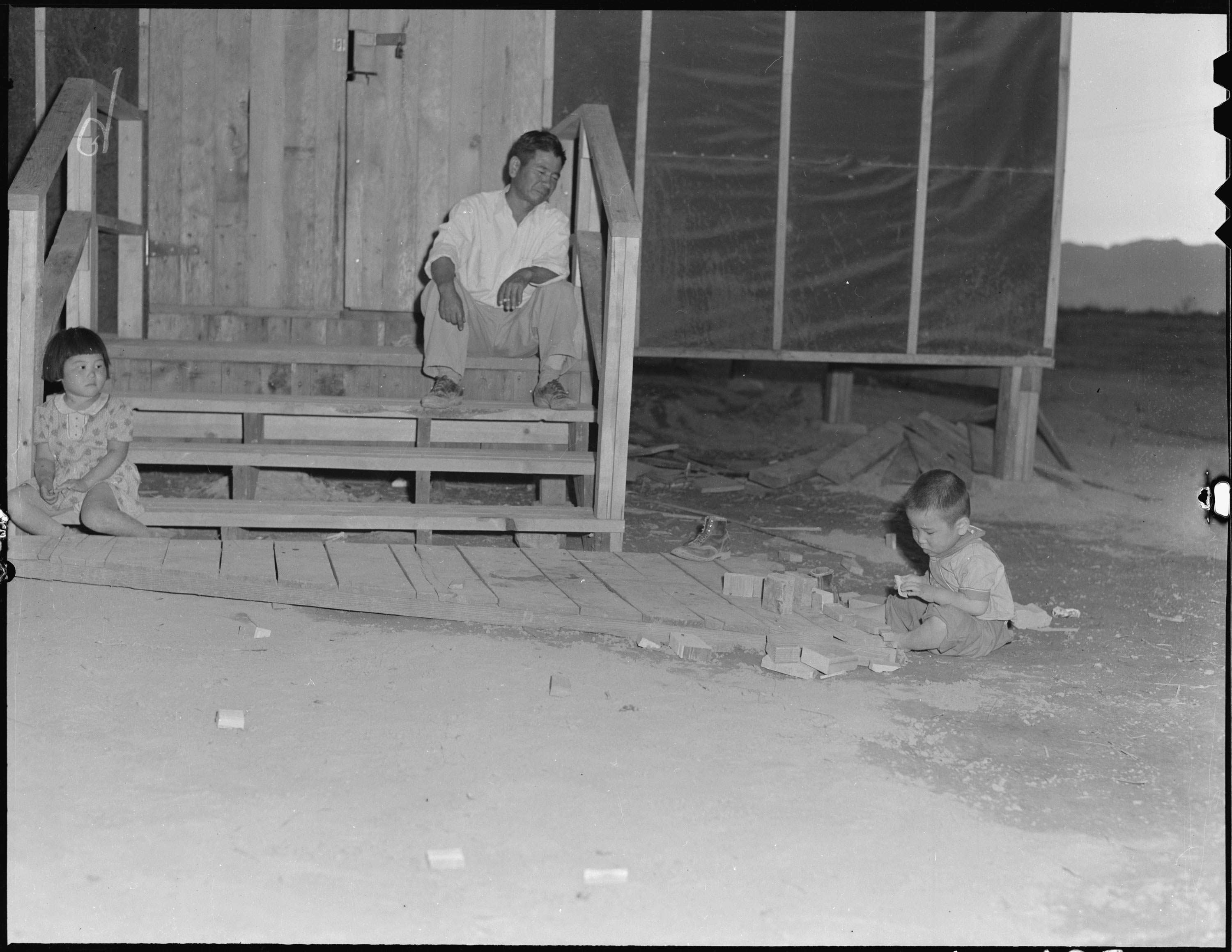
Document
Manzanar Relocation Center, Manzanar, California. An elementary school with voluntary attendance has been established with volunteer evacuee teachers, most of whom are college graduates.
7/1/1942
The original caption for this photograph, taken by photographer Dorothea Lange, reads: Manzanar Relocation Center, Manzanar, California. An elementary school with voluntary attendance has been established with volunteer evacuee teachers, most of whom are college graduates. No school equipment is as yet obtainable and available tables and benches are used. However, classes are often held in the shade of the barrack building at this War Relocation Authority center.
This primary source comes from the Records of the War Relocation Authority.
National Archives Identifier: 537962
Full Citation: Photograph 210-G-C665; Manzanar Relocation Center, Manzanar, California. An elementary school with voluntary attendance has been established with volunteer evacuee teachers, most of whom are college graduates. ; 7/1/1942; Central Photographic File of the War Relocation Authority, 1942 - 1945; Records of the War Relocation Authority, ; National Archives at College Park, College Park, MD. [Online Version, https://www.docsteach.org/documents/document/school-children-manzanar, April 19, 2024]Manzanar Relocation Center, Manzanar, California. An elementary school with voluntary attendance has been established with volunteer evacuee teachers, most of whom are college graduates.
Page 1

Document
Poston, Arizona. Cheiko Neeno, nurse's aid student at th Poston Hospital, attending a baby patient in the children's ward. These nurse's aid students are taught to efficiently assist Registered Nurses in the care and treatment of patients. The course
5/3/1943
During World War II, Japanese Americans were targeted and detained at internment camps, including the Colorado River Relocation Center in Poston, Arizona (also known as the Poston War Relocation Center).
The original caption for this photograph reads: Poston, Arizona. Cheiko Neeno, nurse's aid student at the Poston Hospital, attending a baby patient in the children's ward. These nurse's aid students are taught to efficiently assist Registered Nurses in the care and treatment of patients. The course consists of one year's intensive training.
The original caption for this photograph reads: Poston, Arizona. Cheiko Neeno, nurse's aid student at the Poston Hospital, attending a baby patient in the children's ward. These nurse's aid students are taught to efficiently assist Registered Nurses in the care and treatment of patients. The course consists of one year's intensive training.
This primary source comes from the Records of the War Relocation Authority.
National Archives Identifier: 537102
Full Citation: Photograph 210-G-B494; Poston, Arizona. Cheiko Neeno, nurse's aid student at th Poston Hospital, attending a baby patient in the children's ward. These nurse's aid students are taught to efficiently assist Registered Nurses in the care and treatment of patients. The course; 5/3/1943; Central Photographic File of the War Relocation Authority, 1942 - 1945; Records of the War Relocation Authority, ; National Archives at College Park, College Park, MD. [Online Version, https://www.docsteach.org/documents/document/nurses-aid-poston-hospital, April 19, 2024]Poston, Arizona. Cheiko Neeno, nurse's aid student at th Poston Hospital, attending a baby patient in the children's ward. These nurse's aid students are taught to efficiently assist Registered Nurses in the care and treatment of patients. The course
Page 1
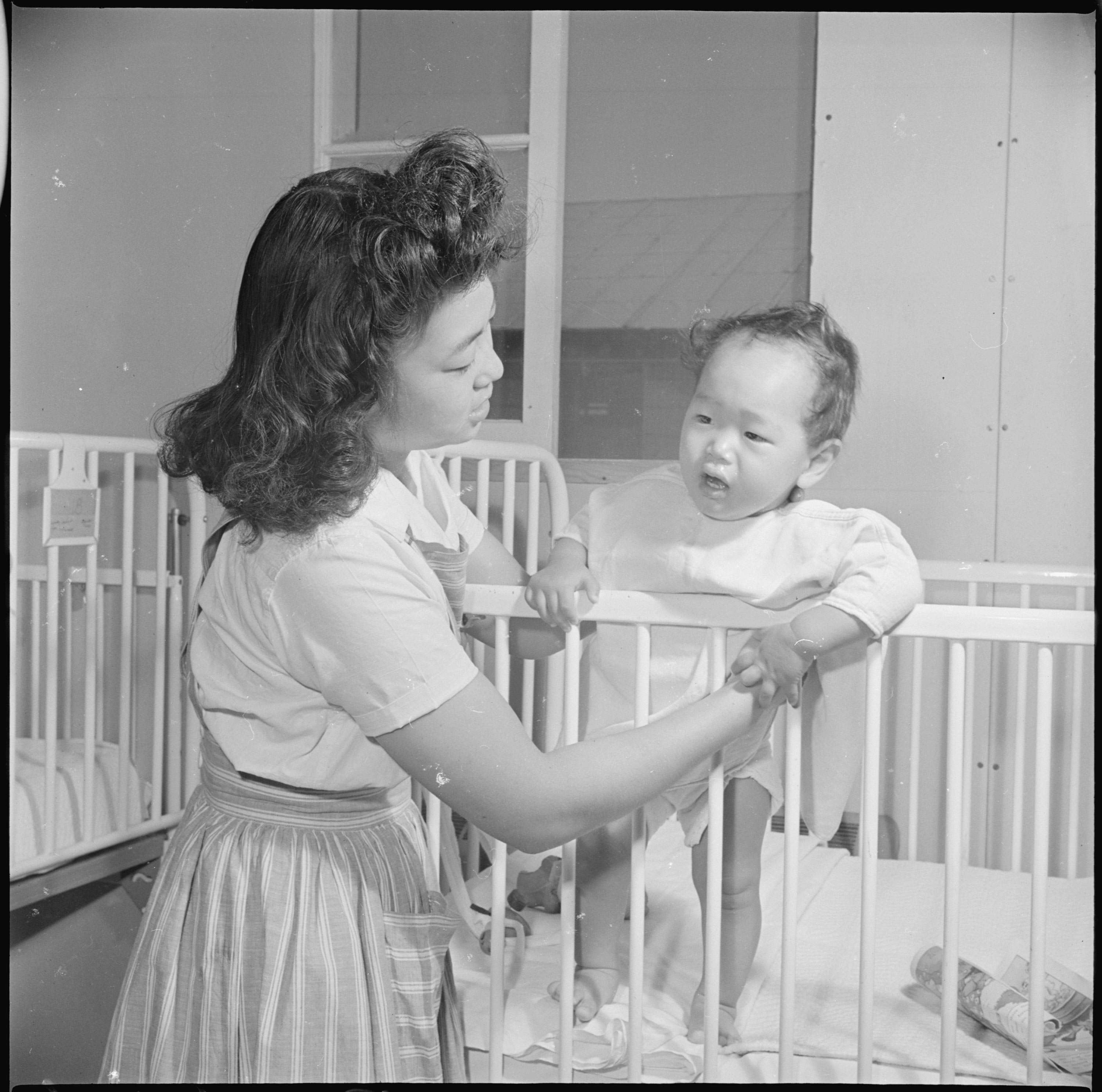
Document
Tule Lake Relocation Center, Newell, California. A view in the lunch shed at the farm.
9/8/1942
The original caption for this photograph, taken by a War Relocation Authority photographer, reads: Tule Lake Relocation Center, Newell, California. A view in the lunch shed at the farm. Trucks from the kitchens bring hot lunches to the workers.
This primary source comes from the Records of the War Relocation Authority.
National Archives Identifier: 538333
Full Citation: Photograph 210-G-D142; Tule Lake Relocation Center, Newell, California. A view in the lunch shed at the farm.; 9/8/1942; Central Photographic File of the War Relocation Authority, 1942 - 1945; Records of the War Relocation Authority, ; National Archives at College Park, College Park, MD. [Online Version, https://www.docsteach.org/documents/document/tule-lake-lunch-shed, April 19, 2024]Tule Lake Relocation Center, Newell, California. A view in the lunch shed at the farm.
Page 1
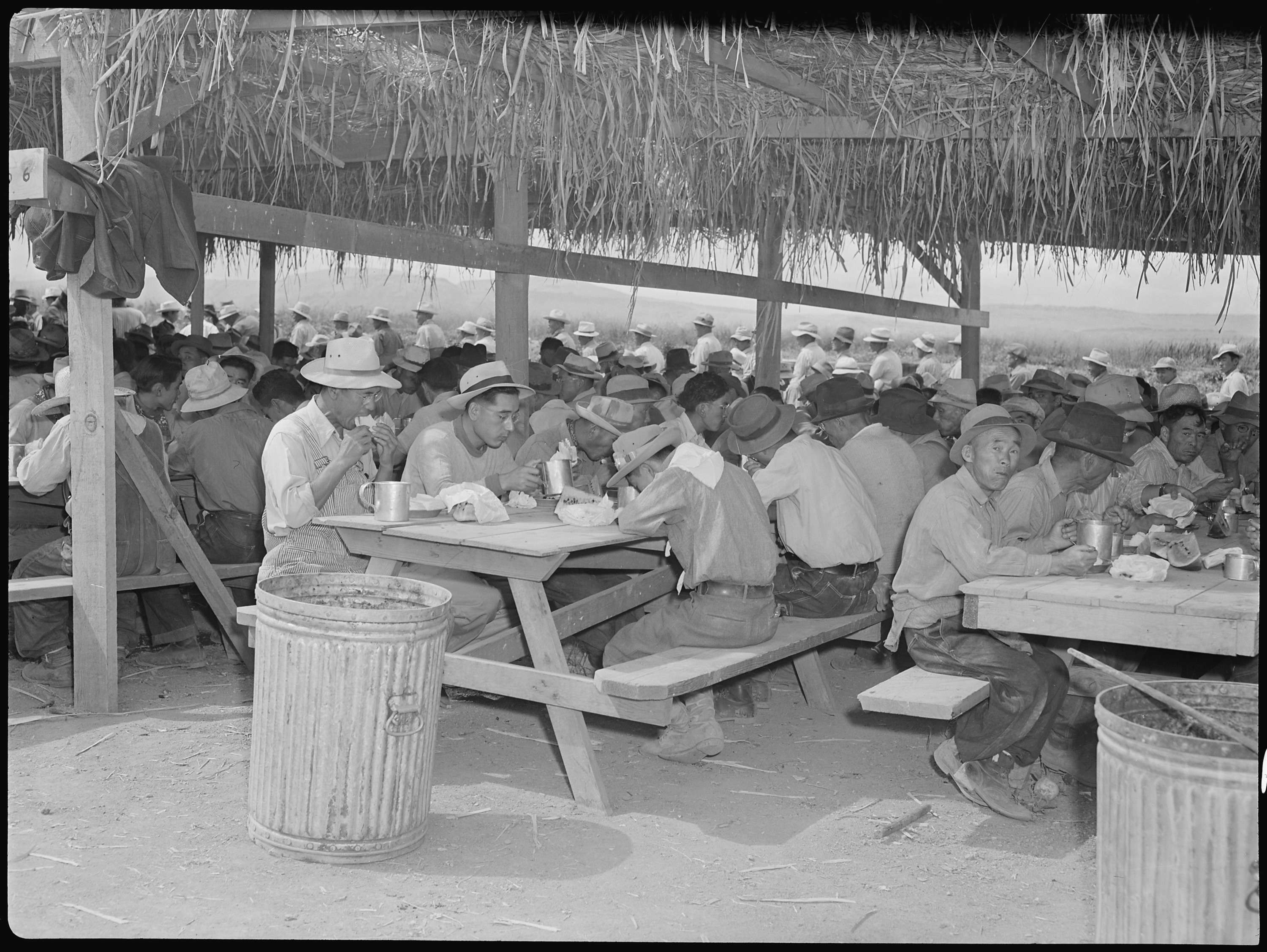
Document
Manzanar Relocation Center, Manzanar, California. Baseball is the most popular recreation at this War Relocation Authority center...
7/02/1942
The original caption for this photograph, taken by photographer Dorothea Lange for the War Relocation Authority, reads: "Baseball is the most popular recreation at this War Relocation Authority center with 80 teams having been formed throughout the Center. Most of the playing is done between the barrack blocks."
This primary source comes from the Records of the War Relocation Authority.
National Archives Identifier: 538064
Full Citation: Photograph 210-G-C771; Manzanar Relocation Center, Manzanar, California. Baseball is the most popular recreation at this War Relocation Authority center...; 7/02/1942; Central Photographic File of the War Relocation Authority, 1942 - 1945; Records of the War Relocation Authority, ; National Archives at College Park, College Park, MD. [Online Version, https://www.docsteach.org/documents/document/baseball-manzanar, April 19, 2024]Manzanar Relocation Center, Manzanar, California. Baseball is the most popular recreation at this War Relocation Authority center...
Page 1
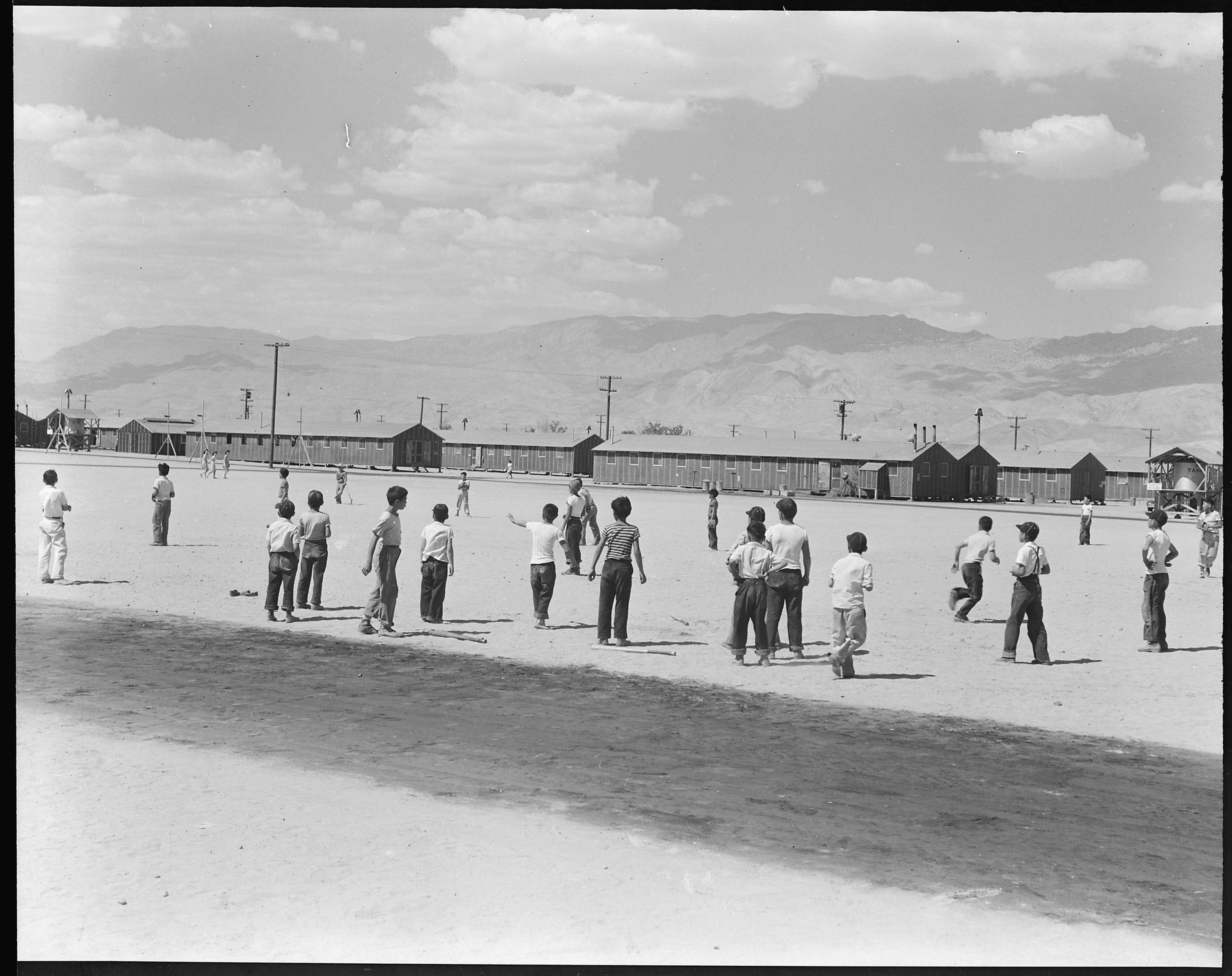
Document
Heart Mountain Relocation Center, Heart Mountain, Wyoming. It takes approximately four carloads of coal a day to provide heat.
9/15/1942
The original caption for this photograph, taken by photographer Tom Parker, reads: Heart Mountain Relocation Center, Heart Mountain, Wyoming. It takes approximately four carloads of coal a day to provide heat for residents at this Wyoming relocation center during the cold winter months. Here a crew of men loading trucks from the coal gondola for delivery to barracks.
This primary source comes from the Records of the War Relocation Authority.
National Archives Identifier: 538770
Full Citation: Photograph 210-G-E107; Heart Mountain Relocation Center, Heart Mountain, Wyoming. It takes approximately four carloads of coal a day to provide heat. ; 9/15/1942; Central Photographic File of the War Relocation Authority, 1942 - 1945; Records of the War Relocation Authority, ; National Archives at College Park, College Park, MD. [Online Version, https://www.docsteach.org/documents/document/coal-heart-mountain, April 19, 2024]Heart Mountain Relocation Center, Heart Mountain, Wyoming. It takes approximately four carloads of coal a day to provide heat.
Page 1
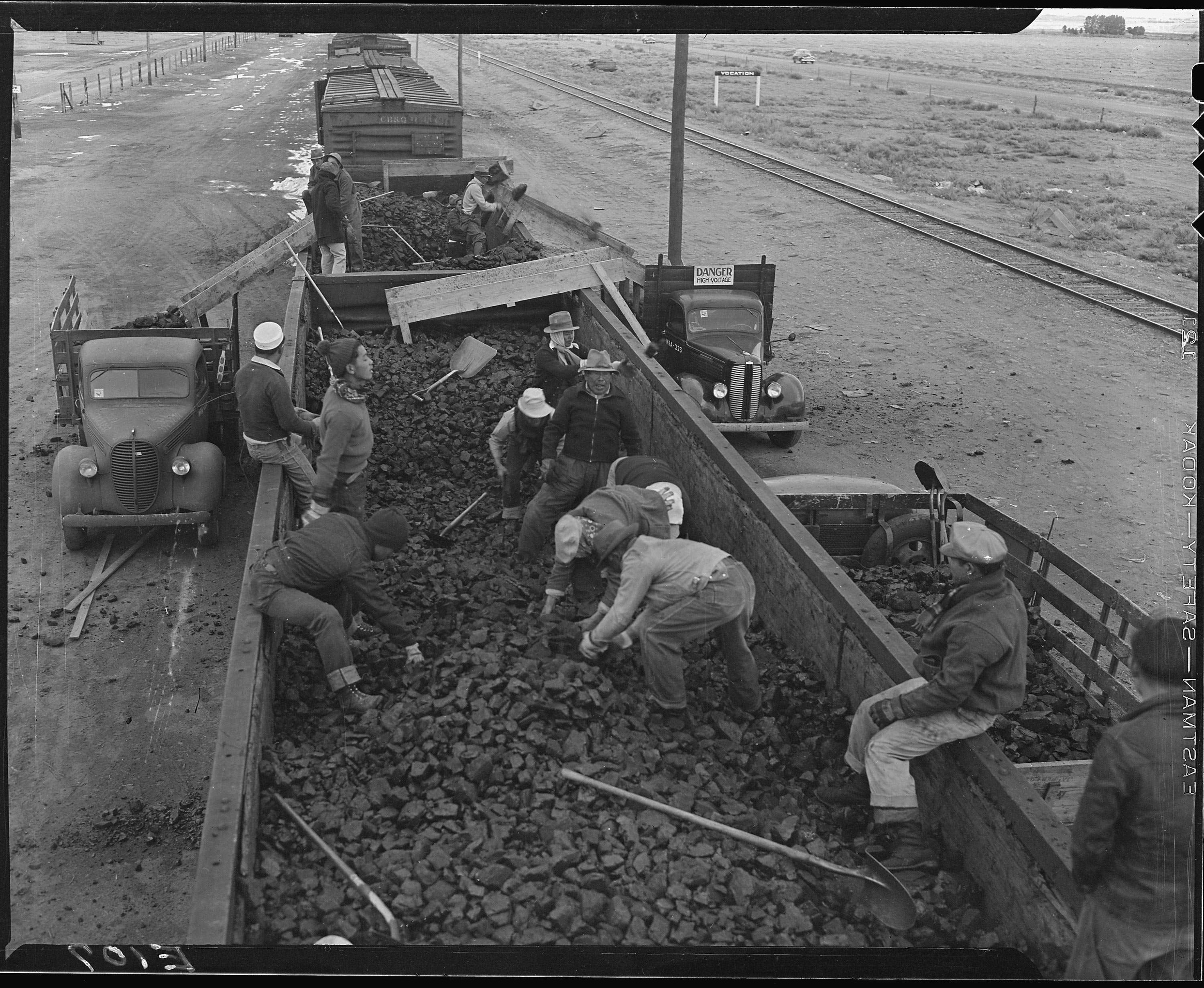
Document
Heart Mountain Relocation Center, Heart Mountain, Wyoming. The poster crew at this relocation center.
9/14/1942
The original caption for this photograph, taken by photographer Tom Parker, reads: Heart Mountain Relocation Center, Heart Mountain, Wyoming. The poster crew at this relocation center, turning out fire and safety posters, announcements for public gatherings, dances and some general instructions.
This primary source comes from the Records of the War Relocation Authority.
National Archives Identifier: 538754
Full Citation: Photograph 210-G-E91; Heart Mountain Relocation Center, Heart Mountain, Wyoming. The poster crew at this relocation center.; 9/14/1942; Central Photographic File of the War Relocation Authority, 1942 - 1945; Records of the War Relocation Authority, ; National Archives at College Park, College Park, MD. [Online Version, https://www.docsteach.org/documents/document/heart-mountain-relocation-center-poster-crew, April 19, 2024]Heart Mountain Relocation Center, Heart Mountain, Wyoming. The poster crew at this relocation center.
Page 1

Document
San Bruno, California. Entering Recreational Hall where election is being held for Councilman...
6/16/1942
The civil rights of Japanese immigrants and Japanese-descended U.S. citizens were violated when they were forcibly moved first to "assembly centers" and then to "relocation centers" (also known as "internment camps") during World War II. Nevertheless, all male and female adult internees were allowed to vote for camp advisory council at the Tanforan Assembly Center—a first for immigrants from Japan, who generally lacked voting rights because they could not naturalize and become American citizens. After World War II, citizenship and voting rights gradually opened to Asian immigrants.
The original caption for this image, taken by photographer Dorothea Lange for the War Relocation Authority, reads: San Bruno, California. Entering Recreational Hall where election is being held for Councilman. A general election for five members of the Tanforan Assembly Center Advisory Council is being held on this day. The Issei have never been able to vote before because of American naturalization laws.
The original caption for this image, taken by photographer Dorothea Lange for the War Relocation Authority, reads: San Bruno, California. Entering Recreational Hall where election is being held for Councilman. A general election for five members of the Tanforan Assembly Center Advisory Council is being held on this day. The Issei have never been able to vote before because of American naturalization laws.
This primary source comes from the Records of the War Relocation Authority.
National Archives Identifier: 537899
Full Citation: Photograph 210-G-C592; San Bruno, California. Entering Recreational Hall where election is being held for Councilman...; 6/16/1942; Central Photographic File of the War Relocation Authority, 1942 - 1945; Records of the War Relocation Authority, ; National Archives at College Park, College Park, MD. [Online Version, https://www.docsteach.org/documents/document/tanforan-vote, April 19, 2024]San Bruno, California. Entering Recreational Hall where election is being held for Councilman...
Page 1
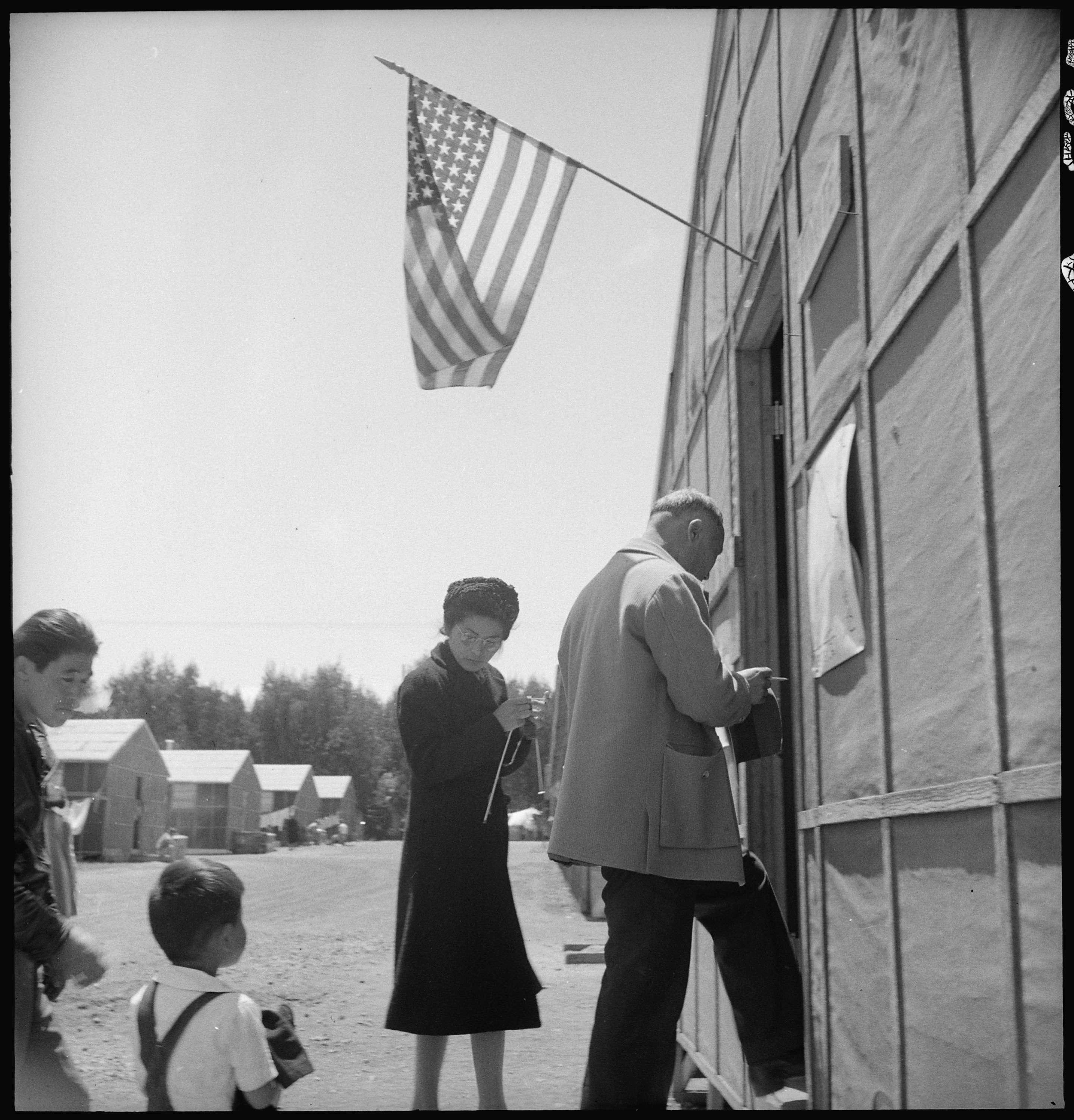
Document
Heart Mountain Relocation Center, Heart Mountain, Wyoming. A session of the court.
6/4/1943
The original caption for this photograph reads: Heart Mountain Relocation Center Heart Mountain, Wyoming. A session of the court at the Heart Mountain Relocation Center. The court is composed of seven judges selected from the residents and appointed by the Project Director. They preside over infractions of center regulations and ordinary civil court cases.
This primary source comes from the Records of the War Relocation Authority.
National Archives Identifier: 537166
Full Citation: Photograph 210-G-B571; Heart Mountain Relocation Center, Heart Mountain, Wyoming. A session of the court. ; 6/4/1943; Central Photographic File of the War Relocation Authority, 1942 - 1945; Records of the War Relocation Authority, ; National Archives at College Park, College Park, MD. [Online Version, https://www.docsteach.org/documents/document/heart-mountain-court, April 19, 2024]Heart Mountain Relocation Center, Heart Mountain, Wyoming. A session of the court.
Page 1
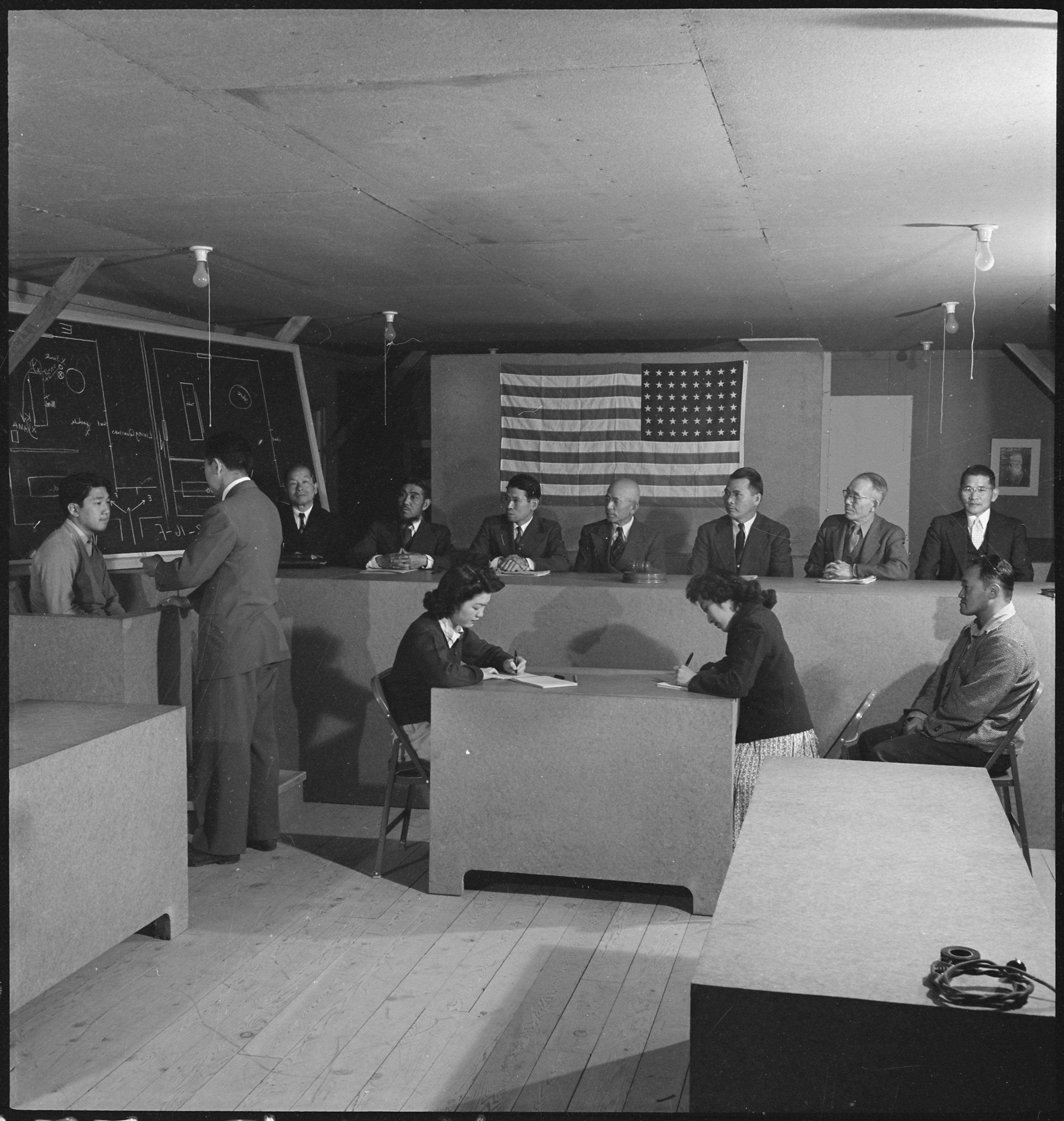
Document
Constitutional Principles Involved in the Relocation Program
7/7/1943
This is a statement by Dillon S. Myer, director of the War Relocation Authority, before a subcommittee of the House Committee on Un-American Activities.
This document was identified by teachers in our Primarily Teaching 2016 Summer Workshop at the Truman Library.
This document was identified by teachers in our Primarily Teaching 2016 Summer Workshop at the Truman Library.
This primary source comes from the Collection HST-DSM: Dillon S. Myer Papers.
National Archives Identifier: 40020128
Full Citation: Constitutional Principles Involved in the Relocation Program; 7/7/1943; 1943-1945-War Relocation Authority, Speeches [1 of 3]; Government Agencies Files; Collection HST-DSM: Dillon S. Myer Papers, ; Harry S. Truman Library, Independence, MO. [Online Version, https://www.docsteach.org/documents/document/constitutional-principles-involved-relocation-program, April 19, 2024]Constitutional Principles Involved in the Relocation Program
Page 1
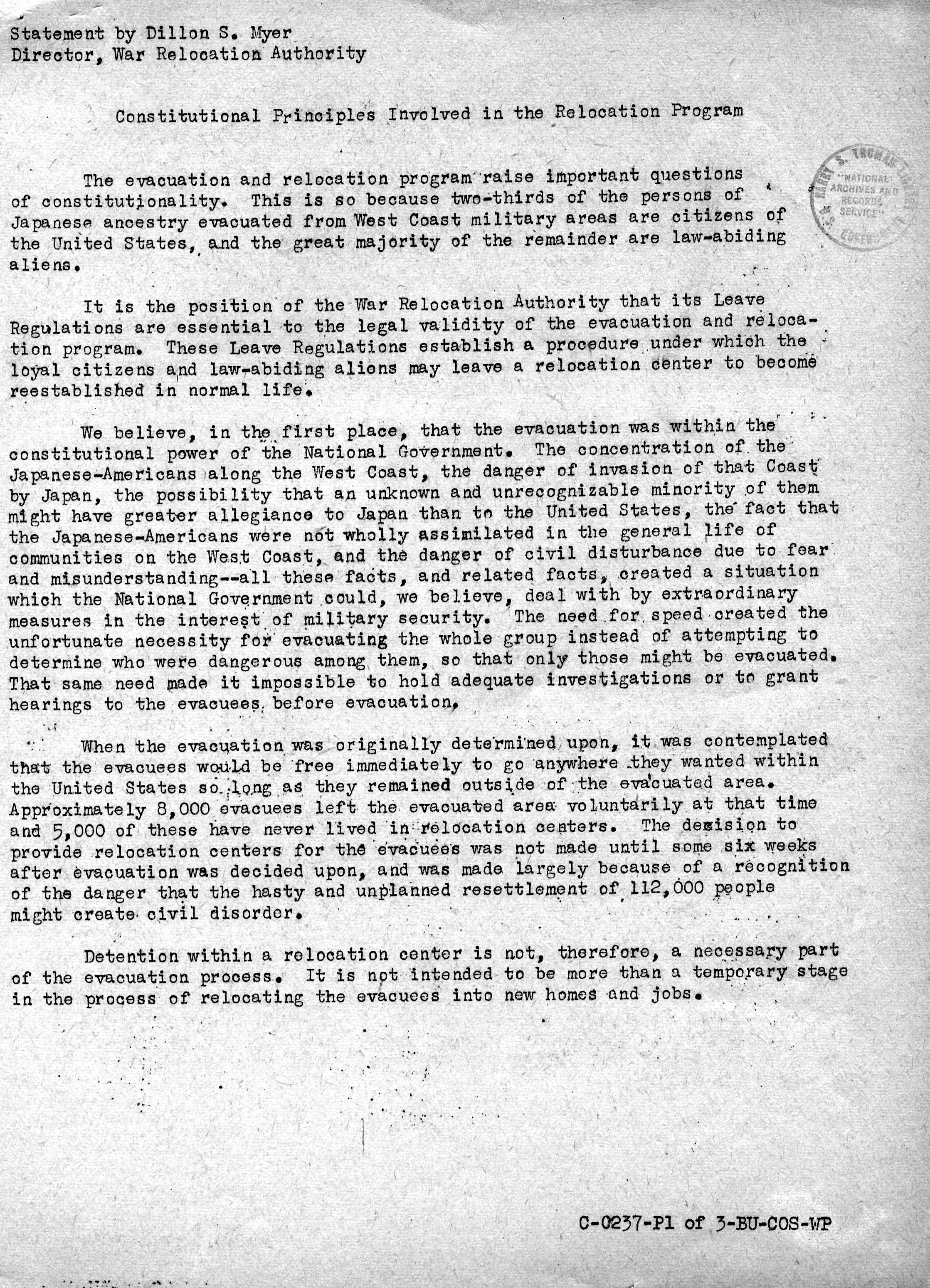
Constitutional Principles Involved in the Relocation Program
Page 2
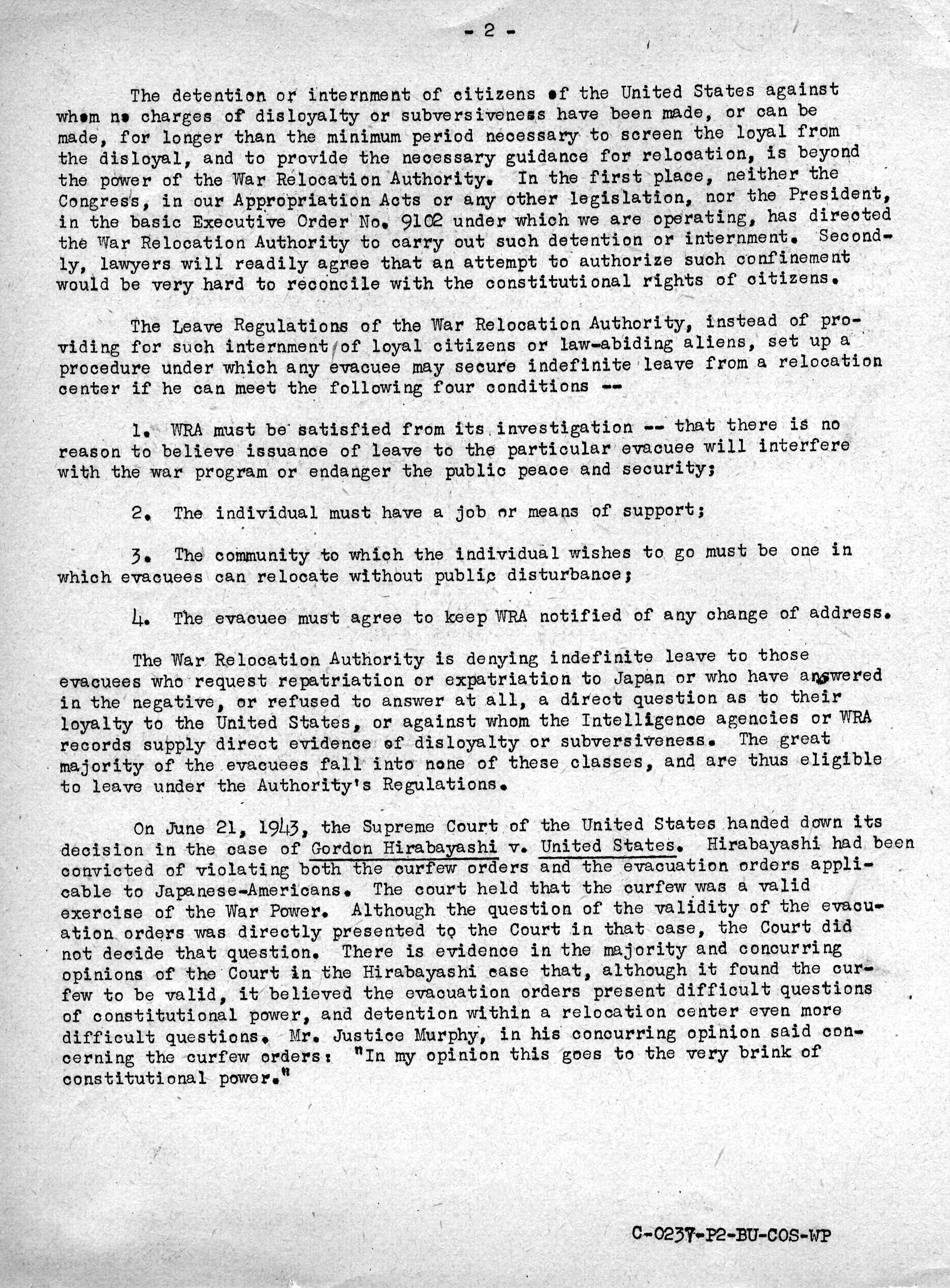
Constitutional Principles Involved in the Relocation Program
Page 3
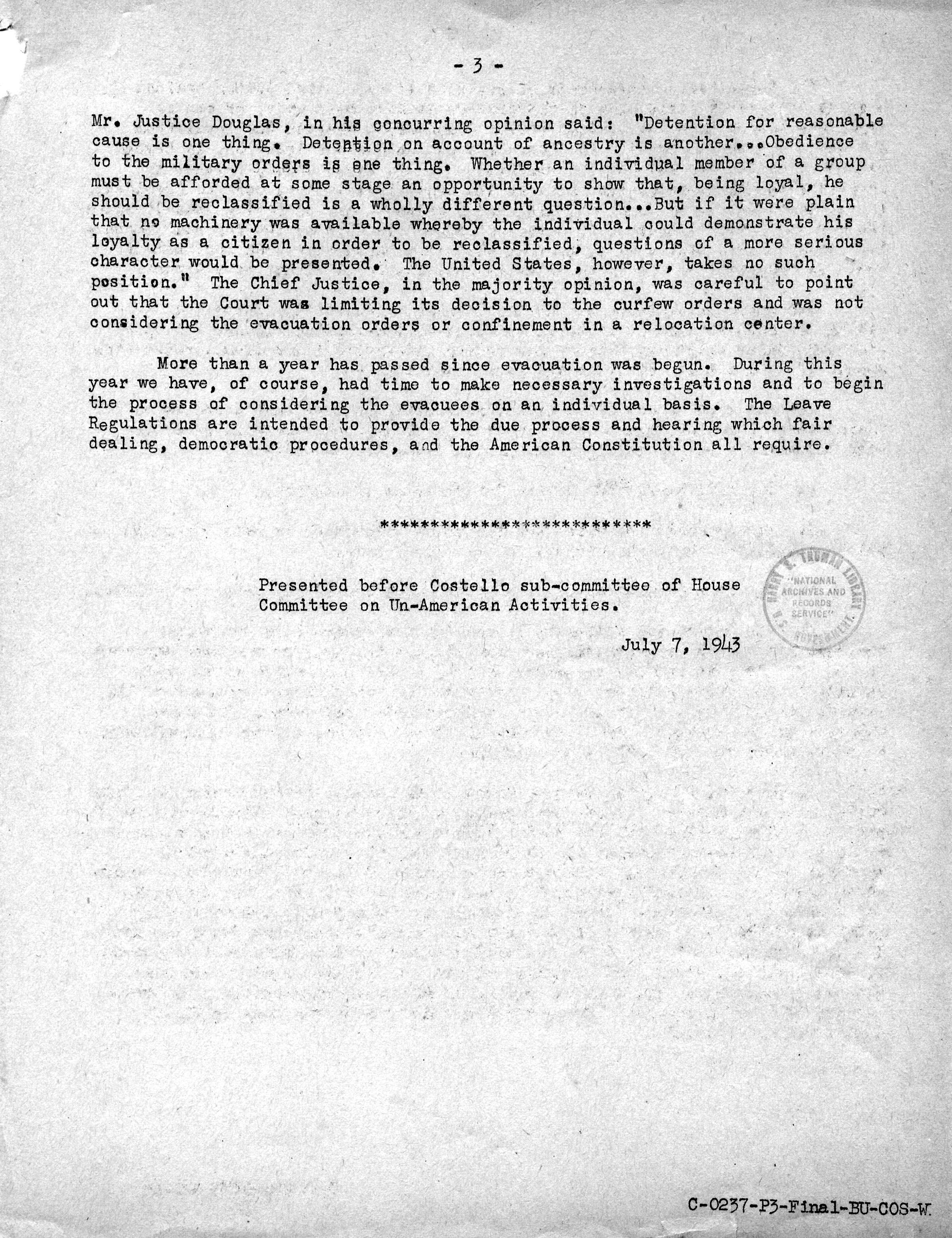
Document
Letter to Mr. Paul T. Bannai, Executive Director of the Commission on Wartime Relocation and Internment of Civilians, from John McCloy
7/24/1981
In 1980, Congress appointed a Commission on Wartime Relocation and Internment of Civilians to conduct an official study into Japanese-American internment during World War II. John McCloy, Assistant Secretary of War during World War II, sent this letter to Mr. Paul T. Bannai, executive director of the commission, expressing his willingness to testify regarding the "relocation" program.
McCloy wrote that "it is important to keep in mind it was a relocation program and not an internment or punitive measure." And "I hope the Commission will find, as I believe to be the case, that the whole operation was as benignly conducted as wartime conditions permitted....[that] the action of the President of the United States and the United States Government in regard to our then Japanese population was reasonably undertaken and thoughtfully and humanely conducted."
This document was digitized by teachers in our Primarily Teaching 2013 Summer Workshop in Washington, DC.
McCloy wrote that "it is important to keep in mind it was a relocation program and not an internment or punitive measure." And "I hope the Commission will find, as I believe to be the case, that the whole operation was as benignly conducted as wartime conditions permitted....[that] the action of the President of the United States and the United States Government in regard to our then Japanese population was reasonably undertaken and thoughtfully and humanely conducted."
This document was digitized by teachers in our Primarily Teaching 2013 Summer Workshop in Washington, DC.
This primary source comes from the Records of Temporary Committees, Commissions, and Boards.
National Archives Identifier: 29915382
Full Citation: Letter to Mr. Paul T. Bannai, Executive Director of the Commission on Wartime Relocation and Internment of Civilians, from John McCloy; 7/24/1981; McCloy, John, 1981 - 1983; Numerical Files, 1981 - 1983; Records of Temporary Committees, Commissions, and Boards, ; National Archives at College Park, College Park, MD. [Online Version, https://www.docsteach.org/documents/document/letter-to-bannai, April 19, 2024]Letter to Mr. Paul T. Bannai, Executive Director of the Commission on Wartime Relocation and Internment of Civilians, from John McCloy
Page 1

Letter to Mr. Paul T. Bannai, Executive Director of the Commission on Wartime Relocation and Internment of Civilians, from John McCloy
Page 2

Letter to Mr. Paul T. Bannai, Executive Director of the Commission on Wartime Relocation and Internment of Civilians, from John McCloy
Page 3

Letter to Mr. Paul T. Bannai, Executive Director of the Commission on Wartime Relocation and Internment of Civilians, from John McCloy
Page 4

Letter to Mr. Paul T. Bannai, Executive Director of the Commission on Wartime Relocation and Internment of Civilians, from John McCloy
Page 5

Document
The Hirano family, left to right, George, Hisa, and Yasbei. Colorado River Relocation Center, Poston, Arizona.
1942 - 1945
This photograph shows Risa and Yasubei Hirano and their son George posed in front of an American flag. Risa is holding a photograph of her son Shigera in uniform. The Hiranos were held at the Colorado River camp, and this image captures both the patriotism and sadness these proud Japanese Americans felt. The photographer is unknown.
The original caption reads: The Hirano family, left to right, George, Hisa, and Yasbei. Colorado River Relocation Center, Poston, Arizona.
The original caption reads: The Hirano family, left to right, George, Hisa, and Yasbei. Colorado River Relocation Center, Poston, Arizona.
This primary source comes from the Records of the War Relocation Authority.
National Archives Identifier: 535989
Full Citation: Photograph 210-CC-S(26C); The Hirano family, left to right, George, Hisa, and Yasbei. Colorado River Relocation Center, Poston, Arizona.; 1942 - 1945; Colorado River Relocation Center, 1942 - 1945; Records of the War Relocation Authority, ; National Archives at College Park, College Park, MD. [Online Version, https://www.docsteach.org/documents/document/hirano-family, April 19, 2024]The Hirano family, left to right, George, Hisa, and Yasbei. Colorado River Relocation Center, Poston, Arizona.
Page 1
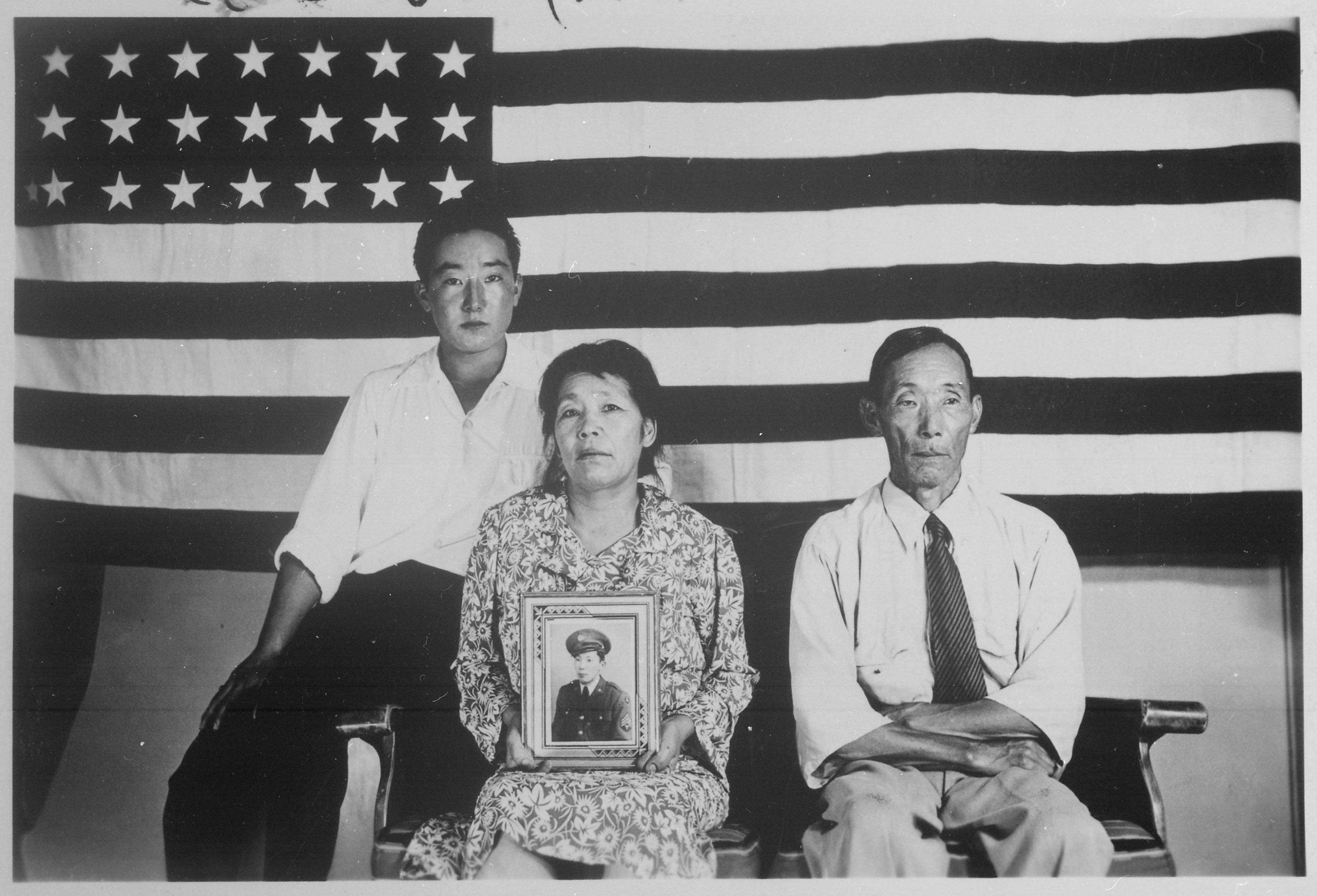
Document
Poston, Arizona. The bus waits outside and young and old are anxious to be off.
9/1945
During World War II, Japanese Americans were targeted and detained at internment camps, including the Colorado River Relocation Center in Poston, Arizona (also known as the Poston War Relocation Center).
The original caption for this photograph reads: Poston, Arizona. The bus waits outside and young and old are anxious to be off. After the final plans have been made, boxes packed, and grants picked up, the residents of Poston are at last ready to leave the center. Now that so many of their friends have gone out before them, it is with a feeling of anticipation rather than sorrow that the evacuees prepare to leave the place which for three years has been home to them.
The original caption for this photograph reads: Poston, Arizona. The bus waits outside and young and old are anxious to be off. After the final plans have been made, boxes packed, and grants picked up, the residents of Poston are at last ready to leave the center. Now that so many of their friends have gone out before them, it is with a feeling of anticipation rather than sorrow that the evacuees prepare to leave the place which for three years has been home to them.
This primary source comes from the Records of the War Relocation Authority.
National Archives Identifier: 539871
Full Citation: Photograph 210-G-K349; Poston, Arizona. The bus waits outside and young and old are anxious to be off.; 9/1945; Central Photographic File of the War Relocation Authority, 1942 - 1945; Records of the War Relocation Authority, ; National Archives at College Park, College Park, MD. [Online Version, https://www.docsteach.org/documents/document/waiting-poston, April 19, 2024]Poston, Arizona. The bus waits outside and young and old are anxious to be off.
Page 1
